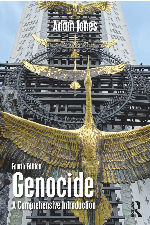Afghanistan
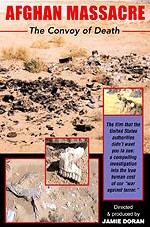 Afghan Massacre: The Convoy of Death (documentary, 2003)
Afghan Massacre: The Convoy of Death (documentary, 2003)
Follow the link to watch the documentary on the Democracy Now! website, using RealPlayer. "Produced and directed by Irish filmmaker and former BBC producer Jamie Doran, the film tells the story of thousands of prisoners who surrendered to the US military's Afghan allies after the siege of Kunduz. According to the film, some three thousand of the prisoners were forced into sealed containers and loaded onto trucks for transport to Sheberghan prison. ... Witnesses say that when the trucks arrived and soldiers opened the containers, most of the people inside were dead."
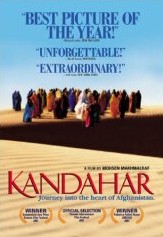 Kandahar (2001, 85 mins.)
Kandahar (2001, 85 mins.)
"Nafas (Niloufar Pazira) is a reporter who was born in Afghanistan, but fled with her family to Canada when she was a child. However, her sister wasn't so lucky; she lost her legs to a land mine while young, and when Nafas and her family left the country, her sister was accidentally left behind. Nafas receives a letter from her sister announcing that she's decided to commit suicide during the final eclipse before the dawn of the 21st century; desperate to spare her sister's life, Nafas makes haste to Afghanistan, where she joins a caravan of refugees who, for a variety of reasons, are returning to the war-torn nation. As Nafas searches for her sister, she soon gets a clear and disturbing portrait of the toll the Taliban regime has taken upon its people." (From the Amazon.com description)
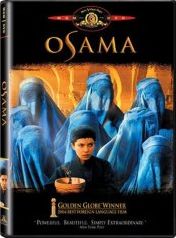 Osama (2003, 83 mins.)
Osama (2003, 83 mins.)
Winner of the Golden Globe for Best Foreign Language Film. "The first movie produced by Afghanistan filmmakers after the fall of the Taliban, Osama is a searing portrait of life under the oppressive fundamentalist regime. Because women are not allowed to work, a widow disguises her young daughter (Marina Golbahari) as a boy so they won't starve to death. Simply walking the streets is frightening enough, but when the disguised girl is rounded up with all the boys in the town for religious training, her peril becomes absolutely harrowing. Golbahari's face -- beautiful but taut with terror -- is riveting. The movie captures both her plight and the miseries of daily life in spare, vivid images. At one point, her mother is nearly killed for exposing her feet while riding on the back of a bicycle; for the entire scene, the camera shows only her feet, with the spokes of the wheel radiating out behind as she lowers her burka over them." (Bret Fetzer)
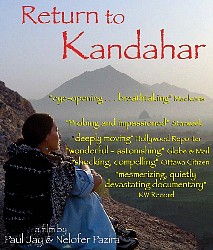 Return to Kandahar (documentary, 2003, 65 mins.)
Return to Kandahar (documentary, 2003, 65 mins.)
"Nelofer Pazira, the star of the movie Kandahar, returns to her native Afghanistan. In the hope of tracking down her childhood friend Dyana -- whose story inspired the feature film -- Nelofer travels to the city of Kabul, Kandahar and Mazar-e-Sharif. Landing in Kabul, after 13 years, Nelofer unravels her past and the unfolding of history in her country while searching for Dyana." (From the website description)
"This internationally acclaimed film was banned by the French government for its realistic portrayal of the vicious battle for independence fought by the Algerian resistance fighters in the 1950s. This film is considered a classic for its documentary style of storytelling. It contains a prescient scene of Algerian women planting a bomb in a popular cafe." (Encyclopedia of Genocide and Crimes against Humanity) The Battle of Algiers is more relevant than ever in the age of the "War on Terror" and renewed debate over the use of torture as a counterinsurgency tool; indeed, it has been required viewing in U.S. Army circles. The three-disc Criterion Collection edition features numerous extras, including interviews and documentaries.
"This 1994 film was adapted from a play by Argentinean playwright Ariel Dorfman and was directed by Roman Polanski. Set in an unnamed South American country, three people are thrown together in an isolated house on a dark and stormy night. The woman, played by Sigourney Weaver is clearly troubled and sad. Her husband, played by Stuart Wilson, is late for dinner. Turns out he had a flat tire and a stranger helped him out. That stranger, who is a doctor, played by Ben Kingsley, soon befriends the husband. The woman thinks the stranger is the man who tortured her while she was a political prisoner many years before. ... Is the doctor really the torturer or an innocent man?" (Linda Linquvic) "This is one of those rare political films that transcend politics with a stirring emotional story. Argentinean first-time director Luis Puenzo tells the story of a strong-willed teacher who tries to learn the true identity of her adopted daughter's father, coming to suspect that he was a political prisoner. Her political awakening is actually an emotional one as well because of her detached persona. Ironically, even though she is a teacher, she doesn't connect with people very well, thinking of history in the most abstract terms. But she learns the painful truth of present-day life. Tautly directed by Puenzo, The Official Story was a 1985 Oscar-winner for Best Foreign Film, with a riveting performance by Norma Aleandro." (Bill Desowitz) North American release of Fernando Solanas's Spanish-language documentary, Memoria del Saqueo. "Social Genocide exposes the systematic despoiling of Argentina, not by a dictator or military junta but by an elected democracy" (Ronnie Scheib, Variety). "Once a very rich country, Argentina found itself in a precarious situation when the government decided to take on the debts of foreign banks in their national debt. The situation didn't improve during the dictatorship of the 1970s. Although the government eventually changed over to a democratic one in the 1980s, an elite group continued to grow rich and the debt continued to rise, with nine million Argentineans living in abject poverty, neglected by their government. But in December 2001, the people of Argentina rose up against the mess that their corrupted leaders had created." (Tribute.ca description)
"This remarkable, intricate movie from Atom Egoyan (The Sweet Hereafter) centers around the making of a film about the genocide of Armenians in Turkey in 1915 -- but this is not a dry, didactic historical re-enactment. Ararat unspools multiple storylines around Ani (Arsinee Khanjian), an art historian hired as a consultant on the film; her son Raffi (David Alpay); his stepsister, with whom Raffi is in love even though she believes that his mother is responsible for her father's suicide; an actor (Elias Koteas) hired to play the Turkish officer who organized the genocide; and a customs officer (Christopher Plummer), who holds Raffi for questioning under suspicion of smuggling heroin. All these characters, combined with the movie within the movie, intertwine in a complex yet powerfully emotional examination of memory (both cultural and personal), loyalty (to one's family, to one's heritage), creativity, and the subjectivity of truth." (Bret Fetzer) "The Armenian Genocide is the complete story of the first Genocide of the 20th century -- when over a million Armenians died at the hands of the Ottoman Turks during World War I. This unprecedented and powerful one-hour documentary, which aired April 17th, 2006 on PBS, was written, directed and produced by Emmy Award-winning producer Andrew Goldberg of Two Cats Productions, in association with Oregon Public Broadcasting. Featuring interviews with the leading experts in the field such as Pulitzer Prize-winning author Samantha Power and New York Times best-selling author, Peter Balakian, this film features never-before-seen historical footage of the events and key players of one of the greatest untold stories of the 20th century. The Armenian Genocide is narrated by Julianna Margulies and includes historical narrations by Ed Harris, Natalie Portman, Laura Linney and Orlando Bloom, among others." (From the Amazon.com description) "Documentary feature examining why genocides keep occurring -- from the Armenian genocide in 1915, to the Holocaust, Bosnia, Rwanda and now Darfur -- through the eyes and music of the Grammy award-winning rock band 'System of a Down,' based in Los Angeles, whose members are all grandchildren of genocide survivors. As the band tours the world and touches on the locations and stories of genocide in the last century, the film follows the personal story of the lead singer's grandfather, a 96-year old survivor of the Armenian genocide, one of the few remaining survivors from his village in Turkey. With the arguments of Harvard Professor Samantha Power, the personal stories of survivors from Armenia, Rwanda and Darfur, policy critics and whistleblowers –- the 'screamers' -- the film targets the problem of genocide denial, with specific reference to the Turkish government's current campaign to stop its citizens from discussing the genocide." (From the film's website) Based on hundreds of interviews conducted with survivors of the Armenian genocide. Includes the instalments "Voices from the Lake" (87 mins.), "Germany and the Secret Genocide" (60 mins.), and "Caravans along the Euphrates" (approx. 90 mins.), which appears to be still in production. Note: if you have up-to-date ordering information for this feature, please supply it.
Award-winning examination of the forces and actors that led to Yugoslavia's collapse into internecine war in the 1990s. "It is notable in its combination of never-before-seen archive footage interspersed with interviews by most of the main players in the conflict, including Slobodan Milosevic, then President of Serbia." (Wikipedia) Note: at the time of writing, two of the episodes were available on YouTube: see Episode 1, Episode 2. Sections of the documentary were re-edited as The Struggle for Bosnia, which is also available on YouTube, in eight parts beginning here. "There are films that entertain and take us places we are unlikely to ever see in person. Then there are films that make us uneasy, are hard to watch because they explore the darker side of our fellow human beings. Danish director Michael Christoffersen shows us this dark side of humanity with his documentary about the war crimes trial of Slobodan Milosevic, the perpetrator of genocide in the former Yugoslavia. It was an act of genocide that was politely renamed 'ethnic cleansing' and took the lives of at least 125,000 people while displacing 3 million. The film follows the long road that the trial took over a period of four years beginning in February 2002. ... Milosevic remains defiant throughout, a man who won’t recognize the legitimacy of the proceedings. ... Milosevic chose to defend himself, but avoided paying for his crimes when he died of a heart attack four years into his trial before a verdict could be reached. But even if he escaped a verdict the trial and this film will let people reach their own verdict about the 'Butcher of the Balkans.'" (Robin Ruinsky on Filmschoolrejects.com) "Danis Tanovic's Academy Award-winning satire of the war in the Balkans is an astounding balancing act, an acidic black comedy grounded in the brutality and horror of war. Stuck in an abandoned trench between enemy lines, a Serb and a Bosnian play the blame game in a comic tit-for-tat struggle while a wounded Bosnian soldier lies helplessly on a land mine. A French tank unit of the U.N.'s humanitarian force (known locally as 'the Smurfs'), a scheming British TV reporter, a German mine defuser, and the U.N. high command (led by a bombastically ineffectual Simon Callow) all become tangled in the chaotic rescue as the tenuous cease-fire is only a spark away from detonation." (Sean Axmaker) "Filmed in Montenegro and based on true accounts of the early '90s ethnic clashes between Serbia and neighboring states, Savior is a harrowing triumph for Serbian director Pedrag Peter Antonijevic and actor Dennis Quaid. For Antonijevic, who shaped Robert Orr's script through his own knowledge of the Serb-Bosnian struggle, the story provides the daunting challenge of putting a human face on a monstrous chapter in modern Europe's geopolitical evolution, and of transcending nationalism by capturing an even-handed but hardly unemotional portrait of the 'war psychosis' that only partly explains the deep, divisive hatreds at work. For Quaid, Savior rescues his artistic reputation after too many formulaic studio outings that attempted merely to cash in on his wolfish charms. Quaid is Joshua Rose, an American in Paris traumatized by the death of his wife and child in an Islamic terrorist bombing, wreaking immediate and fateful vengeance on innocent Muslim worshippers, then escaping into a new life as a mercenary supporting Bosnian Serbs. Under the nom de guerre Guy, Rose is a remorseless, nearly comatose presence until he intervenes in a brutal attack on a Serbian woman (Natasa Ninkovic) pregnant from a Muslim rape. Guy's gradual immersion in his charge's destiny brings him face to face with the centuries-old political, religious, and cultural feuds that haunt the region, and Quaid's own salvation comes through a remarkably subdued, sober performance. That restraint, and Quaid's haggard, close-cropped features are all but unrecognizable to those more familiar with his cocky, grinning turns as a more conventional hero." (Sam Sutherland) "The horrors of war are examined from the view points of lifelong friends (Linus Roache, Vincent Perez), who end up on opposing sides in the civil war in Sarajevo. One is an expert marksman, who trains the snipers used to terrify the city and the other becomes a freedom fighter, who rejects his friend's offer to gain an escape from the city. As might be expected, the two eventually have to face off against one another." (From the Amazon.com description) "Srebrenica, Bosnia, the world's first United Nations Safe Area, was the site of the worst case of genocide in Europe since World War II. In July 1995, the Bosnian Serb army staged a brutal takeover of the small, intimate spa town and its surrounding region. Over a period of five days, the Bosnian Serb soldiers separated Muslim families and systematically murdered over 7,000 men and boys in fields, schools, and warehouses. ... Narrated by Bill Moyers, this compelling film includes previously unreleased footage and first-hand personal accounts of the 1995 Bosnian massacre." (From the film's PBS webpage) Two lovers from different ethnic groups are separated by war and ethnic cleansing. "The city of Vukovar, from which the movie takes its name, was a thriving home to 50,000 Serbs and Croats before the war. Now, fewer than 3000 survivors remain. Houses and businesses have been razed, and a pall of death and smoke lies over the ruins. Vukovar's cameras catch all of this. Director Boro Draskovic chose to produce his movie in the former Yugoslavia because he believed no other part of the world could adequately capture his homeland's anguish. So, at peril to cast and crew, who were occasionally fired upon by snipers, the story of two fictional citizens of Vukovar was committed to the screen. It's a sobering consideration to recognize that the background of this picture is not a movie set. Often during Vukovar, the line between documentary and fiction becomes very blurred." (James Berardinelli) The final scene, filmed from a helicopter flying over the ruins of Vukovar city, is unforgettable. "In the spring of 1992, news correspondents from around the world descended upon Bosnia to document the most horrific conflict Europe had seen since World War II. Welcome to Sarajevo is the story of those correspondents and the surreal world they entered when they checked into their rooms at the Holiday Inn (which, as fate would have it, was located right on the infamous boulevard known as Sniper Alley; they couldn't have found a better place to view the action if they tried). ... Welcome to Sarajevo is based on "Natasha's Story," the 1993 memoir of ITN correspondent Michael Nicholson. Director Michael Winterbottom has fashioned a remarkable film by taking the events in Nicholson's book and interweaving them with actual footage of the siege of Sarajevo. And he's couldn't have assembled a better cast; Stephen Dillaine and Woody Harrelson give the performances of their careers (thus far) as Henderson and Flynn, and they're ably supported by Kerry Fox, Marisa Tomei, Emira Nusevic, and a charismatic, pre-ER Goran Visnjic (who comes close to walking away with the movie)." (Zapasnik, Amazon.com reviewer)
"Inside Burma exposes the history and brutality of one of the world's most repressive regimes. Nearly the size of Texas, with a population of more than 40 million, Burma has rich natural resources probably unequaled in Asia. Yet Burma is also a secret country. ... Award-winning filmmakers John Pilger and David Munro go undercover to expose how the former British colony is ruled by a harsh, bloody and uncompromising military regime. More than a million people have been forced from their homes and untold thousands killed, tortured and subjected to slavery." (From the film's webpage)
"During the 60's and early 70's, as the war in Vietnam threatened its borders, a new music scene emerged in Cambodia that took Western rock and roll and stood it on its head-creating a sound like no other. Cambodian musicians crafted this sound from the various rock music styles sweeping across America and England, adding the unique melodies and hypnotic rhythms of their traditional music. The beautiful singing of the renowned female vocalists became the final touch that made this mix so enticing. As the peasant Khmer Rouge army closed in on the capital city of Phnom Penh, Cambodian rock and rollers played at rooftop parties while bombs ignited the evening sky. On April 17, 1975, after taking over the country, the Khmer Rouge began one of the most brutal genocides in history, killing 2 million people -- 1/4 of the Cambodian population. Intellectuals, artists and musicians were murdered simply for their status. Only a few miraculously survived to tell their story. This documentary film, Don't Think I've Forgotten, provides a new perspective on a country usually assocated with war and genocide. By celebrating this powerful music, and the people who created it, Cambodia's musical heyday emerges from the shadows of tragedy into the light of history." (From the film's website) "This harrowing but rewarding 1984 drama concerns the real-life relationship between New York Times reporter Sidney Schanberg and his Cambodian assistant Dith Pran (Haing S. Ngor), the latter left at the mercy of the Khmer Rouge after Schanberg -- who chose to stay after American evacuation but was booted out -- failed to get him safe passage. Filmmaker Roland Joffé, previously a documentarist, made his feature debut with this account of Dith's rocky survival in the ensuing madness of the Khmer Rouge's genocidal campaign. The script spends some time with Schanberg's feelings of guilt after the fact, but most of the movie is a shattering re-creation of hell on Earth. The late Haing S. Ngor -- a real-life doctor who had never acted before and who lived through the events depicted by Joffé -- is outstanding, and he won a Best Supporting Actor Oscar. Oscars also went to cinematographer Chris Menges and editor Jim Clark." (Tom Keogh) Writes the film's director, Socheata Poeuv: "While I thought everything about my parents was 'old country,' they were desperately trying to forget their past. They are survivors of the Khmer Rouge genocide. In fact my whole family is, and it’s something they almost never talk about. They call me 'the lucky one.' Though conceived in Cambodia, I was born on New Year Day in a refugee camp in Thailand after the horror was over. ... One Christmas Day, my parents called a family meeting. They sat down my brother, two older sisters and me -- to reveal secrets after 25 years. My mother told us that my two sisters aren't actually my sisters. They are the children of my mother's sister, orphaned when their parents were killed by the Khmer Rouge. We learned my older brother isn't actually my full brother. He is my half brother -- the surviving child from her first family. My mother's first husband and daughter died in the genocide. This was the first I'd heard of them. It was the first for my brother too. In that room of shocked and tearful children, my father got up and in his character, locked himself in the bathroom. My parents' revelation raised more questions than it answered, so I became determined to document the full story. Last year, my parents took both my brother and me back to their homeland. Neither of us had ever been to Cambodia, save for my conception and my brother's harrowing escape. ..." (From the film's website) "In 1975-79, the Khmer Rouge waged a campaign of genocide on Cambodia's population. 1.7 million Cambodians lost their lives to famine and murder as the urban population was forced into the countryside to fulfill the Khmer Rouges' dream of an agrarian utopia. In S21, Panh brings two survivors back to the notorious Tuol Sleng prison (code-named 'S21'), now a genocide museum where former Khmer Rouge are employed as guides. Painter Vann Nath confronts his former captors in the converted schoolhouse where he was tortured, though by chance he did not suffer the fate of most of the other 17,000 men, women and children who were taken there, their 'crimes' meticulously documented to justify their execution. The ex-Khmer Rouge guards respond to Nath's provocations with excuses, chilling stoicism or apparent remorse as they recount the atrocities they committed at ages as young as 12 years old. To escape torture, the prisoners would confess to anything, and often denounce everyone they knew -- though their final sentence was never in doubt." (From the Amazon.com description)
"On September 11, 1973, President Salvador Allende's democratically elected Chilean government was overthrown in a bloody coup by General Augusto Pinochet's army. Patricio Guzmán and five colleagues had been filming the political developments in Chile throughout the nine months leading up to that day. The bombing of the Presidential Palace, in which Allende died, would now become the ending for Guzmán's seminal documentary The Battle of Chile (1975-76), an epic chronicle of that country's open and peaceful socialist revolution, and of the violent counter-revolution against it." (From the film's webpage) "Not only the best film about Allende and the coup d'etat, but among the best documentary films ever made, changing our concepts of political documentary within a framework accessible to the widest audience." (Time Out Film Guide) "The major political film of our times -- a magnificent achievement." (Tom Allen, Village Voice) "A landmark in the presentation of living history on film." (Judy Stone, San Francisco Chronicle)
"A portrait of a brutal Pinochet military dictatorship made during a three month visit to Chile in 1985 by David Bradbury. The footage reveals a country torn with civil strife and political unrest; military intimidation of the population; indiscriminate arrests: murder torture and disappearances were facts of Chilean life. Bradbury's film traces the 12 years from 1973 to 1985 of General Augusto Pinochet's dictatorship whose forces seized power in a bloody, US-backed coup that left Marxist president Salvador Allende dead and with him any hopes of democracy remaining in Chile. Under General Pinochet's rule 50,000 Chileans have been detained, and many are missing. believed dead." (From the film's webpage)
"The peril facing a lone American amid Third World political turmoil is elegantly communicated in this important film from Costa-Gavras (Z), adapted by the director and Donald Stewart from Thomas Hauser's nonfiction book. The key to its power onscreen stems from the decision not to center the action merely on the disappearance of Charles Horman (John Shea), but also on the search for him by his father Ed (Jack Lemmon) -- and on Ed's discovery of a son he never knew. The Oscar-winning script flows freely between that search and Charles's earlier experiences in the unnamed country (in the true account, Chile). Providing a link between those two stories is Charles's wife Beth (Sissy Spacek), who follows her father-in-law around a country in chaos, teeming with reckless authority and disinterested American diplomats (epitomized by ace character actor David Clennon). The film, which was nominated for a Best Picture Oscar and won the Cannes Film Festival's top prize, is certainly manipulative, but it works because of its finely detailed human elements. Usually emotionally extroverted, Lemmon gives one of his finest performances playing against that type -- here, he's a controlled, intellectual man who learns more about his son, and his country, than he ever dreamed he would." (Doug Thomas) "In 1973, General Augusto Pinochet overtook Chile in a violent military coup. During his 17-year rule, he ruthlessly repressed all opposition to his regime, leading to the deaths of 3,000 civilians and the torture of another 30,000. HBO Films presents the fascinating true story of the former dictator's surprise 1998 arrest for crimes against humanity while undergoing back surgery during a vacation in London. Caught in international conflict, Pinochet's (Emmy Award winner Derek Jacobi) time in London forever changed his life -- and the prospects for dictators across the globe." (From the Amazon.com description)
"Palden Gyatso, a Buddhist monk since childhood, was arrested by the Chinese Communist Army in 1959. He spent the next 33 years in prison for the 'crimes' of peaceful demonstration and refusal to denounce his apolitical teacher as an Indian spy. He was tortured, starved and sentenced to hard labor. He watched his nation and culture destroyed, his teachers, friends and family displaced, jailed or killed under Chinese occupation. Fire Under the Snow reaches back to Palden's birth in 1933 and follows him through the Orwellian nightmare that began with the Chinese invasion. We cut back and forth between the past and Palden's present as an activist, living in exile. Our P.O.V. becomes a 'third eye' hovering over Palden's current life, haunted by his memories of the past. We explore the escalating cycle of interrogation and physical violation during his years in prison that ended decades later with Palden's escape from Tibet and a cathartic meeting with His Holiness the Dalai Lama." (From the film's website) "Midway through Sarah Pirozek's concert documentary, Free Tibet, about the 1997 two-day benefit show in San Francisco, Smashing Pumpkin guitarist James Iha clearly summarizes the proceedings. 'It's hard to expect real serious intentions with a rock concert with millions of kids.' Indeed. Most of the thousands in attendance over the weekend didn't know squat, much less care, about the situation in Tibet. As long as they got to see Rage Against the Machine hammer home their political fury or A Tribe Called Quest kick out the jams, everything would be fine. This documentary, which mixes concert footage with backstage and crowd interviews, political lectures, and archival footage of Tibet's downtrodden history, successfully captures both the good intentions of the festival organizers and the ignorant audience reception, i.e., kids more interested in moshing and partying than world peace. As one kids puts it, 'I care, ya know, but short attention span.' The same unfortunately can be said of Pirozek's approach to all of this. She directs the film like she has ants in her pants, and then cuts it together with a blender. ..." (Dave McCoy) "It would be a mistake to call Kundun a disappointment, or a film that director Martin Scorsese was not equipped to create. Both statements may be true to some viewers, but they ignore the higher purpose of Scorsese's artistic intention and take away from a film that is by any definition unique. In chronicling the life of the 14th Dalai Lama, Kundun defies conventional narrative in favor of an episodic approach, presenting a sequential flow of events from the life of the young leader of Buddhist Tibet. From the moment he is recognized as the reincarnation of the 13th Dalai Lama in 1937 to his exile from Tibet in the wake of China's invasion, the Dalai Lama is seen as an enlightened spiritual figurehead. This gives the film its tone of serenity and reverence but denies us the privilege of admiring the Dalai Lama as a fascinating human character. ... But as a political drama and an elegant gesture of devotion, Kundun is a film of great value and inspirational beauty -- one, after all, that perhaps only Scorsese could have made." (Jeff Shannon) "Using a faulty thriller for his soapbox as an outspoken critic of China, a devout follower of the Dalai Lama, and an influential supporter of Tibetan freedom, Richard Gere resorts to the equivalent of propagandistic drama to deliver a heavy-handed message. In other words, Red Corner relies on a dubious strategy to promote political awareness, but director Jon Avnet appeals to the viewer's outrage with such effective urgency that you're likely to forget you're being shamelessly manipulated. Gere plays a downtrodden TV executive who sells syndicated shows on the global market, and during a business trip to China he finds himself framed for the murder of the sexy daughter of a high Chinese official. Once trapped in a legal system in which his innocence will be all but impossible to prove, Gere must rely on a Chinese-appointed lawyer (played by Bai Ling) who first advises him to plead guilty but gradually grows convinced of foul play. Barely attempting to hide its agenda, Red Corner effectively sets the stage for abundant anti-Chinese sentiment, and to be sure, the movie gains powerful momentum with its tale of justice gone awry. It's a serious-minded, high-intensity courtroom drama with noble intentions ... but did it have to be so conspicuously lacking in subtlety? (Jeff Shannon) "Ten years in the making, this award-winning documentary was filmed during a remarkable nine journeys throughout Tibet, India and Nepal. Cry of the Snow Lion brings audiences to the long-forbidden 'rooftop of the world' with an unprecedented richness of imagery ... from rarely-seen rituals in remote monasteries, to horse races with Khamba warriors; from brothels and slums in the holy city of Lhasa, to the magnificent Himalayan peaks still traveled by nomadic yak caravans. The dark secrets of Tibet's recent past are powerfully chronicled through riveting personal stories and interviews, and a collection of undercover and archival images never before assembled in one film. A definitive exploration of a legendary subject, Tibet: Cry of the Snow Lion is an epic story of courage and compassion." (From the Amazon.com description) "A remarkable film produced under remarkable conditions, Windhorse dares to present a realistic and scathingly critical depiction of Chinese oppression in Tibet. ... Set in 1998, it's a simple tale, accessible to a wide audience, in which a young Tibetan singer named Dolkar (Dadon) is a rising star on the Chinese-owned nightclub circuit, growing too comfortable with her own integration into Chinese society in the Tibetan capital of Lhasa. Her grandfather had been killed by the Chinese in 1959 for protesting against Chinese occupation, and now, 18 years later, her brother Dorjee (Jampa Kelsang) is aimless and unemployed, hating the Chinese and powerless to do anything about it. Their cousin Pema (played by an actress who must remain unidentified) is a Tibetan nun who is imprisoned and severely beaten for her outspoken protest against China and defiant embrace of the Dalai Lama as her religious leader. She is released to her family, weakened and on the verge of death, and her testimony about Chinese brutality is videotaped by a sympathetic American tourist (Teije Silverman). In depicting this dangerous activity, Windhorse becomes a vehicle for global awareness of Tibet's ongoing oppression. This personal history and family turmoil provides an intimate perspective on the Tibetan cause, and much of the film was shot illegally in Tibet with digital home-video cameras, under the noses of the Chinese police. Many of the Tibetan actors and crewmembers remain unnamed in the credits to protect their identities, and this clandestine production strategy gives Windhorse a sense of urgent authenticity, also resulting in a variety of interesting anecdotes in Wagner's audio commentary, recorded with cowriter/coproducer Julia Elliot and exiled Tibetan cowriter Thupten Tsering. The result is more of a human-rights treatise than a truly satisfying movie, but Windhorse retains enough dramatic impact to provide a powerful and still controversial look at a political crisis that remains stubbornly unsolved." (Jeff Shannon) "Directed by Joan Chen from an award-winning novella banned in China because of political and sexual content, Xiu Xiu: The Sent Down Girl is a powerful love story. Between 1967 and 1976, nearly 8 million Chinese youths were 'sent down' for specialized training to the remotest corners of the country. Before being sent down, the young and beautiful Xiu Xiu dreams of becoming a horse trainer in the wide open plains of Tibet, far away from her busy city home. Her journey begins in a training camp in the isolated plains with a solitary and mysterious man. Slowly, Xiu Xiu discovers that she is unlikely to ever see her home again without a wealthy sponsor. Her world becomes a horrifying cage, where 'patrons' promise her escape in exchange for her sexual compromise. This is one girl's story and a compassionate deed that inspired one special man and everyone who hears her tale." (From the Amazon.com description)
"Congo: White King, Red Rubber, Black Death describes how King Leopold II of Belgium turned Congo into its private colony between 1885 and 1908. Under his control, Congo became a gulag labor camp of shocking brutality. Leopold posed as the protector of Africans fleeing Arab slave-traders but, in reality, he carved out an empire based on terror to harvest rubber. Families were held as hostages, starving to death if the men failed to produce enough wild rubber. Children's hands were chopped off as punishment for late deliveries. The Belgian government has denounced this documentary as a 'tendentious diatribe' for depicting King Leopold II as the moral forebear of Adolf Hitler, responsible for the death of 10 million people in his rapacious exploitation of the Congo. Yet, it is agreed today that the first Human Rights movement was spurred by what happened in the Congo." (From the Amazon.com description) "Made in the tradition of such true-life political thrillers as Malcolm X and JFK, Raoul Peck's award-winning Lumumba is a gripping epic that dramatizes for the first time the rise and fall of legendary African leader Patrice Lumumba. When the Congo declared its independence from Belgium in 1960, the 36-year-old, self-educated Lumumba became the first Prime Minister of the newly independent state. Called 'the politico of the bush' by journalists of the day, he became a lightning rod of Cold War politics as his vision of a united Africa gained him powerful enemies in Belgium and the U.S. Lumumba would last just months in office before being brutally assassinated. Strikingly photographed in Zimbabwe, Mozambique and Belgium as civil war once again raged in the Congo, the film vividly re-creates the shocking events behind the birth of the country that became Zaire during the reign of Lumumba's former friend and eventual nemesis, Joseph Mobutu. This version features the film with its original French dialogue and English subtitles." (From the Amazon.com description)
"Despite global hand-wringing, accords, agreements, and peace-keeping forces, the Darfur genocide that began in July 2003 continues. Directors Aisha Bain and Jen Marlowe take the viewer on-site to Darfur, and through on-camera interviews with dozens of locals they let the people describe the tragedy in their own words. Their personal anecdotes are heart-breaking and appalling. The desert landscape, wind-swept and littered with bomb fragments, is stark. Despite its denials, the Sudanese government under president Omar al-Bashir has backed the Janjaweed militias to plunder, pillage, rape women of every age, and liquidate entire villages. According to the United Nations, 400,000 people have died, and over 2 million have been displaced (many refugees pouring into Chad). This documentary is only 55 minutes long, but it's a graphic, powerful and informative reminder of how much of the world can ignore the most unimaginable horrors when countries have no self-interest at stake." (Daniel B. Clendenin, Amazon reviewer) "Hard to watch but impossible to turn away from, Darfur Now aims to educate, illuminate, and, most of all, motivate viewers to somehow get involved in bringing the calamitous situation in that African land to an end. Some basic facts are provided at the beginning of writer-director Theodore Braun’s 98-minute documentary: Located in western Sudan, Darfur, a region about the size of France with a population of six million, has been in a state of severe crisis since 2003, when non-Arabs rebelled against the Muslim government. Working in tandem with the dread Janjaweed (literally 'devils on horseback') to wipe out the rebels, military forces have enacted a relentless and systematic genocide that has resulted in hundreds of thousands of deaths, with millions more displaced. The film then focuses on six individuals and their roles in the conflict. ... Beautifully filmed and edited, with multiple stories taking place on several fronts, Darfur Now plays more like a fictional drama than a documentary. But it's all too real, of course." (Sam Graham) "The Devil Came on Horseback exposes the tragedy taking place in Darfur as seen through the eyes of an American witness who has since returned to the US to take action to stop it. Using the exclusive photographs and first hand testimony of former U.S. Marine Captain Brian Steidle, The Devil Came on Horseback takes the viewer on an emotionally charged journey into the heart of Darfur, Sudan, where an Arab run government is systematically executing a plan to rid the province of its black African citizens. As an official military observer, Steidle had access to parts of the country that no journalist could penetrate. He was unprepared for what he would witness and experience, including being fired upon, taken hostage, and being unable to intervene to save the lives of young children. Ultimately frustrated by the inaction of the international community, Steidle resigned and returned to the US to expose the images and stories of lives systematically destroyed." (From the film's website) "This 94-minute documentary details the historical events that have given rise to an Arab-dominated governments willingness to kill and displace its own indigenous African people, while examining the international communitys 'legacy of failure' to respond to such profound crimes against humanity both now and in the past. Offered exclusive and unparalleled access to the situation on the ground inside Darfur, Peabody Award-winning filmmaker Paul Freedman joins a contingent of African Union peacekeeping forces in Darfur while a tragic and disturbing chapter in human history unfolds. As we see, while the heroic men and women of this undermanned, under-funded mission brave harsh conditions and unfettered violence, as many as 2.5 million displaced persons have no choice but to settle inside squalid camps in Darfur and neighboring Chad to wait and hope for a resolution that may be years away." (From the Amazon.com description)
"Accusations of genocide fly in this disturbing and controversial British documentary by David Munro and John Pilger who had to film sequences in secret. According to them the Indonesian government has been systematically destroying the native population of East Timor, an island which they took over from the Portuguese in 1975. Since that time, one third of the population, approximately 200,000 Timorese have been slaughtered. The Timorese are not related to the Japanese. Just off shore from Timor are large underwater oil fields. The filmmakers make disturbing accusations regarding the complacency of the U.S., British, and Australian governments who purportedly knew about the killing and did nothing. Included in the film is footage of the 1991 massacre, and interviews." (Sandra Brennan, All Movie Guide) The complete video can be viewed here).
"At its heart, Romero is simply a story of a man's conversion. Oscar Romero was chosen archbishop of San Salvador because it was perceived that the conservative bishop would 'make no waves' for the ruling oligarchy. The film begins with Romero warning his Jesuit friend Father Rutilio Grande (played by Richard Jordan), who is helping to organize poor farmers, against 'going too fast.' In his inaugural sermon as archbishop, Romero warns against 'radical ideas' and says the church must 'keep to the center.' ... It is the death-squad murder of his friend, Fr. Rutilio Grande, and his pastoral relationship with the families of hundreds of 'disappeared' people (murdered by National Guard soldiers or right-wing death-squads) that finally push the reluctant Romero to move from his safe, non-committal stance ... Faced with human suffering, Romero confronts the dilemma that all people of compassion must confront: either become numb to the pain of those around you or begin to take action on their behalf. Ultimately, he cannot ignore the poverty and suffering of his people, and finally compassion -- not politics or ideology -- compels him to choose sides, to take a stand on behalf of the poor, effectively signing his own death warrant." (Review found here) "Director Oliver Stone (Platoon, JFK) offers up this brilliant, engrossing true-life account of the violent civil war in El Salvador as told through the perspective of a has-been journalist trying for one last grasp at glory and finding the true horror of war. James Woods is freelance journalist Richard Boyle, who leaves San Francisco broke with his drug-addled, disc-jockey buddy (Jim Belushi) to cover the escalating conflict and hopefully return to his former stature as a war correspondent. What he finds is a nation torn by random violence, shifting ideologies, poverty, and the malevolent influence of the United States. Boyle tries to make sense of the brutality he sees while extracting his girlfriend from the war zone and saving his own life. Featuring John Savage (The Deer Hunter) as an earnest photojournalist, this is a fascinating and riveting depiction of the bloody strife that tore apart a nation and mirrored the disillusionment of the Vietnam era." (Robert Lane)
"This 1930 film, No. 54 on the [American Film Institute's] Top 100 list, still holds up as a surprisingly forceful and honest antiwar drama. Indeed, the modern sensibility is almost as startling as the sometime stagey acting of Lew Ayres, which can be excused by the fact that, three years after the introduction of sound, actors were still applying stage techniques to talking pictures. Ayres plays a German college student during World War I, who is brainwashed into enlisting in the Army (along with the rest of his class) by a zealously inspirational college professor. Once in uniform and on the front lines, however, he quickly discovers that the glory of the Fatherland is of little concern to a soldier dodging bullets and explosions, whose comrades are dying in his arms. As powerful in its way as Platoon almost 60 years later, it remains a classic tale of young soldiers' confrontations with the possibility of imminent and arbitrary death. Director Lewis Milestone shows a surprising range of techniques in this film from the formative years of moviemaking with sound." (Marshall Fine) "Although the First World War gets less attention than its successor, it was really the watershed event of the 20th century. This conflict shaped the world that came after to this day. It was the catalyst for the rise of soviet communism in Russia, whose unravelling less than a decade and a half ago continues to affect worldwide diplomacy and economics. Germany's defeat provided the opportunity for fascism and Hitler to come to power there, causing the Second World War and its greater destruction. The defeat of the Ottoman Empire during the First World War and the diplomatic and political morass that followed was the precursor for the reconstitution of Israel and eventually brought the Middle East into center stage today. This series is based upon the books and encyclopedic knowledge of Professor Hugh Strachan. It examines every aspect of the war, from its causes to the conduct of the war on and behind the front lines to its aftermath. In doing so, it covers the diplomatic, political, military and social aspects, each of which played a role in shaping what happened and why. It does not just present the summary facts but goes in depth in its explanations. For example, instead of simply depicting the spring 1918 German offensive on the western front, it gives detail about how they accomplished it, the attitudes of the troops on each side and the thought processes of the respective high commands." ("Scout," Amazon reviewer) "An outstanding drama, Gallipoli resonates with sadness long after you have seen it. Set during World War I, this brutally honest antiwar movie was cowritten by director Peter Weir. Mark Lee and a sinfully handsome Mel Gibson are young, idealistic best friends who put aside their hopes and dreams when they join the war effort. This character study follows them as they enlist and are sent to Gallipoli to fight the Turks. The first half of the film is devoted to their lives and their strong friendship. The second half details the doomed war efforts of the Aussies, who are no match for the powerful and aggressive Turkish army. Because the script pulls us into their lives and forces us to care for these young men, we are devastated by their fate." (Rochelle O'Gorman) "This is a significant film that has reached cult status. Dalton Trumbo wrote the novel in 1938, won the National Book Award, and then the book was banned as subversive. Trumbo suffered a polemic from HUAC [House Un-American Activities Committee] in 1949, and spent a year in jail for contempt of Congress. The book was banned again in 1950, during the Korean War. Kirk Douglas brought him out of exile in 1960 to write the screenplay for Spartacus. In 1970, Trumbo directed this film himself, adapted from his own book, and it emerged as a scathing anti-war allegory. When the film opened, it did poorly at the box office in America. The Viet Nam war had clouded the issue. Perhaps if he had included more humor and satire in the picture it would have been easier to digest. Watching it is like drinking white lightning; it burns all the way down. ... We are introduced in the opening scene to a group of doctors discussing a decerebrated patient, a grievously wounded soldier, assumed to be brain dead; incapable of sentience or dreams; just an armless, legless, faceless, totally deaf living chunk of meat with a beating heart and an active colon. But we soon hear the soldier's voice, and realize he is aware of his environment. ... [The film] teaches us that blind patriotism can lead us into dark events, whereby the powers that be will be able to manipulate or sacrifice our life or limb on the alter of their choosing. It teaches us further that freedom, liberty, and democracy can be reduced to buzz words that can mantle the real issues. We come to realize that, in fact, there are worse things in this world than death." (Glenn A. Butkus, Amazon reviewer) "Stanley Kubrick had already made his talent known with the outstanding racetrack heist thriller The Killing, but it was the 1957 antiwar masterpiece Paths of Glory that catapulted Kubrick to international acclaim. Based on the novel by Humphrey Cobb, the film was initiated by Kirk Douglas, who chose the young Kubrick to direct what would become one of the most powerful films about the wasteful insanity of warfare. In one of his finest roles, Douglas plays Colonel Dax, commander of a battle-worn regiment of the French army along the western front during World War I. Held in their trenches under the threat of German artillery, the regiment is ordered on a suicidal mission to capture an enemy stronghold. When the mission inevitably fails, French generals order the selection of three soldiers to be tried and executed on the charge of cowardice. Dax is appointed as defense attorney for the chosen scapegoats, and what follows is a travesty of justice that has remained relevant and powerful for decades. In the wake of some of the most authentic and devastating battle sequences ever filmed, Kubrick brilliantly explores the political machinations and selfish personal ambitions that result in battlefield slaughter and senseless executions. The film is unflinching in its condemnation of war and the self-indulgence of military leaders who orchestrate the deaths of thousands from the comfort of their luxurious headquarters. For many years, Paths of Glory was banned in France as a slanderous attack on French honor, but it's clear that Kubrick's intense drama is aimed at all nations and all men. Though it touches on themes of courage and loyalty in the context of warfare, the film is specifically about the historical realities of World War I, but its impact and artistic achievement remain timeless and universal." (Jeff Shannon)
"While the term 'genocide' is a product of the 20th century, the phenomenon is not; massacres and brutality riddle humankind's past. Introduced by Academy Award-winning actor Jon Voight, this series presents the definitive, most comprehensive overview of the history of genocide. With the aid of an impressive array of scholars, experts, eyewitnesses, and survivors from around the world, the programs examine the complex dimensions of human nature's darkest side." (From the film's website) "The Night of Truth is set in a fictitious west African country rent by 10 years of civil war; and though [director Fanta Régina] Nacro clearly has Rwanda in her sights, her film could equally draw on the experience of Sierra Leone, Sudan, Zaire, Uganda or, indeed, Yugoslavia. As she herself says, 'Yugoslavia reminded people that African countries don't have a monopoly of horror.' Barring a brief coda, the action takes place over a period of a few hours on the day when two warring sides, having agreed a fragile truce, come together for what's planned as a feast of reconciliation. The conflict, as in Rwanda, is tribal: the Bonande, led by the charismatic Colonel Theo, have rebelled against the oppressive rule of the Nayak, represented by President Miossoune. ... The strength of Nacro's film lies not so much in its plot, which occasionally errs on the side of predictability, as in the all-too-convincing texture of its portrayal of a country traumatised by a decade of hatred and slaughter. Throughout the movie we can glimpse, almost casually in the background of the action, walls on which women are painting vigorous, graphic pictures -- all of them depicting mutilation and killing. Even more chilling is a gathering of children aged ten or younger who casually tease each other about the various injuries and amputations they've suffered. These details, as much as the nightmarish flashbacks of landscapes strewn with severed body parts, reinforce the sense of a country where the cruellest, most extreme violence has become a commonplace, part of the very fabric of life. Small wonder if the banal tree-planting ceremony intended to mark the moment of reconciliation proves hopelessly inadequate. A blood sacrifice is needed to seal the pact, an act of horror commensurate with the horrors that have preceded it. The film ends on a note of optimism, with Tomota reporting to his dead commander on a nation at peace, and schoolchildren learning a text that speaks of unity. But so powerful is the preceding portrayal of a poisoned legacy of hate and fear, that you can't help wondering how long this peace will hold." (From the review by Philip Kemp, British Film Institute)
"Quite simply a great movie, one whose implacable portrait of ruthless greed and insane ambition becomes more pertinent every year. The astonishing Klaus Kinski plays Don Lope de Aguirre, a brutal conquistador who leads his soldiers into the Amazon jungle in an obsessive quest for gold. The story is of the expedition's relentless degeneration into brutality and despair, but the movie is much more than its plot. Director Werner Herzog strove, whenever possible, to replicate the historical circumstances of the conquistadors, and the sheer human effort of traveling through the dense mountains and valleys of Brazil [sic: Peru] in armor creates a palpable sense of struggle and derangement. This sense of reality, combined with Kinski's intensely furious performance, makes Aguirre, the Wrath of God a riveting film. Its unique emotional power is matched only by other Herzog-Kinski collaborations like Fitzcarraldo and Woyzek." (Bret Fetzer) "Perhaps the highest compliment you can pay to Edward Norton is that his Oscar-nominated performance in American History X nearly convinces you that there is a shred of logic in the tenets of white supremacy. If that statement doesn't horrify you, it should; Norton is so fully immersed in his role as a neo-Nazi skinhead that his character's eloquent defense of racism is disturbingly persuasive -- at least on the surface. Looking lean and mean with a swastika tattoo and a mind full of hate, Derek Vinyard (Norton) has inherited racism from his father, and that learning has been intensified through his service to Cameron (Stacy Keach), a grown-up thug playing tyrant and teacher to a growing band of disenfranchised teens from Venice Beach, California, all hungry for an ideology that fuels their brooding alienation. The film's basic message -- that hate is learned and can be unlearned -- is expressed through Derek's kid brother, Danny (Edward Furlong), whose sibling hero-worship increases after Derek is imprisoned (or, in Danny's mind, martyred) for the killing of two black men. Lacking Derek's gift of rebel rhetoric, Danny is easily swayed into the violent, hateful lifestyle that Derek disowns during his thoughtful time in prison. Once released, Derek struggles to save his brother from a violent fate, and American History X partially suffers from a mix of intense emotions, awkward sentiment, and predictably inevitable plotting. And yet British director Tony Kaye (who would later protest against Norton's creative intervention during post-production) manages to juggle these qualities -- and a compelling clash of visual styles -- to considerable effect. No matter how strained their collaboration may have been, both Kaye and Norton can be proud to have created a film that addresses the issue of racism with dramatically forceful impact." (Jeff Shannon) "David Lynch peeks behind the picket fences of small-town America to reveal a corrupt shadow world of malevolence, sadism, and madness. From the opening shots Lynch turns the Technicolor picture postcard images of middle class homes and tree-lined lanes into a dreamy vision on the edge of nightmare. After his father collapses in a preternaturally eerie sequence, college boy Kyle MacLachlan returns home and stumbles across a severed human ear in a vacant lot. With the help of sweetly innocent high school girl (Laura Dern), he turns junior detective and uncovers a frightening yet darkly compelling world of voyeurism and sex. Drawn deeper into the brutal world of drug dealer and blackmailer Frank, played with raving mania by an obscenity-shouting Dennis Hopper in a career-reviving performance, he loses his innocence and his moral bearings when confronted with pure, unexplainable evil. Isabella Rossellini is terrifyingly desperate as Hopper's sexual slave who becomes MacLachlan's illicit lover, and Dean Stockwell purrs through his role as Hopper's oh-so-suave buddy. Lynch strips his surreally mundane sets to a ghostly austerity, which composer Angelo Badalamenti encourages with the smooth, spooky strains of a lush score. Blue Velvet is a disturbing film that delves into the darkest reaches of psycho-sexual brutality and simply isn't for everyone. But for a viewer who wants to see the cinematic world rocked off its foundations, David Lynch delivers a nightmarish masterpiece." (Sean Axmaker) "Sam Lowry is a harried technocrat in a futuristic society that is needlessly convoluted and inefficient. He dreams of a life where he can fly away from technology and overpowering bureaucracy, and spend eternity with the woman of his dreams. While trying to rectify the wrongful arrest of one Harry Buttle, Lowry meets the woman he is always chasing in his dreams, Jill Layton. Meanwhile, the bureaucracy has fingered him responsible for a rash of terrorist bombings, and both Sam and Jill's lives are put in danger." (Amazon.com description) "Brazil is one of the great political films, an extraordinary mixture of Fellini and Kafka, with a complex force of synthesized images, which belongs to [director Terry] Gilliam alone. A meek, distinctly nonglamorous secretary is taking dictation through earphones. She types up everything she hears in the next room. In the course of time, the viewer of the film deduces that she is compiling an endless transcript of what a victim is saying in a torture chamber. Even if he screams it, she types it up as if he has merely said it. She herself says nothing, and her face betrays no emotion as the words quietly take form. Her boss, the torturer, is played by Michael Palin in the full, sweet spate of his bland niceness. This is the ne plus ultra of torture as an everyday activity. The torture surgery contributes one of the most brain-curdling of the film's many disturbing themes (still revealing their subtleties on a third and fourth viewing). The suggestion seems to be that a torturer need be no more sinister than your doctor." (Clive James, on Slate.com) "Like cinematic dynamite, City of God lights a fuse under its squalid Brazilian ghetto, and we're a captive audience to its violent explosion. The titular favela is home to a seething army of impoverished children who grow, over the film's ambitious 20-year timeframe, into cutthroat killers, drug lords, and feral survivors. In the vortex of this maelstrom is L'il Z (Leandro Firmino da Hora -- like most of the cast, a nonprofessional actor), self-appointed king of the dealers, determined to eliminate all competition at the expense of his corrupted soul. With enough visual vitality and provocative substance to spark heated debate (and box-office gold) in Brazil, codirectors Fernando Meirelles and Kátia Lund tackle their subject head on, creating a portrait of youthful anarchy so appalling -- and so authentically immediate -- that City of God prompted reforms in socioeconomic policy. It's a bracing feat of stylistic audacity, borrowing from a dozen other films to form its own unique identity. You'll flinch, but you can't look away." (Jeff Shannon) "Stanley Kubrick's striking visual interpretation of Anthony Burgess's famous novel is a masterpiece. Malcolm McDowell delivers a clever, tongue-in-cheek performance as Alex, the leader of a quartet of droogs, a vicious group of young hoodlums who spend their nights stealing cars, fighting rival gangs, breaking into people's homes, and raping women. While other directors would simply exploit the violent elements of such a film without subtext, Kubrick maintains Burgess's dark, satirical social commentary. We watch Alex transform from a free-roaming miscreant into a convict used in a government experiment that attempts to reform criminals through an unorthodox new medical treatment. The catch, of course, is that this therapy may be nothing better than a quick cure-all for a society plagued by rampant crime. A Clockwork Orange works on many levels -- visual, social, political, and sexual -- and is one of the few films that hold up under repeated viewings. Kubrick not only presents colorfully arresting images, he also stylizes the film by utilizing classical music (and Wendy Carlos's electronic classical work) to underscore the violent scenes, which even today are disturbing in their display of sheer nihilism. Ironically, many fans of the film have missed that point, sadly being entertained by its brutality rather than being repulsed by it." (Bryan Reesman) "An epic in length and breadth, this documentary aims at nothing less than a full-scale portrait of the most dominant institution on the planet Earth in our lifetime -- a phenomenon all the more remarkable, if not downright frightening, when you consider that the corporation as we know it has been around for only about 150 years. It used to be that corporations were, by definition, short-lived and finite in agenda. If a town needed a bridge built, a corporation was set up to finance and complete the project; when the bridge was an accomplished fact, the corporation ceased to be. Then came the 19th-century robber barons, and the courts were prevailed upon to define corporations not as get-the-job-done mechanisms but as persons under the 14th Amendment with full civil rights to life, liberty, and the pursuit of happiness (i.e., power and profit) -- ad infinitum. The Corporation defines this endlessly mutating life-form in exhaustive detail, measuring the many ways it has not only come to dominate but to deform our reality. The movie performs a running psychoanalysis of this entity with the characteristics of a prototypical psychopath: a callous unconcern for the feelings and safety of others, an incapacity to experience guilt, an ingrained habit of lying for profit, etc. We are swept away on a demented odyssey through an altered cosmos, in which artificial chemicals are created for profit and incidentally contribute to a cancer epidemic; in which the folks who brought us Agent Orange devise a milk-increasing drug for a world in which there is already a glut of milk; in which an American computer company leased its systems to the Nazis -- and serviced them on a monthly basis -- so that the Holocaust could go forward as an orderly process." (Richard T. Jameson) "You could only see his eyes behind the layers of makeup, but those expressive orbs earned John Hurt a well-deserved Oscar nomination for his moving portrayal of John Merrick, the grotesquely deformed Victorian-era man better known as The Elephant Man. Inarticulate and abused, Merrick is the virtual slave of a carnival barker (Freddie Jones) until dedicated London doctor Frederick Treves (Anthony Hopkins in a powerfully understated performance) rescues him from the life and offers him an existence with dignity. Anne Bancroft costars as the actress whose visit to Merrick makes him a social curiosity, with John Gielgud and Wendy Hiller as dubious hospital staffers won over by Merrick. David Lynch earned his only Oscar nominations as director and cowriter of this somber drama, which he shot in a rich black-and-white palette, a sometimes stark, sometimes dreamy visual style that at times recalls the offbeat expressionism of his first film, Eraserhead. It remains a perfect marriage between traditional Hollywood historical drama and Lynch's unique cinematic eye, a compassionate human tale delivered in a gothic vein. The film earned eight Oscar nominations in all, and though it left the Oscar race empty-handed, its dramatic power and handsome yet haunting imagery remain just as strong today." (Sean Axmaker) "Inspired by a famous 1971 psychological experiment, Oliver Hirschbiegel's German-language movie The Experiment finds a group of 20 volunteers randomly divided into 12 prisoners and eight guards and asked to play out their roles for a fortnight while scientists study their reactions. A conflict arises between undercover reporter Fahd (Moritz Bleibtreu), a con with a hidden agenda, and the apparently mild-mannered Berus (Justus von Dohnanyi), a guard with a megalomaniac streak. The film begins as a psychological drama as ordinary people settle into the game, with joking displays of resistance by the 'prisoners' greeted with increasing brutality from the 'guards,' but detours into suspense and horror as Fahd, who needs the experiment to get out of hand in order to make his story more saleable, deliberately ratchets up the tension between the factions only to see the situation spiral nightmarishly out of control as various test subjects in both camps edge closer to snapping. With a terrific display of ensemble acting and unforced use of the popular claustrophobic semi-documentary look, Hirschbiegel's movie takes its time to get underway, with apparently irrelevant cutaways to Fahd's outside girlfriend (Maren Eggert), but works up to a powerful second half that delivers a sustained symphony of psychological and physical anguish." (Kim Newman) "Set in a time when a buildup of toxic chemicals has made most people sterile, Volker Schlondorff's film offers a disturbing view of a society under martial law in which fertile women are captured and made into handmaids to bear children for rich and infertile matrons. The film unfolds from the eyes of newly converted handmaid Kate (Natasha Richardson). She is trapped in this mysogynistic society which both deifies these fertile women as prized possessions and condemns them as whores. Throughout the story Kate has to cope with the jealousy of the woman she serves (Faye Dunaway), the advances of her sleazy military husband (the Commander, played by Robert Duvall), and the loss of her daughter, who has been shuttled off to a similarly aristocratic setting. She also falls in love with one of the Commander's security guards (Aidan Quinn), who sympathizes with her plight and potentially offers her a way out. Throughout The Handmaid's Tale, issues of feminism, abortion rights, male dominance, and conservative religious politics all come under fire. Some may view the film itself as antifemale considering its concepts, but it is quite the opposite. Instead it shows how only through solidarity can women bring down an overriding patriarchical mindset. The film, which works from Harold Pinter's screenplay adaption of Margaret Atwood's novel, features strong performances from those mentioned as well as Elizabeth McGovern and Victoria Tennant." (Bryan Reesman) "Two bored businessmen, exiled to a remote company outpost on a six-week business trip, decide to enliven their visit by romancing a deaf woman and then savagely dumping her. Slimy Chad (Aaron Eckhart) convinces schlumphy Howard (Matt Malloy) to take part in the vicious scheme by framing it as an act of revenge against uppity womankind, but it quickly becomes apparent that he harbors some even more sinister motives. What might have been a simple exploration (some, no doubt, would say reiteration) of straightforward misogyny is elevated by the remarkable performance of Eckhart; at once charming and nauseating, his fascinating interpretation of pure competitive evil dominates the film. Neil LaBute's intelligent script is somewhat reminiscent of Whit Stillman's darker moments (minus the collegiate cleverness and zany warmth), and his direction, while rarely visually impressive, does connote the hellish impersonality of corporate interiors with chilling success. The director-screenwriter deserves additional plaudits for resisting both the tidal pull toward poetic justice and the temptation to draw either of his main characters as even slightly sympathetic. A study in ugliness, a rubbernecker's delight, a time bomb." (Miles Bethany) "In this classic 1963 adaptation of William Golding's novel, a planeload of schoolboys is stranded on a tropical island. They've got food and water; all that's left is to peacefully govern themselves until they're rescued. 'After all,' says choir leader Jack, 'We're English. We're the best in the world at everything!' Unfortunately, living peacefully is not as easy as it seems. Though Ralph is named chief, Jack and the choristers quickly form a clique of their own, using the ever-effective political promise of fun rather than responsibility to draw converts. Director Peter Brook draws some excellent performances out of his young cast; the moment when Ralph realizes that even if he blows the conch for a meeting people might not come is an excruciating one. Well acted and faithfully executed, Lord of the Flies is as compelling today as when first released." (Ali Davis) "The lethal business of arms dealers provides an electrifying context for the black-as-coal humor of Andrew Niccol's Lord of War. Having proven his ingenuity as the writer of The Truman Show, and writer-director of Gattaca and the under-appreciated Simone, Niccol is clearly striving for Strangelovian relevance here as he chronicles the rise and inevitable fall of Yuri Orlov (Nicolas Cage), a Ukrainian immigrant to America who makes his fortune selling every kind of ordnance he can get his amoral hands on. With a trophy wife (Bridget Moynahan) who's initially clueless about his hidden career, and a younger brother (Jared Leto) whose drug-addled sense of decency makes him an ill-chosen accomplice, Yuri traffics in death the way other salesman might push vacuum cleaners (he likes to say that alcohol and tobacco are deadlier products than his), but even he can't deny the sheer ruthlessness of the Liberian dictator (a scene-stealing Eamonn Walker) who purchases Orlov's 'products' to expand his oppressive regime. Niccol's themes are even bigger than Yuri's arms deals, and he drives them home with a blunt-force lack of subtlety, but Cage gives the film the kind of insanely dark humor it needs to have. To understand this monster named Yuri, we have to see at least a glimpse of his humanity, which Cage provides as only he can. Otherwise, this epic tale of gunrunnng would be as morally unbearable as the black market trade it illuminates." (Jeff Shannon) "According to a recent report by [the] Ministry of Health and UNFPA, there are around 35 million girls missing from the population of India due to large gender discrimination. Though the government has bought legislation to penalize those indulging in this practice, female infanticide and feticide still continue unabated. The last census revealed that the national male-female ratio has dipped to an all time low. The film Matrubhoomi - A Nation without Women explores the impact of absence of woman on men. The instability, which can creep into a society due to the absence of women -- be it physical, emotional or psychological. It underlines how the absence of women inexorably leads to the debasement of men, draining them of all that makes them human. The film explores a futuristic rural India wherein due to rampant female infanticide, women are practically extinct. The impact of the absence of women on men sees them finding alternative sources of release -- pornography, homosexuality, bestiality, violence. When a girl Kalki (Tulip Joshi) is actually spied, she is promptly sold and married to five brothers. All five -- and the father-in-law Ramcharan (Sudhir Pandey) -- exercise their conjugal rights in turn. She starts coming closer to the youngest brother Sooraj (Sushant Singh), the only one who treats her as human being much to the chagrin of the father and other brothers. The eldest brother has the youngest one killed." (From the Amazon.com description) "Set in the chillingly possible future of 2054, Steven Spielberg's Minority Report is arguably the most intelligently provocative sci-fi thriller since Blade Runner. Like Ridley Scott's 'future noir' classic, Spielberg's gritty vision was freely adapted from a story by Philip K. Dick, with its central premise of 'Precrime' law enforcement, totally reliant on three isolated human 'precogs' capable (due to drug-related mutation) of envisioning murders before they're committed. As Precrime's confident captain, Tom Cruise preempts these killings like a true action hero, only to run for his life when he is himself implicated in one of the precogs' visions. Inspired by the brainstorming of expert futurists, Spielberg packs this paranoid chase with potential conspirators (Max Von Sydow, Colin Farrell), domestic tragedy, and a heartbreaking precog pawn (Samantha Morton), while Cruise's performance gains depth and substance with each passing scene. Making judicious use of astonishing special effects, Minority Report brilliantly extrapolates a future that's utterly convincing, and too close for comfort." (Jeff Shannon) "Gene Hackman and Willem Dafoe star in this well-intentioned and largely successful civil rights-era thriller. Mississippi Burning, using the real-life 1964 disappearance of three civil rights workers as its inspiration, tells the story of two FBI men (Hackman and Dafoe, entertainingly called 'Hoover Boys' by the locals) who come in to try to solve the crime. Hackman is a former small-town Mississippi sheriff himself, while Dafoe is a by-the-numbers young hotshot. Yes, there is some tension between the two. The movie has an interesting fatalism, as all the FBI's best efforts incite more and more violence, which becomes disturbing -- the film's message, perhaps inadvertently, seems to be that vigilantism is the only real way to get things done. The brilliant Frances McDormand, here early in her career, is not given enough to do but still does it well enough to have racked up an Oscar nomination for Best Supporting Actress. (Hackman also received a nomination for Best Actor, and the film won an Academy Award for Cinematography). The story line of Mississippi Burning is ultimately unsatisfying -- it is, after all, the story of white men coming in to rescue poor blacks -- but it is beautifully shot and very watchable and features a terrific cast playing at the top of their games." (Ali Davis) "Critics have universally praised Charlize Theron's [Academy Award-winning] performance in Monster, and the praise, for once, is astonishingly deserved. The gorgeous star of The Italian Job and The Cider House Rules vanishes into the character of Aileen Wuornos, a real-life serial killer and prostitute who murdered at least seven men in Florida. Monster traces her relationship with a young woman named Selby (Christina Ricci, The Ice Storm, Buffalo 66), which intertwines with Wuornos's murder spree. This remarkable movie finds compassion for Wuornos but unflinchingly faces her brutal crimes; Theron expresses this woman's horrific life history without softening her terrifying, dead-eyed stare. This is a gripping, devastating performance, a physical and psychological transformation comparable to Robert DeNiro's in Raging Bull. The movie's moral and emotional complexity wouldn't succeed without this searing performance -- but succeed it does, and it will stick with you for some time afterward." (Bret Fetzer) "Michael Radford's adaption of George Orwell's foreboding literary premonition casts John Hurt and Suzanna Hamilton as lovers who must keep their courtship secret. Aside from criminalizing sex and interpersonal relationships, the ruling party in their country Oceania both fabricates reality and reconstructs history for the sake of oppressing the masses. They brainwash their citizens via large, propaganda-spewing TV monitors installed in their living rooms, which also inspect everyone's activities. Hurt and Hamilton are among the few we see desperately trying to fight the system by keeping control of their thoughts and beliefs. While the atmosphere becomes a bit too stifling at times, the images are quite striking with their muted colors and dilapidated sets. In an interesting bit of casting, Richard Burton costars (in his final role) as a government agent who surreptitiously exposes Hurt to the ideas of resistance. Unlike many like-minded films, 1984 does not offer a flashy vision of the future, but then that aspect makes it feel all the more real. In an age when more and more of our everyday activities are being scrutinized, Big Brother may not be so far off after all." (Bryan Reesman) "Fans of Luis Buñuel know how important this film is. One of his earliest Mexican films, it was received with about as much controversy as his previous film Las Hurdes (aka Land Without Bread), which was made in Spain. In both cases, people were unwilling to accept the accuracy of Buñuel's portrayal because of its cruelty. In both cases, Buñuel's vision endures. If you've not seen it, Los Olvidados is the story of a gang of poor children, some homeless and others abused, trying to survive on the streets. Buñuel's spare direction, as usual, brings out wonderfully instinctive performances from the actors, and his cinematography is as great as ever. It's not as surrealist as many of his better-known films but it remains surprisingly engrossing and challenging." ("Leeeeee," Amazon reviewer) "One of the key movies of the 1970s, when exciting, groundbreaking, personal films were still being made in Hollywood, Milos Forman's One Flew over the Cuckoo's Nest emphasized the humanistic story at the heart of Ken Kesey's more hallucinogenic novel. Jack Nicholson was born to play the part of Randle Patrick McMurphy, the rebellious inmate of a psychiatric hospital who fights back against the authorities' cold attitudes of institutional superiority, as personified by Nurse Ratched (Louise Fletcher). It's the classic antiestablishment tale of one man asserting his individuality in the face of a repressive, conformist system -- and it works on every level. Forman populates his film with memorably eccentric faces, and gets such freshly detailed and spontaneous work from his ensemble that the picture sometimes feels like a documentary. Unlike a lot of films pitched at the 'youth culture' of the 1970s, One Flew over the Cuckoo's Nest really hasn't dated a bit, because the qualities of human nature that Forman captures -- playfulness, courage, inspiration, pride, stubbornness -- are universal and timeless. The film swept the Academy Awards for 1976, winning in all the major categories (picture, director, actor, actress, screenplay) for the first time since Frank Capra's It Happened One Night in 1931." (Jim Emerson) "Hector Babenco, who went on to direct the acclaimed Kiss of the Spider Woman, made an international splash with this gritty portrait of juvenile poverty and street crime in Brazil. Pixote (Portuguese slang for 'Peewee') is the name of a chubby-cheeked 10-year-old runaway played by real-life slum kid Fernando Ramos da Silva. He's a natural, creating a childlike and vulnerable character left emotionally hardened and morally adrift by his brutal experiences. In an overcrowded São Paulo 'reform school,' a cross between a prison and an army barracks, he learns the hard facts of survival as he watches gangs prey on weaker kids, and the cops and guards abuse, beat, and even murder their charges. Pixote escapes and turns to street crime in Rio with a small gang, but his dreams of big money and a good life are dashed as they play at crime in a violent kill-or-be-killed world. Equal parts exposé and social drama, Pixote dramatizes the plight of millions of children who live on the streets or get ground up in the system that breeds hardened criminals from juvenile delinquents. Like Luis Buñuel's Los Olvidados, one of Babenco's inspirations, this occasionally melodramatic portrait of poverty is shocking and affecting, but no more so than da Silva's own life story. After completing the film he sank back into poverty and crime, and died on the streets. His life became the subject of the 1996 film Who Killed Pixote?, which showed that despite the outcry created by Pixote, Brazil has done little to alleviate these conditions." (Sean Axmaker) "Taxi Driver is the definitive cinematic portrait of loneliness and alienation manifested as violence. It is as if director Martin Scorsese and screenwriter Paul Schrader had tapped into precisely the same source of psychological inspiration ('I just knew I had to make this film,' Scorsese would later say), combined with a perfectly timed post-Watergate expression of personal, political, and societal anxiety. Robert De Niro, as the tortured, ex-Marine cab driver Travis Bickle, made movie history with his chilling performance as one of the most memorably intense and vividly realized characters ever committed to film. Bickle is a self-appointed vigilante who views his urban beat as an intolerable cesspool of blighted humanity. He plays guardian angel for a young prostitute (Jodie Foster), but not without violently devastating consequences. This masterpiece, which is not for all tastes, is sure to horrify some viewers, but few could deny the film's lasting power and importance." (Jeff Shannon) "'Remember, remember the fifth of November,' for on this day, in 2020, the minds of the masses shall be set free. So says code-name V (Hugo Weaving), a man on a mission to shake society out of its blank complacent stares in the film V for Vendetta. His tactics, however, are a bit revolutionary, to say the least. The world in which V lives is very similar to Orwell's totalitarian dystopia in 1984: after years of various wars, England is now under 'big brother' Chancellor Adam Sutler (played by John Hurt, who played Winston Smith in the movie 1984), whose party uses force and fear to run the nation. After they gained power, minorities and political dissenters were rounded up and removed; artistic and unacceptable religious works were confiscated. Cameras and microphones are littered throughout the land, and the people are perpetually sedated through the governmentally controlled media. Taking inspiration from Guy Fawkes, the 17th century co-conspirator of a failed attempt to blow up Parliament on November 5, 1605, V dons a Fawkes mask and costume and sets off to wake the masses by destroying the symbols of their oppressors, literally and figuratively. At the beginning of his vendetta, V rescues Evey (Natalie Portman) from a group of police officers and has her live with him in his underworld lair. ... Controversy and criticism followed the film since its inception, from the hyper-stylized use of anarchistic terrorism to overthrow a corrupt government and the blatant jabs at the current U.S. political arena ... Many are valid critiques and opinions, but there's no hiding the message the film is trying to express: Radical and drastic events often need to occur in order to shake people out of their state of indifference in order to bring about real change. Unfortunately, the movie only offers a means with no ends, and those looking for answers may find the film stylish, but a bit empty." (Rob Bracco)
"Set in Lahore, India in 1947, this is a story of friendship, love, jealousy, betrayal, politics and ethnic cleansing. The main character is a young disabled Parsee girl named Lenny, who lives a comfortable life with her wealthy parents. Her nanny Shanta (Nandita Das, who also stars in Fire) is Hindu, and together with Lenny, enjoys the company of a diverse group of friends, including two Muslims, another Hindu and a Sikh. Shanta falls in love with Hasan (Rahul Khanna) a peaceful, intelligent Muslim masseur, despite the affection of Dil Navez, known as 'Ice Candy Man' (Aamir Khan). The partition of India splits the group wide apart, and in the ethnic violence following independence, Dil Navez's sisters are brutally butchered. Turning to Shanta for support and love, his marriage proposal is rebuffed, and the final straw comes when he watches an intimate act between Shanta and Hasan. The violence eventually reaches Lenny's household, as an angry Muslim mob descends on the property looking for Hindus, and she learns the hard way that even your friends can betray you under the right circumstances. This movie graphically depicts the violence of ethnic cleansing, the horror of which overshadows the beauty of romance, the closeness of friendship and the happiness of families. Well directed and acted, this movie may bring tears to the eyes of even the most jaded viewers." (Amanda Richards, Amazon reviewer) "Final Solution is a study of the politics of hate. Set in Gujarat, India, the film graphically documents the changing face of right-wing politics in India through a study of the 2002 genocide of Muslims in Gujarat. The film examines the aftermath of the deadly violence that followed the burning of 58 Hindus on the Sabarmati Express train at Godhra on February 27 2002. In 'reaction' to that incident, some 2,500 Muslims were brutally murdered, hundreds of women raped, and more than 200,000 families driven from their homes. Borrowing its reference from the history of Nazism, the title of the film exposes what the film director calls 'Indian Fascism' and seeks to remind that 'those who forget history are condemned to relive it.'" (From the Ektaonline website)
BBC documentary that can be watched in its entirety on Google Videos. "The story of Germany's forgotten genocide. This powerful documentary by David Adetayo Olusoga took a sensitive and uncompromising look at the tragic circumstances leading to the massacre of three quarters of the Namibia population in German concentration camps built in Africa. The programme included graphic reconstructions and did not shirk from showing disturbing scenes which revealed the savagery ofeEuropean colonial ideology put into practise. The documentary also showed the 2004 footage of Germany's ambassador to Namibia expressing regret for their killing of thousands of Namibia's Hereros during the colonial era. Unsurprisingly, the Germans refused to agree to the justifiable calls for reparations. The program also explored the current call for land reforms where most of Namibia's commercial land is still owned by european farmers who make up 6 percent of the country's population of 1.8 million. Throughout it included interviews and powerful testimony from African survivors, descendants and reparation movement representatives thus making this a compelling programme which both educated the audience whilst treating the sensitive subject matter with the respect it deserved." (From Mazalien.com)
http://www.mazalien.com/namibia-genocide-and-the-second-reich.html "... The director gives us a view into (what the viewer must assume is) an average, impoverished Maori family in New Zealand. (The Maori are the aboriginal peoples of New Zealand.) The movie is very raw and definitely not suitable for children. You aren't human if you don't cry for these people when you watch this movie. Mr. Tamahori made no attempt to make a feel-good movie. He has a story to tell and makes no attempt to sugar-coat the truth. ... Once Were Warriors drew a lot of acclaim. It was the first film to successfully present the modern-day Maori plight to the world. ... Once Were Warriors is one of the few movies that has made a real impact on my world-view. I saw [it] when I was a freshman in college and it opened my eyes to cultures well beyond my reach and scope. It forced me, for the first time, to abandon my ethnocentricity. As a result of this movie I am (I hope) a much more culturally sensitive person." (J.A. Gant, Amazon reviewer) "Based on a true story, Rabbit-Proof Fence moves with dignified grace from its joyful opening scenes to a conclusion that's moving beyond words. The title refers to a 1,500-mile fence separating outback desert from the farmlands of Western Australia. It is here, in 1931, that three aboriginal girls are separated from their mothers and transported to a distant training school, where they are prepared for assimilation into white society by a racist government policy. Gracie, Daisy, and Molly belong to Australia's 'stolen generations,' and this riveting film (based on the book by Molly's daughter, Doris Pilkington Garimara) follows their escape and tenacious journey homeward, while a stubborn policy enforcer (Kenneth Branagh) demands their recapture. Director Phillip Noyce chronicles their ordeal with gentle compassion, guiding his untrained, aboriginal child actors with a keen eye for meaningful expressions. Their performances evoke powerful emotions (subtly enhanced by Peter Gabriel's excellent score), illuminating a shameful chapter of Australian history while conveying our universal need for a true and proper home." (Jeff Shannon) "The contrast between modern, urban civilization and life in the natural world lies at the heart of Nicolas Roeg's visually dazzling drama Walkabout. In broad outline, the plot might resemble a standard fish-out-of-water tale: two city children become stranded in the Australian outback, and struggle to find their way back to civilization with the help of a friendly aborigine boy. But Roeg and screenwriter Edward Bond are concerned with far more than the average wilderness drama, as a shocking act of violence near the story's beginning makes clear. This is particularly true in regards to the relationship between the white children and the aborigine boy, who ultimately develops a troubled romantic attraction towards the older sister. Obviously intended as a statement on the exploitation of the natural world and native cultures by European civilization, the film nevertheless maintains an evocative vagueness that usually -- but not always -- favors poetry over didacticism. Most importantly, the film's justifiably acclaimed cinematography is likely to sway even those who find fault with the film's narrative and message. The shift between the sterile city images and the truly stunning, beautifully composed Australian landscapes provide the film's single best argument, making the film a vivid and convincing experience." (From the Amazon.com description)
"On one level it's a glimpse into the life of a middle-class boy, his family, his crushes, school, etc., and on another an eye-opening account of the US government's shameful overthrow of the democratically elected government of Guatemala in 1954. It's hard to believe that it is the first feature film of Luis Argueta. It is crafted so expertly ... and it is a brilliant aesthetic choice to have this story told through the eyes of the young boy. It gives the events an innocence and humor that balance the grim political realities unfolding. Of course the images are amazing. How can they not be when as a setting you have Guatemala? We felt like we were there--near the volcano in Antigua, on some dusty roads between small towns. We thought the Ladino/Maya theme was handled very well too -- not preachy or obvious, but done realistically. This is the best movie we have seen in a long time. It beats anything coming out of the US film market these days. I am going to recommend it to anyone I talk to about film -- or history -- or politics. If you've seen US-made and backed films such as El Norte and Salvador, you owe it to yourself to see a film made by Guatemelans in Guatemala. It's great cinema, period." (Scott Forrey, Amazon reviewer) "Robert De Niro is Rodrigo Mendoza, a wealthy adventurer who makes a fortune as a mid-eighteenth-century slave trader, capturing Guarani Indians in Paraguay and selling them for a huge profit to the local governor. Mendoza's life takes a turn for the worse, however, when he learns that the woman he loves, Carlotta (Cherie Lunghi), has fallen in love with his younger brother, Felipe (Aidan Quinn). And when he discovers them in bed together, he loses control and kills his brother in a swordfight. Afterwards, however, Mendoza is consumed with extreme guilt and he becomes a Jesuit postulant after meeting Father Gabriel (Jeremy Irons). But Father Gabriel, who has always cared for the natives and resented the slave traders, is at first unsure if Mendoza's desire to do penance and achieve redemption is sincere. Mendoza fianlly completes his penance after suffering many hardships, and he helps Gabriel teach the Indians about Christianity. As the years pass, Mendoza and Gabriel become close if somewhat wary companions, running the isolated mission above Iguacu Falls together while allowing each other plenty of personal space. Everything changes, though, when in 1750 Spain and Portugal sign the Treaty of Madrid, which redefines their territorial borders in the Americas. The end result of the treaty is that Spain (which has forsaken slavery) delivers the Indian land to Portugal (where slavery remains legal). To avoid the Jesuit order being expulled from Portugal, all Jesuit missions in South America are ordered closed by the Pope, which means the Indians living there will be abandoned to the slave traders. The Guarani Indians are determined to stay and fight for the mission they've come to love, and this deeply troubles Mendoza. Despite his Jesuit vow of practicing nonviolence, he knows that with his past fighting skills as a mercenary he's the only one who can teach the Guaranis to defend themselves. Gabriel also stays, but for a different reason. The end result of the inevitable battle is predictable but nevertheless is devastating to watch." (David Forehand, Amazon.com reviewer) "The 20th Anniversary Special Edition of When the Mountains Tremble remains as startling and sad as it was when first released. Though promoted as 'the astonishing story' of Nobel Peace Prize winner and Quiche Indian Rigoberta Menchú, the documentary is actually more the story of the Guatemalan people at large, specifically the struggles of the poor and peaceful Indian population that came to be labeled 'subversives' by a draconian government. The film won several independent film awards, and earns its stead among other political truth-telling documentaries, including Michael Moore's Fahrenheit 9/11. The explanation of the role the Reagan administration played in providing money, arms and training to the corrupt Guatemalan government has relevance to countless other American interventions in foreign affairs. The filmmakers reveal both the complexities and the tragedies of the Guatemalan situation; scenes of Indians digging through massive garbage dumps for useful scraps are juxtaposed with those of government-sponsored beauty pageants in which Indians are proudly paraded in native costumes. Footage of breast-feeding Indians making camp in the jungle to avoid being found (and killed) is equally as compelling as the images from protests and brutalities that occurred in the cities." (Brangien Davis)
"Robert Redford is the executive producer (and narrator) of this fine, eye-opening documentary about the violent events that took place in 1975 on the Pine Ridge Reservation in South Dakota. Indian activists ended up in an extended standoff with FBI agents, and the result was several deaths, including two federal men whose killing (according to many people) was never clearly attributed to a specific gunman. Nevertheless, the government laid blame for the tragedy on Leonard Peltier, a Sioux political leader who has long been a focus for supporters believing he took the fall, possibly heroically, for others. Peltier has spent many years in prison, and Apted's film, which is hardly ambiguous in its commitment toward Peltier's hoped-for freedom, is persuasive in both its detail and its case against brutal federal policies toward Indians. Whatever one's position on the Peltier question, this is a compelling piece of work." (Tom Keogh) "A profound, deep, rambling, touching adventure story to end all such stories, a true labor of love for director Arthur Penn, and the performance of Dustin Hoffman's career (not bad for a second major role). This one is right up there with Gone With the Wind as an epic morality tale of the human journey. Another reviewer compared this film to Forrest Gump in its scope, which is not too far off the mark, but this story cuts a little more deeply in its cry of outrage at the atrocities visited upon Native Americans as our great ancestors paved their way westward across our infant nation. One of the most heartbreaking and infuriating moments in cinema history takes place as we see Jack Crabbe watching helplessly from a few feet away while his beautiful Cheyenne wife and newborn baby meet cruel, bloody death at the hands of the U.S. infantry. You realize then that this is more than an epic about Western Heroes; it is a truly subversive landmark film achievement, made at a time when our government's good intentions were up to question ... Subversive because it could break your heart one moment and entertain and tickle you the next with its irreverent view of our Great Society. This is one of those movies that will never wear out its welcome, rather it will be rediscovered with renewed appreciation with age ..." (Solo Goodspeed, Amazon reviewer) "On November 21, 1996, the Royal Commission on Aboriginal Peoples delivered its recommendations on the status of Canada's First Nations. For five years, the Commission traveled to more than 100 communities and heard from more than 3000 representatives. The Royal Commission focused its inquiry on sixteen Aboriginal issues and became a sounding board for all the past government injustices including the slow process of land claim settlement, the reluctance to recognize Aboriginal self-government, the inequity of Aboriginal prisoners held in jail, and the legacy of residential schools. For two-and-a-half years, Edmonton director, Greg Coyes, worked with teams of Native filmmakers, following the Commission on its journey from coast to coast. The video weaves the passionate and articulate voices of Indian, Inuit, and Métis people with the history of Canada's relationship with its First Nations peoples." (From the film's website) "A favorite film of some of the world's greatest filmmakers, including Martin Scorsese and Steven Spielberg, John Ford's The Searchers has earned its place in the legacy of great American films for a variety of reasons. Perhaps most notably, it's the definitive role for John Wayne as an icon of the classic Western -- the hero (or antihero) who must stand alone according to the unwritten code of the West. The story takes place in Texas in 1868; Wayne plays Ethan Edwards, a Confederate veteran who visits his brother and sister-in-law at their ranch and is horrified when they are killed by marauding Comanches. Ethan's search for a surviving niece (played by young Natalie Wood) becomes an all-consuming obsession. With the help of a family friend (Jeffrey Hunter) who is himself part Cherokee, Ethan hits the trail on a five-year quest for revenge. At the peak of his masterful talent, director Ford crafts this classic tale as an embittered examination of racism and blind hatred, provoking Wayne to give one of the best performances of his career. As with many of Ford's classic Westerns, The Searchers must contend with revisionism in its stereotypical treatment of 'savage' Native Americans, and the film's visual beauty (the final shot is one of the great images in all of Western culture) is compromised by some uneven performances and stilted dialogue. Still, this is undeniably one of the greatest Westerns ever made." (Jeff Shannon) "Soldier Blue was made as a biting allegory of the Vietnam war. It divided critics at the time of its release and indeed, continues to do so. It is extremely brutal but not gratuitously so. The appalling acts depicted are shown from the point of view that this actually happened, as opposed to: well, let's give the audience some gore. People seeing the film tend to be shocked from the former point of view as opposed to the latter. The film opens deceptively with a Cheyenne massacre of a US Cavalry troop guarding a pay chest. The survivors of the massacre are one naive boy soldier and a savvy, young frontier woman, played superbly by Peter Strauss and Candice Bergen, respectively. Their adventures and subsequent romance are then chronicled. Along the way they encounter Donald Pleasance's superbly sinister arms smuggler. The film's climax is a savage massacre of a Cheyenne village by the US Army -- based on the real life events at Sand Creek, Colorado. In an orgy of blood lust, women and children are slaughtered and body parts are taken as trophies. By this time the film has swung 180 degrees from its opening, and has established the root cause of the suffering which is the white man's treatment of the Native American. During all this, Strauss' character has changed from naive volunteer soldier to conscientious objector while the character of Candice Bergen remains the hope of reconciliation and co-existence." (David Shipley, Amazon reviewer)
"It's autumn in the Kurdish region of northern Iraq -- and the wedding season is coming to an end. Marriage for most Kurdish brides promises freedom and respectability. But for others, it can bring isolation, cruelty and even death. This Life program explores how oppression of the minority Kurds in the disputed enclave of north Iraq has unleashed a chain of violence -- often directed at the weakest members of Kurdish society: its women. A former doctor, Nasik gave up her career to run a shelter for women living under threat of death from their families. 'Till now,' she says, 'hundreds of women have been killed in Iraqi Kurdistan simply because they fell in love, or because they demanded their basic rights -- such as the right to divorce or to be treated as a human being, to go outdoors, to be free to talk to other men." (From the film's website) "Many Americans drive around with 'Support Our Troops' stickers affixed to their vehicles, and if Occupation: Dreamland is any indication, the men and women who are serving their country in Iraq could certainly use it. Filmed in early 2004, director-editor Ian Olds' documentary (for which he was given full access by the U.S. authorities) follows a group of soldiers from the Army's 82nd Airborne Division stationed in al-Falluja (also known as Falloujah), Iraq's 'city of mosques,' where their mission is to maintain the peace and root out insurgents, but their goal is simply to survive their tours of duty and go home. Many of these young men, a lot of them poor and under-educated, joined the military because they lacked viable career or life alternatives; once stationed in Iraq, they clearly wonder why they are there ('What exactly are we protecting?' asks one. 'I don't know'). Their daily lives, at least as depicted rather matter-of-factly by Olds, seem to consist of stretches of drudgery punctuated by occasional outbursts of gunfire and dangerous activity, along with meetings in which officers try to persuade them to re-enlist once their contracts expire. Although there are snipers and bombers around, we don't witness any casualties (filming was completed before the Marines laid bloody siege to al-Falluja in April of that same year). Instead, what we see is an uneasy co-existence between locals who don't want them there ... and soldiers who are duty-bound to fulfill their missions and understand why they are mistrusted, but have little sympathy for those they are supposed to help ('I hate these people,' mutters one). They may call their base of operations 'Dreamland' (it's actually an abandoned Ba'athist retreat), but for most of these guys, 'nightmare' might be more appropriate. (Sam Graham) "In a hard-hitting special report, award-winning journalist and filmmaker John Pilger investigates the effects of sanctions on the people of Iraq and finds that ten years of extraordinary isolation, imposed by the UN and enforced by the US and Britain, have killed more people than the two atomic bombs dropped on Japan. The UN Security Council imposed the sanctions and demanded the destruction of Saddam Hussein's chemical and biological weapons under the supervision of a UN Special Commission (UNSCOM). Iraq is permitted to sell a limited amount of oil in exchange for some food and medicine. Pilger takes the former Assistant Secretary-General of the United Nations, Denis Halliday, back to the crippled country for the first time since he resigned in protest over the sanctions back in September 1998. Together, they reveal an extraordinary portrait of life in a country with a decaying infrastructure and a population that Pilger says is being held hostage to the compliance of Saddam Hussein." (From the film's website)
"This poignant and powerful documentary takes a shocking, first-hand look at the culture of hate that permeates the West Bank and Gaza, and which continues to escalate the perennial violence pitting Palestinians against Israelis. Starting out in the city of Nablus (where as many as 80 percent of suicide bombing plots are planned), James Miller and Saira Shah ended up in the Gaza town of Rafah, one of the most dangerous cities in this volatile region. There they spent several weeks focusing on the activities of three Palestinian children -- two 12-year-old boys and a 16-year-old girl -- who have grown up surrounded by messages of hate against Israel (whose military presence in their town is a constant), and taught that the greatest glory is to die a martyr. The film ends on a day like many other days in Rafah, with death -- except that on this day, the fallen victim happens to be the man making this film." (From the Amazon.com description) "Encounter Point is an 85-minute feature documentary film that follows a former Israeli settler, a Palestinian ex-prisoner, a bereaved Israeli mother and a wounded Palestinian bereaved brother who risk their lives and public standing to promote a nonviolent end to the conflict. Their journeys lead them to the unlikeliest places to confront hatred within their communities. The film explores what drives them and thousands of other like-minded civilians to overcome anger and grief to work for grassroots solutions. It is a film about the everyday leaders in our midst. For 16 months, the Just Vision crew has been following the stories of ordinary people who feel driven to work for an end to bloodshed and occupation in favor of peace. We have traveled from Tel Mond to Tulkarem, from Hebron to Haifa documenting the courageous, painful and moving stories of regular people who refuse to sit back as the conflict escalates. These civic leaders navigate suicide bombings and checkpoints to confront militancy on both sides, the wounded and apathetic masses." (From the film's website) "The conflict in the Middle East between Israel and its neighbors is given comprehensive treatment in this two-video set produced by PBS. Using archival footage and extensive interviews with participants, the production begins by explaining conditions in Palestine at the end of World War II and the crisis created by the exodus of European Jews who went to the Middle East after the Holocaust. The withdrawal of the British, who had controlled Palestine for decades, is detailed, as is the creation of the state of Israel. Much of the region's history is complex, with the local struggles being conducted at times as a part of the cold war between the United States and the Soviet Union, but these videos do an admirable job of explaining the complexities of the situation. The segment on the Six Day War, for example, is masterful, with the scenes shifting from Israel to Egypt to Washington to Moscow, the story developing before the viewer's eyes. The 50 Years War is often a tale of mistrust and betrayal, but this production strives to present a balanced view of history, and is not only impressive for its command of the facts but for its skillful and often dramatic presentation of history." (Robert J. McNamara) "Jenin Jenin, directed and co-produced by Palestinian actor and director Mohamed Bakri, includes testimony from Jenin residents after the Israeli army's Defensive Wall operation, during which the city and camp were the scenes of fierce fighting. The operation ended with Jenin flattened and scores of Palestinians dead. Palestinians as well as numerous human rights groups accused Israel of committing war crimes in the April 2002 attack on the refugee camp. Jenin Jenin shows the extent to which the prolonged oppression and terror has affected the state of mind of the Palestinian inhabitants of Jenin. Bitterness and grief are the prevailing feelings among the majority of the population. Many have lost loved ones or are still searching for victims and furniture among the debris. A little girl, who does not seem to be much older than twelve, tells her story but knows no fear. The ongoing violence in her day-to-day life only nourishes her feelings of hatred and the urge to take revenge. ... Banned in Israel, Jenin Jenin is dedicated to Iyad Samoudi, the producer of the film. On June 23, as Israeli forces besieged Yamun, Samoudi was shot and killed as he was leaving a military-closed area with three friends." (From the Amazon.com description) "At its core, Munich is a straightforward thriller. Based on the book Vengeance: The True Story of an Israeli Counter-Terrorist Team by George Jonas, it's built on a relatively stock movie premise, the revenge plot: innocent people are killed, the bad guys got away with it, and someone has to make them pay. But director Steven Spielberg uses that as a starting point to delve into complex ethical questions about the cyclic nature of revenge and the moral price of violence. The movie starts with a rush. The opening portrays the kidnapping and murder of Israeli athletes by PLO terrorists at the 1972 Olympics with scenes as heart-stopping and terrifying as the best of any horror movie. After the tragic incident is over and several of the terrorists have gone free, the Israeli government of Golda Meir recruits Avner (Eric Bana) to lead a team of paid-off-the-book agents to hunt down those responsible throughout Europe, and eliminate them one-by-one (in reality, there were several teams). It's physically and emotionally messy work, and conflicts between Avner and his team's handler, Ephraim (Geoffrey Rush), over information Avner doesn't want to provide only make things harder. Soon the work starts to take its toll on Avner, and the deeper moral questions of right and wrong come into play, especially as it becomes clear that Avner is being hunted in return, and that his family's safety may be in jeopardy. ... From the ferocious beginning to the unforgettable closing shot, Munich works on a visceral level while making a poignant plea for peace, and issuing an unmistakable warning about the destructive cycle of terror and revenge. As one of the characters intones, 'There is no peace at the end of this.'" (Daniel Vancini) "On September 5, 1972, eight Palestinian terrorists killed two Israeli athletes and took nine others hostage at the Munich Olympic Village. The event stopped the games, gripped the world, and perhaps for the first time fully illustrated the volatile state of affairs in the Mideast to the world. Kevin Macdonald's 1999 Academy Award-winning documentary painstakingly reconstructs the events, shedding light on what the world saw on television with the exasperating revelation of behind-the-scenes blunders. This visceral, tense film uses riveting news footage to great effect, weaving in affecting interviews. Macdonald mourns the deaths of the innocent Olympic hostages and dutifully gives a voice to the Palestinian cause through interviews with Jamal al-Gashey, the only survivor of the eight terrorists, who briefly came out of hiding for the film. He earnestly but half-heartedly sketches a picture of the social and political situation that fueled the act, reserving his anger for the grossly unprepared German police force. The tragedy that erupted at the Fürstenfeldbruck air base becomes all the more upsetting in light of the incompetence and unforgivable mistakes: botched rescues, poor planning, bad intelligence, and lack of contingency plans. Even the irresponsibility of the media circus gets off lightly. It's a sobering, angering, often frustrating piece of non-fiction cinema, a thorough piece of historical research brought to life with an angry immediacy. Macdonald simply doesn't know what lessons to draw from it all." (Sean Axmaker) "Two men, best friends from childhood, are summoned to fulfill their agreement to be suicide bombers for the Palestinian cause. Khaled and Said (Ali Suliman and Kais Nashef, both making striking film debuts) believe fervently in their cause, but having a bomb strapped to your waist would raise doubts in anyone -- and once doubts have arisen, they respond in very different ways. Paradise Now is gripping enough while the men are preparing for their mission, but when the set-up goes awry and Khaled and Said are separated, it becomes almost excruciatingly tense. The movie passes no judgment on these men; impassioned arguments are made for both sides of the conflict. This is a work of remarkable compassion and insight, given the shape and sharpness of a skillful thriller. Its psychological portrait goes beyond the Palestinian/Israeli conflict and resonates with fanaticism and oppression throughout the world, be it related to a religious, nationalist, or tribal cause. A stunning film from writer/director Hany Abu-Assad." (Bret Fetzer) "The hypnotic documentary Wall -- subtitled 'a cinematic meditation on the Israeli-Palestinian Conflict' -- immerses viewers in the rhythms of life around the wall being built by the Israeli government to section off the Palestinian regions of Israel. Much of the movie is simply long pans of the wall itself, which is made of concrete barriers in some places (where the government feels there is a higher risk of gunfire) and a fence topped with razor wire in others, while the filmmakers hold off-screen conversations with children, Israelis, and the Palestinians who have been hired to build the wall. Periodically the movie returns to a brusque interview with the Director General of the Israeli Ministry of Defense, who defends the wall and shrugs off concerns about the damage the wall -- which may end up being over 500 kilometers long -- is doing to the natural environment as well as the political one. 'This fence blocks the artery that feeds the Israeli heart,' says one dismayed Israeli in an eloquent interview. But documentarian Simone Bitton refrains from metaphor; the considerable impact of Wall arises from her simple and matter-of-fact approach, ranging from scenes of teenage soldiers refusing entry to a woman hanging her clothes with the fence in the background." (Bret Fetzer)
"In 1943, while the Allies are bombing Berlin and the Gestapo is purging the capital of Jews, a dangerous love affair blossoms between two women. One of them, Lilly Wust (Juliane Köhler), married and the mother of four sons, enjoys the privileges of her stature as an exemplar of Nazi motherhood. For her, this affair will be the most decisive experience of her life. For the other woman, Felice Schragenheim (Maria Schrader), a Jewess and member of the underground, their love fuels her with the hope that she will survive. A half-century later, Lilly Wust told her incredible story to writer Erica Fischer, and the book, Aimée & Jaguar, first published in 1994, immediately became a bestseller and has since been translated into eleven languages. Max Färberböck's debut film, based on Fischer's book, is the true story of this extraordinary relationship. The film was nominated for a 1999 Golden Globe Award and was Germany's submission for the Best Foreign Language Film Oscar. Both actresses received Silver Bears at the 1999 Berlin International Film Festival for their portrayals of 'Aimée' and 'Jaguar.'" (From the Amazon.com description) "There are many films which focus on the plight of Jews during the Nazi Holocaust. This is one of the few that explores what happened to some of the others slated by Hitler for extermination, in this case, the Gypsies. In the story, Dymitr (Horst Bucholz) is a Gypsy violinist living in Warsaw. After the Jews are rounded up, he learns that the Gypsies will be next. With his wife and son, he seeks out a Gypsy camp outside of town, and becomes involved in an attempt to flee from the Nazis. Perhaps it is a mercy that these people are unaware of how much information they need to successfully escape. They are rounded up and sent to Auschwitz just as the survivors of the journey reach what they believe will be a safe haven in Hungary. In Auschwitz, though conditions are not as brutal for them as for the Jews, most of them die." (From the Amazon.com description) Academy Award winner for Best Documentary. "Anne Frank has not been forgotten. More than 25 million copies of her diary -- which has been turned into a play and a movie -- have been sold. This intense, richly detailed documentary paints a broad portrait of Anne. Documentaries are a dime a dozen, but few stories are as truly powerful, as sincerely moving and poignant as Anne's. Director Jon Blair does a phenomenal job with this carefully detailed, thoughtful, emotional film (his previous documentary on Oskar Schindler so captivated Steven Spielberg that he was inspired to make Schindler's List). Blair unearths a 1980 interview with the only surviving member of the Frank family, Anne's father, Otto, who offers an unpublished portion of her diary. Blair also discovers previously unseen footage of her watching a 1941 wedding, the only known film of Anne to exist; it's a brief, but breathtaking image of a girl who inspired the world. Blair also interviews Peter Pepper, who hid with the Franks, and Hanneli Goslar, who befriended Anne and her sister at camp and depicts the Frank girls' last days. The most potent interview, though, is with Miep Gies, Otto's employee who risked her life to help the Franks. Gies, modest and not completely comfortable on camera, is so likable that she seems to embody Anne's touching words, spoken amidst the horror of their lives: 'In spite of everything, I still believe that people are really good at heart.' Kenneth Branagh narrates and Glenn Close reads Anne's diary excerpts." (N.F. Mendoza) "More than any previous documentary about the Holocaust, Auschwitz: Inside the Nazi State reveals the inner workings of the Nazi implementation of Hitler's infamous 'final solution.' Drawing on the latest academic discoveries, this remarkable BBC series presents a wide-ranging, meticulously researched biography of the titular 'killing factory' and its evolution into a highly efficient location for industrialized extermination of well over one million Jews, gypsies, and other so-called 'mongrel races' between 1940 and 1945. From 'Surprising Beginnings' to 'Liberation & Revenge,' the six-chapter program chronicles the gradual process that escalated into the Holocaust, focusing its expansive European timeline on the detailed movements of preeminent (and highly corruptible) Holocaust engineers like Heinrich Himmler, Rudolf Höss, and 'death doctor' Josef Mengele. Through painstakingly authentic reenactments of crucial meetings including the Wannsee Conference (where the 'final solution' was secretly devised), we see and hear the Nazi thought processes, built on virulent hatred and bigotry, that 'justified' mass murder on an unprecedented scale." (Jeff Shannon) "Bent debuted onstage in 1979 with Ian McKellen starring in the London production and Richard Gere in its later Broadway version. The film version is adapted by the playwright, Martin Sherman, and closely follows his play's story of two gay concentration camp victims who are sent to Dachau and who fall in love, using their relationship as an emotional crutch in their efforts to rebuff the horror of the Holocaust. Max (Clive Owen), would rather wear a yellow star and proclaim himself a Jew than be lanced with the pink triangle that designates homosexuality. Horst (Lothaire Bluteau) chastises him for his homophobia. Later the tables turn on Max, who finds -- through Horst -- the strength both to keep alive indefinitely and to ultimately embrace his sexual identity. ... There are many poignant as well as harrowing scenes, and the result is a somber work that stands as a reminder that intolerance cannot overtake individualism and love. While Bent received an NC-17 rating for depicting Berlin's decadent, anything-goes-for-a-price nightlife, MGM opted not to edit out the tone-setting prelude and pushed to preserve the film's integrity despite a rating that is itself a kind of death for any film that bears it." (Paula Nechak) "Traudl Junge started working for Hitler in 1942 when she was twenty-two years old. She took dictation and typed his private communiqués, and was one of the few people to survive the final days in the Berlin bunker. After the war, she kept herself and her story out of sight until two Austrian filmmakers, André Heller and Othmar Schmiderer, interviewed her two years ago, shortly before her death. The film is just Frau Junge and the camera, unadorned with newsreel footage, still photography, or even a fade. The starkness is deliberate: there's nothing to cushion us from taking the measure of this dignified, carefully spoken old woman who worked next to Hitler, admiring him as a father figure while remaining unaware of the concentration camps." (Michael AggerThe New Yorker) "On January 20, 1942, with the tide of war turning in favor of the Allies, a small group of SS officers, government ministers, and Nazi officials met near Berlin to decide the fate of Europe's Jews. Based on the only surviving record of that meeting, Conspiracy is a powerful combination of historical reconstruction and speculation that attempts to offer new insights into a pivotal moment in history. The cast does a marvelous job of fleshing out the documentary evidence to create convincing characters. Kenneth Branagh is especially chilling as SS Chief of Security Reinhard Heydrich, who uses a combination of charm and ruthless power-mongering to gain support for his plans. Colin Firth is fascinating as Wilhelm Stuckart, a lawyer who sees the brutal tactics of the SS as a threat to his own intellectualized anti-Semitism, and Stanley Tucci gives a wonderfully understated performance as Adolf Eichmann. Conspiracy is a carefully crafted, completely unsensational film that offers ample proof of the banality of evil. There are no histrionics and no comic-book Nazi villains, just a small group of politicians and war-weary soldiers arguing about the meaning of words and the logistics of extermination, calmly preparing to unleash an unimaginable horror on the world." (Simon Leake) "George Stevens (Giant) directed this 1959 film adaptation of the hit play based on the writings of Anne Frank, the Jewish girl from Amsterdam who hid in an attic with her family and others during the Nazi occupation. As Anne, Millie Perkins is something of a milky eyed enigma and -- in retrospect -- too old for the part; but she is surrounded by an outstanding cast, including Joseph Schildkraut as Anne's patient father, Ed Wynn as a cranky dentist who moves into Anne's 'room,' and Shelley Winters as the loud Mrs. Van Daan. Stevens turns the many overlapping dramas of the caged characters into the foundation of Anne's growth as a young woman, ready for life and love just at the moment the dream comes to an end. Beautifully shot by cinematographer William C. Mellor, and written by Frances Goodrich and Albert Hackett from their stage production." (Tom Keogh) "The great Swiss-German actor Bruno Ganz gives a staggering performance as Adolf Hitler in this full-scale realist German production detailing the last ten days of the Third Reich. As the Red Army rampages through Berlin, Hitler and his staff have retreated to the bunker under the Reich Chancellery. They are all here-Himmler, Goebbels, Speer, the entire fascinating, loathsome crew of commanders, mad visionaries, and toadies (all brilliantly acted) -- and, leading them still, a man so physically ill and constricted in movement that he looks like a broken-down puppet from a Bavarian travelling circus. The puppet comes to life, of course, in appalling self-pitying rants that are borderline funny. The entire movie teeters on the edge of sick comedy -- in particular such scenes as the death of the Goebbels children, one by one, at the hands of their mother-and at times one longs for a coldly malicious ironist like Brecht or Fassbinder to come in and take over. The attempt to re-create Hitler in realistic terms has always been morally and imaginatively questionable -- a compromise with the unspeakable that borders on complicity with it." (David Denby, The New Yorker) "During WWII, the death camp at Treblinka had an escape, causing the Commandant at a similar camp in Sobibor to vow (actually threaten) that his camp would never experience the same thing. But those who were its captives, the Jewish laborers that had been spared from the ovens, knew that they were on borrowed time and that their only hope was to escape... the only question was how to do it. However, because the Germans would kill an equal number of others whenever a group attempted to escape, the captives knew that if ever an escape was tried, all 600 prisoners in the camp would have to be included ... logistically precluding any ideas about tunnels or sneak breakouts. Indeed, to have such a mass escape could only mean that the Ukrainian guards and Germain officers would have to be killed, which many of the Jews felt simply reduced themselves to no better than their captors ... thus making it a struggle of conscience. And therein lies the story, with the film being based on a factual account of what then happened at that Sobibor prison." (From the Amazon.com description) "The Eternal Jew is an antisemitic Nazi propaganda film of 1940. ... This film was directed by Fritz Hippler at the insistence of Nazi Germany's Minister of Propaganda, Joseph Goebbels. The writing of the script is credited to Eberhard Taubert. The film consists of feature and documentary footage combined with new materials filmed shortly after the Nazi occupation of Poland. At this time Poland's Jewish population was about 3 million, and roughly 10 percent of the total population of Poland. The movie is done in the style of a documentary, the central thesis being the immutable racial personality traits that characterize the Jew as a wandering cultural parasite. Throughout the film, these traits are contrasted to the Nazi state ideal: While Aryan men find satisfaction in physical labour and the creation of value, Jews only find pleasure in money and a hedonist lifestyle. While members of the Aryan race have a need for aesthetic living, rich Jews live in bug-infested and dirty homes, even though they could afford better. While Western man has an appreciation for Northern culture and imagery, Jews only find satisfaction in the grotesque and decadent. Many things that run contrary to Nazi doctrine are associated with Jewish influence, such as modern art, (cultural) relativism, anarchic and socialist movements, as well as sexual liberation." (From the Wikipedia description) "This is one of the best films in the genre -- historial film from autobiography. Marco Hofschneider brings to brilliant life the story of Salamon Perel, a German Jew. From the days of Kristallnacht -- the Night of Broken Glass, when Jewish businesses were trashed and vandalized throughout Germany, to his final reunification with his brother -- too poignant to say more about this here ... this is a cinematic masterpiece. I've seen few films that capture the turmoil of adolescent identity and identification so well. True, the Nazi era is the backdrop, but the themes couldn't be more universal. ... Politics aside, this is an intensely personal film, one where the unquestioned identity of youth (German) falls victim to oncoming war and cruel happenstance. Perel must continually revise his vision of himself and for himself, and at one point wishes for nothing more than to be a Nazi, for a beautiful young German girl becomes infatuated with him. How did he end up in this position, wearing the uniform of the Hitler Youth at an Elite boarding school in Berlin? Or lose his virginity to a high-ranking female Party member while he is escorted by train from the Eastern Front to Berlin, as a Folk Hero (Volksdeutscher Held)? Perhaps you think it unimaginable. I do not." (Dr. Victor S. Alpher, Amazon reviewer; grammar corrected) Academy Award-winner for best documentary. "Genocide is a powerul and saddening look at the Holocaust, 'The Final Solution' by the Nazi evil to exterminate the Jewish race. With a fantastic narration by Orson Welles and Elizabeth Taylor, and a dramatic score by Elmer Bernstein, Genocide is both a documentary about the time when a lack of humanity almost eliminated an entire race from European soil, and a film that cries for people to remember the six million lives taken by the powers of evil. A must-see for all people!" (Steven Hancock, Amazon reviewer) "Swedish national Raoul Wallenberg, newcomer to politics and international machinations, travels to German-occupied Budapest during WWII in order to effectively intervene in the fate of trapped Hungarian Jews, by providing them with safe passage to Sweden. Based on a true story." (Plot synopsis) "... What is most poignant about the story is that Wallenberg is presented as a very average person, but a person witnessing atrocities in German held territories. For most of the war, he was like the many thousands who too knew of the genocide and did nothing. But, for his own reasons, he chose to become involved. His role was relatively short (less than a year) and it could have been a complete failure. In fact, he did greatly succeed according to not only this movie, but in many other accounts of his actions. But, his success was less the story than his unselfish efforts. Unlike the majority who remained blissfully ignorant, he had enough self-awareness so as to judge himself unfavorably for life if he did not act. To me that is the real lesson, what did this story tell me about myself and what all of us should do when we see injustice? It is true that the movie did not focus as much on his many achievements, but the film makers decided to keep the film within two hours and to increase the drama by alluding to the triumphs and viewing him in moments of dire consequences and severe spiritual strain. He witnessed children murdered and we could empathize with his helplessness. The film presents these death scenes matter-of-factly as Wallenberg looks at the survivors who until that moment saw him as a mythical character who could stop all such killings. Wallenberg was often able to escape for his safety, but stayed. Would any of us have done the same? I hope that I would have, but I can never know. I only hope that whatever he finally faced in Soviet prison, he knew an internal peace of having done more than he ever thought possible of himself. Please see this movie and show it to your children to keep these lessons alive." (Anthony Sanchez, Amazon reviewer) "Since Adolf Hitler had the audacity to borrow his mustache from the most famous celebrity in the world -- Charlie Chaplin -- it meant Hitler was fair game for Chaplin's comedy. (Strangely, the two men were born within four days of each other.) The Great Dictator, conceived in the late thirties but not released until 1940, when Hitler's war was raging across Europe, is the film that skewered the tyrant. Chaplin plays both Adenoid Hynkel, the power-mad ruler of Tomania, and a humble Jewish barber suffering under the dictator's rule. Paulette Goddard, Chaplin's wife at the time, plays the barber's beloved; and the rotund comedian Jack Oakie turns in a weirdly accurate burlesque of Mussolini, as a bellowing fellow dictator named Benzino Napaloni, Dictator of Bacteria. Chaplin himself hits one of his highest moments in the amazing sequence where he performs a dance of love with a large inflated globe of the world. Never has the hunger for world domination been more rhapsodically expressed. The slapstick is swift and sharp, but it was not enough for Chaplin. He ends the film with the barber's six-minute speech calling for peace and prophesying a hopeful future for troubled mankind. Some critics have always felt the monologue was out of place, but the lyricism and sheer humanity of it are still stirring. This was the last appearance of Chaplin's Little Tramp character, and not coincidentally it was his first all-talking picture." (Robert Horton) "The true story of Dr. Miklos Nyiszli, a Hungarian Jew chosen by Josef Mengele to be the head pathologist at Auschwitz. Nyiszli was one of Auschwitz's Sonderkommandos -- Special Squads of Jewish prisoners placed by the Nazis in the excruciating moral dilemma of helping to exterminate fellow Jews in exchange for a few more months of life. Together, the Sonderkommandos struggled to organize the only armed revolt that would ever take place at Auschwitz. As the rebellion is about to commence, a group from the unit discovers a 14-year-old girl who has miraculously survived a gassing. A catalyst for their desperate attempt at personal redemption, the men become obsessed with saving this one child, even if doing so endangers the uprising which could save thousands. To what terrible lengths are we willing to go to save our own lives, and what in turn would we sacrifice to save the lives of others?" (From the Amazon.com description) "Holocaust was an Emmy Award-winning television miniseries broadcast in four parts in 1978 on the NBC television network. Although the miniseries won several awards and received critical acclaim, it was criticized by some including noted Holocaust author and survivor Elie Wiesel who (according to the New York Times) called it 'untrue, offensive (and) cheap.' It tells the story of the Holocaust from the perspective of the Weiss family of German Jews, and from the point of view of a German family where the husband is a rising SS member, who gradually becomes a merciless, bloodthirsty war criminal. Holocaust highlighted numerous important events which occurred during World War II, such as Kristallnacht, the creation of Jewish ghettos and later, the use of gas chambers. The series ultimately attempted to portray the atrocity of this genocide to viewers. ... The miniseries also created controversy for supposedly trivializing the Holocaust. The television format meant the realism was muted, while the fact that NBC made a great deal of money from advertising sold around it led to accusations that the tragedy was being commercialized. Its creators defended it by arguing that it was an important factor in developing and maintaining awareness of the Holocaust." (From the Wikipedia description) "Director Stanley Kramer's socially conscious 1961 film tackles the subject of the war crime trials arising out of World War II in an earnest and straightforward fashion, exploring the consciousness of two nations as they struggle to come to terms with the aftermath of the Holocaust. Spencer Tracy plays the American judge selected to head the tribunal that will try the suspected war criminals. As he sets about his task, he must confront the raw emotion felt by the German people, and his own notions of good and evil, right and wrong. Regarded as a classic, this stark rendering of one of the most pivotal events in the 20th century features a stellar cast including Burt Lancaster, Montgomery Clift, Marlene Dietrich, a young William Shatner, and Maximilian Schell, who won an Oscar for his role as counsel for the defense for those charged with crimes against humanity. Judgment at Nuremberg is important viewing not only for the history of film, but for the history of modern times." (Robert Lane) Academy Award-winner for best documentary. "In the last year of World War II, German defeat was inevitable. Yet rather than reinforcing his troops and focusing his efforts on battle, Hitler chose to renew his campaign to eliminate the Jews of Europe. Hungary, which had remained mostly untouched during the war, found her Jews being rounded up and shipped off to concentration camps where they were systematically and brutally killed during these last days. This documentary, directed by James Moll and produced through the Survivors of the Shoah Visual History Foundation, whose goal is to document the memories of those who lived through the Holocaust, records the stories of five Hungarian Jews who managed to survive. ... While the stories are tragic and watching this documentary is a tearful experience, the final message is one of hope, as the five people return to Hungary and the camps with their families to confront their pasts and say their prayers. While the occasionally graphic footage will disturb, this Oscar-winning film is one that should be shared with family as a way of educating and reminding us, 'Never again.'" (Jenny Brown) "Italy's rubber-faced funnyman Roberto Benigni accomplishes the impossible in his World War II comedy Life Is Beautiful: he shapes a simultaneously hilarious and haunting comedy out of the tragedy of the Holocaust. An international sensation and the most successful foreign language film in U.S. history, the picture also earned director-cowriter-star Benigni Oscars for Best Foreign Language Film and Best Actor. He plays the Jewish country boy Guido, a madcap romantic in Mussolini's Italy who wins the heart of his sweetheart (Benigni's real-life sweetie, Nicoletta Braschi) and raises a darling son (the adorable Giorgio Cantarini) in the shadow of fascism. When the Nazis ship the men off to a concentration camp in the waning days of the war, Guido is determined to shelter his son from the evils around them and convinces him they're in an elaborate contest to win (of all things) a tank. Guido tirelessly maintains the ruse with comic ingenuity, even as the horrors escalate and the camp's population continues to dwindle -- all the more impetus to keep his son safe, secure, and, most of all, hidden. Benigni walks a fine line mining comedy from tragedy and his efforts are pure fantasy -- he accomplishes feats no man could realistically pull off -- both of which have drawn fire from a few critics. Yet for all its wacky humor and inventive gags, Life Is Beautiful is a moving and poignant tale of one father's sacrifice to save not just his young son's life but his innocence in the face of one of the most evil acts ever perpetrated by the human race." (Sean Axmaker) "Director Errol Morris has never shied away from difficult subjects: Gates of Heaven explores the world of pet cemeteries, and The Thin Blue Line sets out to prove that hitchhiker Randall Adams did not commit a murder. Morris's view is distinctive; he finds the dark humor and oddity in the most solemn of subjects. His controversial documentary Mr. Death, therefore, should not come as a surprise to audiences. The film begins on a surreal plane, as Fred Leuchter talks about his career as a designer of execution equipment. The son of a prison guard, Leuchter found himself in the execution game when, as an electrical engineer, he offered his services to help fix the electric chair used in North Carolina. His motivation? Humanitarian; previously the device in place would torture the prisoner before killing him. After his success in North Carolina, other states contacted him to help with their execution devices, and Leuchter helped devise lethal-injection devices, gas chambers, and gallows as well. From here, though, the film takes an even more bizarre twist. During this time in the late 1980s, Ernst Zündel was arrested in Canada for publishing neo-Nazi materials. Zündel hired Leuchter, as an expert on gas chambers, to go to Auschwitz to gather evidence of the Holocaust. Leuchter surreptitiously videotaped himself illegally gathering chunks of rock from the concentration camp, which he then analyzed. From these results he determined that the Holocaust did not occur, and he became an active historical revisionist. What he viewed as his definitive achievement, his paper The Leuchter Report, ultimately led to his fall, as states wouldn't work with him, Jewish groups targeted him, and neo-Nazis sought him. Mr. Death is frequently disturbing to watch, and Morris allows Leuchter to speak his mind with few interruptions. The tale that emerges is spellbinding, as Leuchter comes off not as anti-Semitic but as a deluded man with strong albeit misguided convictions. He is a fascinating character, and the only thing missing is more personal information about him beyond his daily intake of 40 cups of coffee and 100 cigarettes." (Jenny Brown) "Music Box provides celebrated director Costa-Gavras another opportunity to weave a story of nail-biting suspense with frightening political overtones. In this intense courtroom thriller, Chicago attorney Ann Talbot (Jessica Lange) agrees to defend her Hungarian immigrant father mike Laszlo (Armin Mueller-Stahl) against accusations of heinous war crimes committed 50 years earlier. As the trial unfolds, Ann probes for evidence that will not only establish his innocence, but also lay to rest her own agonizing doubts about his past. When a hospitalized witness is suddenly located in Budapest, the trial moves to her father's homeland. Here crucial testimony plus Ann's personal investigation lead to astonishing results." (Amazon.com description) "This 1989 drama penned by pre-Basic Instinct screenwriter Joe Eszterhas is a powerful tale of family identity and loyalty threatened by a ghost from the Third Reich. Jessica Lange stars as a Chicago criminal attorney whose beloved immigrant father (Armin Mueller-Stahl, in his American film debut) is accused of once having been a monstrous SS officer for Hitler. While Lange's character does a good job defending the old man in court against witnesses who charge him with numerous unspeakable acts, her own certainty that he is innocent slowly crumbles, leaving her with a horrifying personal dilemma. Directed by Costa-Gavras (Z), the film displays some of his distracting tendency toward unnecessarily broad storytelling, but Eszterhas's script is disciplined and moving, and Lange and Mueller-Stahl are stunning in their depiction of a loving relationship deeply shaken by history." (Tom Keogh) "Though only a short subject, this groundbreaking documentary remains one of the most influential and powerful explorations of the Holocaust ever made. Director Alain Resnais bluntly presents an indictment not only of the Nazis but of the world community, and the film is all the more remarkable for its harsh judgment considering the time in which it was made, less than a decade after the end of the war, when questions of responsibility were not yet being addressed. Juxtaposing archival clips from the concentration camps across Germany and Poland with the present-day denials of the camps' existence, the film seeks to once and for all expose the horrifying truth of the Final Solution, as well as to address the continuing anti-Semitism and bigotry that existed long after the war's end. An invaluable resource and testament to history, this film was a profound influence on all films to address issues of the Holocaust, from Judgment at Nuremberg and Shoah to Schindler's List. Night and Fog remains an essential and indispensable document of the 20th century." (Robert Lane) "The trial of Nazi war criminals following the Allied victory in Europe in World War II is dramatized in this uneven TV movie starring Alec Baldwin as Robert Jackson, a U.S. Supreme Court justice who served as the chief prosecutor for the Allies. The gravity of the controversial concept of having a war crimes trial, and the political maneuvering between Britain, France, the United States, and the Soviet Union that made it possible, is explained fairly well in the early portions of the film, even if Baldwin at times delivers lines that seem to have been lifted from a high school history textbook. Scenes of Nazi officers being rounded up and jailed are evocative, as are scenes of a ruined Germany. But a subplot involving Baldwin's character having an extramarital affair with his secretary, played by Jill Hennessy, seems utterly extraneous. Perhaps the intent was to show that even someone taking a moral stand on a global stage can be flawed, but Baldwin's Supreme Court justice faces no consequences from his infidelity. Baldwin dominates the courtroom scenes as the outraged prosecutor, while Hennessy has little to do beyond looking great in her 1940s wardrobe. And as the film progresses the brilliant performance of Brian Cox as Hermann Goering simply seizes all attention, as Hitler's deputy is uncannily portrayed as a brilliant manipulator to the very end. Nuremberg is consistently interesting, and to its credit it does contain much serious material on the Nazi war crimes, but it is in the end a flawed production." (Robert J. McNamara) Winner of three Academy Awards, including best actor for Adrien Brody. "Winner of the prestigious Golden Palm award at the 2002 Cannes film festival, The Pianist is the film that Roman Polanski was born to direct. A childhood survivor of Nazi-occupied Poland, Polanski was uniquely suited to tell the story of Wladyslaw Szpilman, a Polish Jew and concert pianist (played by Adrien Brody) who witnessed the Nazi invasion of Warsaw, miraculously eluded the Nazi death camps, and survived throughout World War II by hiding among the ruins of the Warsaw ghetto. Unlike any previous dramatization of the Nazi holocaust, The Pianist steadfastly maintains its protagonist's singular point of view, allowing Polanski to create an intimate odyssey on an epic wartime scale, drawing a direct parallel between Szpilman's tenacious, primitive existence and the wholesale destruction of the city he refuses to abandon. Uncompromising in its physical and emotional authenticity, The Pianist strikes an ultimate note of hope and soulful purity. As with Schindler's List, it's one of the greatest films ever made about humanity's darkest chapter." (Jeff Shannon) "This is a stunning made-for-TV movie. It could not be more different than Schindler's List, and I found it much more involving ... Vanessa Redgrave is absolutely riveting in the role of Fania Fenelong, who becomes part of a bizarre orchestra at Auschwitz, along with several other women. This orchestra is of course at the mercy of their captors, and they are expected to play like virtuosos (luckily, most of them are), despite the fact that they are often hungry and sick. The whole cast is amazing, and there are several moving and very human scenes involving a few of the German captors ... As time goes on, divisions occur between the (mostly) Jewish women making up the orchestra, and Fania becomes everyone's mentor (even though she doesn't mean to). The whole film is darkly realistic, complete with mouth-sores, shaved heads, grimy faces and sunken-looking eyes. A haunting, riveting yet (somehow) uplifting film, it is stunningly shot, and seemed so real that I could almost smell it." (Amazon reviewer) "In the cold Berlin winter of 1943, hundreds of women stood, and waited, in defiance of the Nazis. While countless Jews were being sent to concentration camps for execution, Jewish husbands of Aryan wives suffered a different fate; they were separated from their families and imprisoned in a factory on a street named Rosenstrasse. On that street these women stood in protest, in the name of love until they were reunited with their men. This is the striking story of Rosenstrasse: where the power of the human will stands inconquerable -- for hope, dignity and love." (From the Amazon.com description) "Adapted from the best-selling book by Thomas Keneally and filmed in Poland with an emphasis on absolute authenticity, Spielberg's masterpiece ranks among the greatest films ever made about the Holocaust during World War II. It's a film about heroism with an unlikely hero at its center -- Catholic war profiteer Oskar Schindler (Liam Neeson), who risked his life and went bankrupt to save more than 1,000 Jews from certain death in concentration camps. By employing Jews in his crockery factory manufacturing goods for the German army, Schindler ensures their survival against terrifying odds. At the same time, he must remain solvent with the help of a Jewish accountant (Ben Kingsley) and negotiate business with a vicious, obstinate Nazi commandant (Ralph Fiennes) who enjoys shooting Jews as target practice from the balcony of his villa overlooking a prison camp. Schindler's List gains much of its power not by trying to explain Schindler's motivations, but by dramatizing the delicate diplomacy and determination with which he carried out his generous deeds. As a drinker and womanizer who thought nothing of associating with Nazis, Schindler was hardly a model of decency; the film is largely about his transformation in response to the horror around him. Spielberg doesn't flinch from that horror, and the result is a film that combines remarkable humanity with abhorrent inhumanity -- a film that functions as a powerful history lesson and a testament to the resilience of the human spirit in the context of a living nightmare." (Jeff Shannon) "One of the most amazing and captivating survival tales of WWII, the overwhelmingly acclaimed Shanghai Ghetto has been declared 'a don't miss documentary ... powerful ... eye-opening' (New York Observer). Stirringly narrated by Academy Award winner Martin Landau (Ed Wood, The Majestic), Shanghai Ghetto recalls the strange-but-true story of thousands of European Jews who were shut out of country after country while trying to escape Nazi persecution in the late 1930s. Left without options or entrance visas, a beacon of hope materialized for them on the other side of the world, and in the unlikeliest of places, Japanese-controlled Shanghai. Fleeing for their lives, these Jewish refugees journeyed to form a settlement in the exotic city, penniless and unprepared for their new life in the Far East. At the turn of the new millennium, filmmakers Dana Janklowicz-Mann and Amire Mann boldly snuck into China with two survivors and a digital camera to shoot at the site of the original Shanghai Ghetto, unchanged since WWII. Their never-before-seen recordings -- along with interviews of survivors and historians, rare letters, stock footage, still photos, and an orignal score by Sujin Nam and Chinese Erhu performer Karen Han (Crouching Tiger, Hidden Dragon) -- depicts an incredibly moving portrayal of a rich cultural life, bravely constructed under enormous hardship." (From the Amazon.com description) Widely considered one of the greatest documentaries ever made, and a seminal work on the Jewish Holocaust. "Claude Lanzmann directed this 9 1/2 hour documentary of the Holocaust without using a single frame of archive footage. He interviews survivors, witnesses, and ex-Nazis (whom he had to film secretly since they only agreed to be interviewed by audio). His style of interviewing by asking for the most minute details is effective at adding up these details to give a horrifying portrait of the events of Nazi genocide. He also shows, or rather lets some of his subjects themselves show, that the anti-Semitism that caused 6 million Jews to die in the Holocaust is still alive in well in many people that still live in Germany, Poland, and elsewhere." (From the Amazon.com description) "An inept Czech peasant is torn between greed and guilt when the Nazi-backed bosses of his town appoint him 'Aryan controller' of an old Jewish widow's button shop. Humor and tragedy fuse in this scathing exploration of one cowardly man's complicity in the horrors of a totalitarian regime. Made near the height of Soviet oppression in Czechoslovakia, The Shop on Main Street features intense editing and camera work which won it the Academy Award for Best Foreign Film in 1965." (Amazon.com description) "This masterpiece from Czechoslovakia is one of the most humanistic films of all time, telling the epic story of the Nazi holocaust through two beautifully developed characters. This extraordinary film relies on understatement to chronicle an event that, when visualized fully, often becomes too unbearable to watch. Instead, the filmmakers concentrate on the conflict that develops when a well-meaning but timid carpenter must protect an elderly Jewish shopkeeper from persecution. This ingeniously worked-out situation leads to a final half hour that is, perhaps, the most intensely dramatic and emotionally wrenching sequence in film history. The performances of Josef Kroner and Ida Kaminska are without peer, and the eerie and haunting musical score lingers with the viewer long after this great film has ended. This film is the definition of great cinematic art!" (Roland E. Zwick, Amazon reviewer) "Through its simplicity and scrupulous attention to historical detail, Sophie Scholl: The Final Days proves to be both thrillingly suspenseful and emotionally devastating. During the peak of the Third Reich, Sophie Scholl (Julia Jentsch, The Edukators), along with her brother Hans and other students in Munich, formed a resistance group called the White Rose and distributed anti-Nazi leaflets. Sophie Scholl begins on a crisp winter day, with Sophie and Hans distributing leaflets around the empty halls of a university before class is let out. The tension only increases as they are arrested, interrogated, and swiftly convicted in a brutal show trial. The heart of the film are the scenes between Sophie and her interrogator, Robert Mohr (Gerald Alexander Held), a loyal Nazi who nonetheless respected and perhaps even admired Sophie. Their arguments, distilled down from hours of historical record, crackle with emotion and resonate throughout history, from Communist totalitarianism to the Bush administration condemning critics of the Iraq war as traitors. Jentsch's restrained performance only grows more and more moving over the movie's course. A deeply engaging and powerful movie." (Bret Fetzer) "The sunny streets of Brooklyn, just after World War II. A young would-be writer named Stingo (Peter MacNicol) shares a boarding house with beautiful Polish immigrant Sophie (Meryl Streep) and her tempestuous lover, Nathan (Kevin Kline); their friendship changes his life. This adaptation of the bestselling novel by William Styron is faithful to the point of being reverential, which is not always the right way to make a film come to life. But director Alan J. Pakula (All the President's Men) provides a steady, intelligent path into the harrowing story of Sophie, whose flashback memories of the horrors of a Nazi concentration camp form the backbone of the movie. Streep's exceptional performance -- flawless Polish accent and all -- won her an Oscar, and effectively raised the standard for American actresses of her generation. No less impressive is Kevin Kline, in his movie debut, capturing the mercurial moods of the dangerously attractive Nathan. The two worlds of Sophie's Choice, nostalgic Brooklyn and monstrous Europe, are beautifully captured by the gifted cinematographer Néstor Almendros, whose work was Oscar-nominated but didn't win. It should have." (Robert Horton) "... The Sorrow and the Pity is still astonishing long after its original release in Paris. The lengthy film (anyone who has heard it prominently referred to in Woody Allen's Annie Hall knows it's four hours long) tells the story of France under Nazi occupation by weaving together a number of interviews as well as newsreel clips and propaganda films shot by the Nazis. Director Marcel Ophüls skillfully utilizes interviews with people who often contradict each other, so the story of France not only occupied but divided against itself emerges fully. Filmed in the late 1960s, when bitter memories still resonated, the interviews conducted by Ophüls have great depth and are often amazing. Ordinary Frenchmen who found themselves performing heroic acts for the Resistance recall the dangers they faced while those who collaborated with the Nazis make excuses. A former Nazi officer interviewed at a wedding party in Germany pompously puts a benign face on what occurred where he was stationed; interviews with French residents utterly refute his sanitized version of the past. Beyond the interviews, the arresting archival footage chosen by Ophüls is remarkable, such as an unsettling clip of a stand-up comedian performing before a laughing audience whose collar insignias identify them as members of the fanatical Nazi SS. The Sorrow and the Pity lives up to its reputation as being a magnificent documentary." (Robert J. McNamara) "Triumph of the Will is one of the most important films ever made. Not because it documents evil -- more watchable examples are being made today. And not as a historical example of blind propaganda -- those (much shorter) movies are merely laughable now. No, Riefenstahl's masterpiece -- and it is a masterpiece, politics aside -- combines the strengths of documentary and propaganda into a single, overwhelmingly powerful visual force. Riefenstahl was hired by the Reich to create an eternal record of the 1934 rally at Nuremberg, and that's exactly what she does. You might not become a Nazi after watching her film, but you will understand too clearly how Germany fell under Hitler's spell. The early crowd scenes remind one of nothing so much as Beatles concert footage (if only their fans were so well behaved!). Like the fascists it monumentalizes, Triumph of the Will overlooks its own weaknesses -- at nearly two hours, the speeches tend to drone on, and the repeated visual motifs are a little over-hypnotic, especially for modern viewers. But the occasional iconic vista (banners lining the streets of Nuremberg, Hitler parting a sea of 200,000 party members standing at attention) will electrify anyone into wakefulness." (Grant Balfour) "Originally broadcast in November 2001, this exceptional made-for-television film recalls Schindler's List and Saving Private Ryan while forging its own distinct identity. It was the first American film to dramatize the Warsaw Ghetto uprising of 1943, during which an underground collective of Polish Jews dared to defy the Nazis. Hank Azaria leads an all-star cast as resistance leader Mordecai Anielewicz, and the film follows his close-knit collaborators (including David Schwimmer and Leelee Sobieski) and their battle against the Nazi general (Jon Voight) assigned to clear all Jews from Warsaw. The uprising was eventually crushed (some heartbreaking outcomes are listed in the closing credits), but director Jon Avnet expertly maintains a sense of courage and hope amidst the palpable horror of the Warsaw Ghetto. Combining physical and historical accuracy with intimate character details, Uprising is suspenseful without being sensational, thus honoring one of the greatest symbolic victories in all of Jewish history." (Jeff Shannon) "This was not your standard passenger list. Some were concentration camp victims. Others just wanted to join relatives in Cuba. Some were wealthy enough to afford the voyage. Most left everything behind in hope they could escape German terror. The passengers are unaware that the voyage is a sham, simply one of Goebbels' propaganda exercises. This ship will not be able to dock in Havana and, when the rest of the world turns the ship away, the Jews will have to return to Germany. Just as hope has all but vanished, the passengers receive word that some European countries may take them in. Come what may, the passengers resolve not to return to the camps. Faye Dunaway, Max Von Sydow, Oskar Werner, Malcolm McDowell, Orson Welles, James Mason, Katherine Ross, Ben Gazzara, Lee Grant and Julie Harris." (From the Amazon.com description)
"Few American movies have dealt as graphically with nuclear holocaust as The Day After, which accounted for the controversy that surrounded the telefilm at the time of its initial network broadcast. In previous films, nuclear warfare was a matter for crusading politicians or military might, but here, both are kept in the background (the airman played by William Allen Young is more concerned with returning to his new wife than his duties) and the focus is fixed firmly on middle America -- literally so, as the setting is Lawrence, Kansas, the near-center of the country. Audiences are briefly introduced to a representative cross-section of American life, including a doctor (Jason Robards), a young bride-to-be (Lori Lethin), a graduate student (Steve Guttenberg), and an academic (John Lithgow), before the Bomb hits nearby Kansas City. The ensuing destruction is utterly horrific, but a few manage to survive to struggle vainly with rising radiation levels and the slow, inevitable collapse of society. As a protest vehicle, The Day After is a triumph -- its scenes of nuclear devastation remain the most powerful statements against nuclear armament ever depicted. It's buoyed by strong direction from Nicholas Meyer, who previously specialized in fantasy (Time After Time), and a capable cast who weather the material with grim determination. Edward Hume's script occasionally stumbles into sudsy territory, but the end result compares with equally moving British efforts like The War Game and Threads. The original network broadcast ran 120 minutes (edited from three hours); this is the 126-minute European theatrical cut." (Paul Gaita) "Arguably the greatest black comedy ever made, Stanley Kubrick's cold-war classic is the ultimate satire of the nuclear age. Dr. Strangelove is a perfect spoof of political and military insanity, beginning when General Jack D. Ripper (Sterling Hayden), a maniacal warrior obsessed with 'the purity of precious bodily fluids,' mounts his singular campaign against Communism by ordering a squadron of B-52 bombers to attack the Soviet Union. The Soviets counter the threat with a so-called 'Doomsday Device,' and the world hangs in the balance while the U.S. president (Peter Sellers) engages in hilarious hot-line negotiations with his Soviet counterpart. Sellers also plays a British military attaché and the mad bomb-maker Dr. Strangelove; George C. Scott is outrageously frantic as General Buck Turgidson, whose presidential advice consists mainly of panic and statistics about 'acceptable losses.' With dialogue ('You can't fight here! This is the war room!') and images (Slim Pickens's character riding the bomb to oblivion) that have become a part of our cultural vocabulary, Kubrick's film regularly appears on critics' lists of the all-time best." (Jeff Shannon) "It's Dr. Strangelove, but without the laughs. Fail Safe, made within a year of Strangelove and at the height of cold war atomic anxiety, posits a similar nightmare scenario. A U.S. bomber is accidentally ordered toward Moscow, ready to drop its load. The U.S. president (Henry Fonda) and various military and congressional leaders must then scramble to deal with the disaster. The built-in suspense is well maintained by director Sidney Lumet, working from a script by former blacklisted writer Walter Bernstein. The solemn, serious approach doesn't begin to touch the brilliance of Strangelove's inspired take on the nuclear nightmare, but Fail Safe is absorbing and well acted (a memorable role for Walter Matthau, for instance). The movie enters unexpected territory in its final minutes; conditioned for feel-good endings, viewers are still genuinely shocked by the plot turns in the final reels. The climax comes as a sobering slap in the face, intriguingly staged by Lumet. Now that the cold war has passed on into history, Fail Safe stands as -- thank goodness -- an interesting period piece." (Robert Horton) "Stanley Kramer's 1959 antiwar movie looks like everything Kramer did: subtle as a car wreck but undeniably affecting. Gregory Peck plays a submarine commander looking for survivors in Australia after a nuclear holocaust. Ava Gardner is among them and, somewhat improbably under the circumstances, becomes his love interest. Fred Astaire and Anthony Perkins are among the characters awaiting death from the gradual spread of radiation from the north. One might scoff at Kramer's implicit finger-wagging about nuclear politics in this mad, mad, mad, mad world, but it is hard to stop watching this compelling drama all the same." (Tom Keogh) "I have watched On The Beach 6 times and have ended up tearing up at the end each time. The movie which was initially created as a 3.5 [hour] TV Mini-Series and was nominated for Golden Globe -- which would have been well deserved -- is a joint Australian and American production that has all the good and bad parts of what makes us human in the movie. ... It's a movie that doesn't have a happy ending and a movie that makes the viewer think. The integral message and the theme of the movie is anti nuclear and poses many interesting ... questions like 'How would I react to this situation' or 'What would I do if I knew I had a short period of life left?' Bryan Brown who plays Julian Osborne a scientist is a great Australian actor who is well established and has great acting skill and polishes off this performance with pure excellence. His acting is superb. Rachel Ward another great Australian actress plays Moira Davidson and is a show stealer ... she has such aplomb on the screen and her character goes through so many changes and emotions through the movie. But my favourite character is Commander Dwight Towers who is played by Armand Assante who is such an accomplished actor and plays the role of the head actor with so much emotion. Two other Australian actors also have big roles in the movie and are secondary characters to the three mentioned. ... The movie is long and to completely and fully tell the story of a world winding down and a civilization falling apart as well as tell the stories of each character and their interactions together and to the situation on hand the length of the movie was warranted." (Peter Vodogaz, Amazon reviewer) "There seemed to be a particular spike in nuclear-war paranoia in the early 1980s, probably having to do Reagan's finger being on the trigger. Whatever the cause, it resulted in two particularly powerful 1983 films on the subject: the made-for-TV The Day After and Lynne Littman's Testament, which had a theatrical release before playing on PBS's American Playhouse. Starring Jane Alexander (and Kevin Costner in a cameo), the film shows what happens to a suburban family in the Pacific Northwest after a nearby nuclear attack. As it turns out, those killed by the initial blast are the lucky ones; Alexander and her family must suffer through radiation poisoning and sickness, the daily diminution of life this causes, and, for Alexander, the eventual deaths of those around her. Quietly powerful and never overstated." (Marshall Fine) "The bombs dropping change the movie from an episode of Coronation Street into a faux documentary, complete with droning narrator ... charting humanity's fate in the months and years after the war. More disturbing than the outright violence is the chaos that reigns afterwards. A scene set in a makeshift surgery is quite literally painful to watch, while the establishment of martial law should do a fine job in inciting the viewer to a murderous rage. ... But the real twist of the knife comes only a few minutes before the end of the film, in the scene that stuck with me, albeit in revised form, since the first and only (until now) time I saw them film, twenty years ago. It's a perfectly calculated scene (to name it would provide too many spoilers regarding the second half of the film) ten years after the war, and it sets the film's tone of perfect despair; humanity, according to Jackson and Hines, will forever be humanity. None of this Day After-style pulling together in the face of crisis. It's a perfect ending to a film that's good in parts, bad in others, but worth watching if you've never seen it. It shouldn't surprise anyone that the anti-war sentiment here is overkill, but Jackson and Hines do overkill in the right way; they still let the images tell the story, however hyperbolic that story may be." (Robert P. Beveridge, Amazon reviewer) "The War Game is a fictional, worst-case-scenario docu-drama about nuclear war and its aftermath in and around a typical English city. Although it won an Oscar for Best Documentary, it is fiction. It was intended as an hour-long program to air on BBC 1, but it was deemed too intense and violent to broadcast. It went to theatrical distribution as a feature film instead. Low-budget and shot on location, it strives for and achieves convincing and unflinching realism." (Amazon.com description) "The War Game is a horrifying recreation, done in documentary style, of what the effects of nuclear war would be. It may not have the impact it had when it was first released ... as the US and the Soviet Union had their fingers on the button that would have assured, as the film so disturbingly shows (so disturbingly that the BBC, who commissioned the film, refused to show it and it was effectively banned in England for years after), mutual destruction. Nonetheless, the threat of nuclear warfare has not totally disappeared from the radar screen, so the film still carries relevance." (John Capute, Amazon reviewer)
"Fifty years after the Holocaust, the world allowed another genocide to take place, this time in Rwanda. In April, 1994 the international community, including the U.S., sat by and watched as 800,000 Tutsi men, women and children were massacred. The killings took place under the eyes of UN peacekeepers. Today, Rwanda remains torn by ethnic killings. Shot over three years, Chronicle of a Genocide Foretold follows several Rwandans before, during, and after the genocide. The film, on one tape, is in three parts: Part 1: 'Blood was flowing like a river'; Part 2: 'We were cowards'; Part 3: 'We felt betrayed.'" (From the film's website) "As usual, Frontline provided a thought provoking and stimulating perspective. This time, it was focused on one of the most harrowing events in my lifetime. I felt the focus on the United States and its lack of intervention was appropriate, especially when an interviewee stated, 'the United States has no friends ... only interests. And there is no US interest in Rwanda.' How true. Had time been added to the program, I wish there was more of a focus on the United Nations outside of the miniscule force stationed in country at the time of the massacre. I also would have liked to see some focus on other nations who did have interests in Rwanda. Only Belgium was mentioned in the video. The graphic nature of the show left lasting impressions on me, so I would make sure of the maturity level of any teenagers before allowing them to watch this, and I would turn it off with children present. Finally, the video leaves us asking the question of whether the world took a lesson from Rwanda's tragedy. Would something like this happen again? There was not a positive answer to that question, and in that respect I agree with everyone interviewed." (Ron, Amazon reviewer) "The genocide in Rwanda in 1992 killed 800,000 people, almost wiping out the Tutsi minority tribe. Among the survivors is Immaculee Ilibagiza, an inspiring Tutsi woman who hid from Hutu attackers. Along with six other women, Ilibagiza was crammed into a tiny bathroom for three months, often within earshot of the killers. Ilibagize returns to Rwanda with correspondent Bob Simon, shows him her hiding place, and recalls this time of terror." (From the Amazon.com description) "Paul Rusesabagina (Don Cheadle), the Rwandan manager of the four-star Hôtel des Mille Collines, in Kigali, wears a blue suit and tie and is very polite, even deferential, toward everyone. Paul works for the Belgian company that owns the hotel, which has become an oasis for Europeans and for African élites. When the Hutu massacres of the Tutsi minority begin, in the spring of 1994, Paul keeps the Mille Collines running. He also, on the sly, establishes it as a haven for both Hutu and Tutsi fugitives, keeping them momentarily safe from the machete-wielding militia, who kill eight hundred thousand people in a few months. Working in Rwanda and South Africa, the writer-director, Terry George, convincingly stages the horrors outside the hotel: the paralyzing fear in the night, the vilely inciting radio broadcasts, the chaos and arbitrary madness of the slaughter. But the true drama of Hotel Rwanda lies in the character of Paul, who is betrayed by the Europeans who formed him but who holds to his belief in civility, right through the worst disasters. The movie is a triumph for Cheadle -- he never steps outside the character for emotional grandstanding or easy moralism." (David Denby, The New Yorker) "The events which led to the horrific Rwanda massacre in 1994 -- in which an estimated 800,000 Tutsis died at the hands of the Hutus tribe -- is the setting for this powerful political and human drama. The place is Kibuye, a village where the Hutu and the financially better-off Tutsi people live together in an environment simmering with tribal tensions. It is in this uneasy world where the young and beautiful Josette and her lover Baptiste -- both Tutsis -- plan to marry. When a local politician preaches hatred against the Tutsis and calls for 'justice,' the couple's plans together are shattered. The attack of the Hutus erupts one night separating the two -- Baptiste flees into the jungle and eventually becomes a guerrilla fighter, while Josette and her family head to the local Catholic Church for protection. But even within the sanctity of the Church and under the 'protection' of U.N. forces, no one is safe. The local priest has his lascivious eyes on Josette, who is! soon forced to submit to his desires in order to save her family and herself. A harrowing story of a human tragedy told with assured, unflinching direction and tenderly realistic acting; many of the cast actually survived the massacre. As the world turned its head, the U.N. retreated to safety, and the Church compromised its very mission, a 'faceless' tragedy unfolded. Nick Hughes, an ex-BBC reporter now based in Kenya, has succeeded in giving a face and tremendous emotions to an unforgettable tale of survival, love and retribution." (From the Amazon.com description) "A vital document in any understanding of the 1994 genocide in Rwanda, Shake Hands with the Devil looks at the disaster through the eyes of a hugely conflicted observer. Romeo Dallaire was the Canadian general commanding the handcuffed U.N. forces in Rwanda (think Nick Nolte in Hotel Rwanda) who pleaded with his superiors to intervene and possibly stave off the slaughter, and then watched helplessly as the country went to hell. The film follows Dallaire's return to Rwanda in 2004, as he tries to exorcise the demons that have haunted him -- he suffered a breakdown and suicidal depression after his service in Africa. Director Peter Raymont also widens the focus to discuss the issues behind the slaughter, and he witheringly condemns the world's failure to act. (The U.S. public was distracted by the O.J. Simpson trial, the movie reminds us.) The images are startling: horrific video of murder, beautiful shots of the present-day countryside, Dallaire's visit to a monument containing tables crowded with human skulls. The images are harsh, but Dallaire's memories are equally terrible, such as his recollection of the smell of corpses stacked in the street. This articulate and still-tortured man is an important guide to a horrific event." (Robert Horton) "An English priest working at a school in Rwanda in 1994 is drawn up in the violence caused when tension between Tutsi and Hutu tribes escalates into genocide. Based on a story co-written by BBC journalist David Belton -- who was working in the country at the time of the genocide -- Shooting Dogs is an intense and powerful fictionalised account of events that took place at the Ecole Technique Officielle school in Kigali between April 6th and April 11th in 1994. The film shows the experiences of the world-weary school headmaster Father Christopher (John Hurt) and Joe Connor (Hugh Dancy), a charismatic and idealistic young man taking a year out teaching in Africa. When the genocide begins to erupt, the school becomes a refuge for Europeans and Tutsis. A contingent of Belgian UN soldiers is stationed at the school but as the Hutu government vows to eliminate all Tutsis, the refugees wonder if the UN will protect them from the machete-wielding Hutu militias who start to surround the school. In order to give the film a realistic look, director Michael Canton-Jones elicits naturalistic performances from the actors, some of whom are survivors of the genocide. The film was shot largely with handheld cameras in order to give a documentary feel to the story and Shooting Dogs was filmed at the school caught up in the genocide. John Hurt and Hugh Dancy give strong, emotional performances as characters caught up in a series of moral dilemmas as to how they can help the Tutsis. By focusing on the fate of one school, this accomplished film succeeds in giving an overview of the Rwandan conflict and the inertia of various governments and organisations in dealing with the violence." (From the Amazon.com description) "A clear-eyed look at the Rwandan genocide is offered in Sometimes in April, a frank take on the 1994 slaughter that claimed upwards of 800,000 lives. Some overlap with Hotel Rwanda is inevitable, and this HBO feature does have similarities, but without the strong suspenseful storyline of Hotel. Its protagonist (the strong Idris Elba, from The Wire) pieces together the past tragedy from the perspective of a decade-later war-crimes tribunal, where his brother is on trial. It's hard to know which is less bearable -- the depiction of atrocities, such as mass murder at a girls school, or the second-guessing of the international community, which largely stood by while the horror was unfolding. (Like Hotel Rwanda, this film zeroes in on the U.S. government's distinction that 'acts of genocide' occurred in Rwanda rather than 'genocide,' a Joseph Heller-like absurdity.) The plain style of director Raoul Peck, shooting on location in Rwanda, works for the subject; his film Lumumba was also a direct, blunt account of a tragedy in Africa. The approach doesn't work as well in the U.S. scenes, which feature Debra Winger as a concerned official; these just look clumsy. But the subject itself remains worthy of close attention." (Robert Horton)
"T.F. Mou, the director of Black Sun: Nanking Massacre, is the same chap who lensed the stomach churning tour de force Men Behind the Sun back in the late 1980s. The two films are connected in that they both deal with the atrocities visited upon the residents of China by Japanese military occupation in the 1930s and 1940s. If you're familiar at all with the history of World War II, you likely know that the holocaust wasn't the only genocide going on in the world at that time. ... Much of the meager attention to [Japanese] brutalities today focuses on Laboratory 731 (covered in Mou's first film), a place where the Japanese military carried out all sorts of heinous biological and chemical experiments on helpless human subjects. Black Sun: Nanking Massacre goes back further, to the horrific year 1937, when Japanese soldiers occupied the Chinese city of Nanking. Over the course of several months, hundreds of thousands of innocent civilians perished in the worst ways imaginable at the hands of these heartless occupiers." (Jeffrey Leach) "On the night of February 13th 1945, there began one of the most controversial raids of World War Two -- the bombing of Dresden. Witnesses to the raid and its aftermath describe the events and the terror of what it was like to be in Dresden throughout the night of the raid." (From the Amazon.com description) "By May 1945, the war in Europe was over and the German military was in ruins. The war in the Pacific, however, was far from done and the determination of the Japanese promised that the ultimate cost of victory would be very high. With the death of Franklin Roosevelt, the responsibilities of the presidency fell on Harry Truman. Truman had been kept out of the decision-making loop through much of his term as vice president, and had to rely on his gut instinct and on-the-job training to handle his new position. The U.S. Army had been working feverishly on the Manhattan Project (the 'gadget'), and the Army's top brass urged Truman to use the awesome power of the bomb to end the war with the Japanese. Hiroshima uses a unique structure to convey the story of that fateful decision, mixing newsreels with new sepia-toned footage, color dramatizations, and interviews with Hiroshima survivors and U.S. military personnel. At times, the transitions between the segments can be a bit jarring, but Hiroshima is an extraordinary look at the human element of the decision to use nuclear weapons. Its painstaking attention to period detail makes it a historical drama that plays nearly like a documentary. ... Unlike many other films on the subject, Hiroshima also shows the Japanese side of the equation, with a diplomatic corps ready to sue for peace while the fanatics in the military would never hear of it. Its unswervingly objective, balanced tone, and sober direction make Hiroshima a thoughtful and informative look at the decision that changed the course of history forever." (Jerry Renshaw) "In 1945, the United States ushered in a new era of warfare when, near the close of World War II, they dropped atomic weapons on two Japanese cities, Hiroshima and Nagasaki. At the time, some questioned the wisdom and the necessity of such a drastic act, and nearly sixty years later historians and military scholars continue to debate this issue. Lifting The Fog -- The Bombing of Hiroshima and Nagasaki is a documentary (produced by the staff of ABC News) in which experts on World War II and nuclear physics weigh in with their opinions on this issue, alongside re-enactments of the meetings between president Harry S. Truman and his advisors which led to the fateful decision, based on Truman's own notes." (Mark Deming, All Movie Guide)
"The Rape of Nanking begins with a brief historical overview of ancient China and Nanking, and then Japan and the sun-cult of Shinto, at the beginning of the 20th Century. The second third of the film depicts the Japanese invasion of China, Shanghai, and then the invasion of Nanking, and in the final third, the Rape of Nanking." (From the film's website) The entire documentary can be viewed in two parts on YouTube.
"The Eastern Front experienced the viciousness of war on a scale of unimaginable horror and brutality. The bloodiest and most savage fighting took place in Stalingrad between August 1942 and February 1943. Stalin's city on the Volga had military significance for Hitler. It carried the name of his enemy and therefore had to be destroyed. The ensuing battle sealed the fates of hundreds of thousands of soldiers and civilians and marked the turning point of World War 11. It was the beginning of the end for Nazi Germany. In their 3 part 16:9 HDTV, documentary filmmakers Sebastian Dehnhardt, Christian Deick and Jorg Mullner reveal new historical facts while touching the emotions of their audience with new, moving eyewitness accounts and confessions from some of the last survivors. Filmed from both the German and Russian perspective, the series contains footage shot by soldiers during the siege. The Russian achives opened their doors to the filmmakers, granting them exclusive access to previously unreleased material. The series also contains digitally restored archive film as well as 3-D animation to recreate the city of Stalingrad and plot the course of its destruction. Originally broadcast in both Germany and Russia in slightly truncated editions, this Special Edition DVD contains all three Stalingrad documentaries including The Attack (54 min.), The Kessel (56 min.) and The Doom (55 min.) in their original uncut forms and a wealth of extra supplementary materials." (From the Amazon.com description) "It's tempting to call this harrowing picture a World War II version of All Quiet on the Western Front: both films take the perspective of ordinary German soldiers at ground level. Stalingrad surveys the misery of the battle of Stalingrad, the winter siege that cost the lives of almost one and a half million people, Russian defenders and German invaders alike. Not unlike Spielberg's approach to Saving Private Ryan, German director Joseph Vilsmaier rarely steps outside the action to comment on the higher purpose of the war, assuming the audience is aware of the evil of the Nazi regime. Instead, we simply follow a group of soldiers as they endure a series of gut-wrenching episodes, events which have the tang of authenticity and horror. Vilsmaier has a taste for symbolism and surreal touches, which only add to the unsettling sense of insanity this movie conjures up so well." (Robert Horton) "In this provocative, thorough examination of the final months of the war, American Experience looks at the escalation of bloodletting from the vantage points of both the Japanese and the Americans. As the film shows, most of the Emperor's inner circle was determined to continue the war even after losses in the Philippines in February 1945 cut off Japan's supply lines. And though he was warned that his country, brought to its knees by the conflict, might erupt in a Communist revolution, Emperor Hirohito believed that one last decisive battle could reverse Japan's fortunes. The Americans, for their part, were startled by the intensity and determination of the Japanese defenders in the South Pacific. 'Do the suicides of Saipan mean the whole Japanese race will choose death before surrender?' wrote a reporter in Time. From the U.S. capture of the Mariana Islands through the firebombing of Tokyo and the dropping of the atomic bomb, Victory in the Pacific chronicles the dreadful and unprecedented loss of life and the decisions made by leaders on both sides that finally ended the war." (From the film's website) "I first saw this on the History Channel several years ago and was quite impressed. There aren't enough WW2 documentaries on the eastern front and this one sheds new light on several areas of the conflict. For example, newly-declassified Soviet documents shown in this film prove that secret 'peace talks' between Soviet and German officials did in fact take place and furthur more, evidence is shown that Stalin had refused to believe that Hitler would ever invade the Soviet Union after their peace pact was signed in 1939. There is incredible footage shown of Barbarossa, including rare color scenes which I'd never scene before. Of course, famous battles like Stalingrad and Leningrad are covered, but I wish there'd been more coverage of lesser-known battles. But there's only so much you can show in 200 minutes. There are very interesting interviews with Russian and German soldiers and civilians, each one telling of their experiences in the brutal conflict in which millions lost their lives. Several of the veterans, both Russian and German, admit to killing innocent civilians and executing prisoners (one even says 'What else could we do?'). The segment on the fall of Berlin was one of the most compelling in my opinion. One Russian veteran admitted that rival Russian units were competing to see who could take over the capitol first, and they even shot at each other! And of course, German civilians tell of the many rapes and murders committed by the Russian troops as they sought vengeance on the German population. On the other hand, Russian civilians tell of the many executions committed by the Germans, especially the feared SS units. Overall, I'd say that this documentary is one of the better ones on the eastern front and is recommended for both the novice and the historian." (David Forehand)
"Narrated by Academy Award nominee Angela Bassett, Africans in America is the first television/video documentary which works to chronicle the full history of slavery in America. The documentary is an incredibily ambitious effort that employs relevant scholarly data, interviews with noted historians, lively story-telling, and vivid accounts from slave descendants to detail, in four ninety-minute episodes, events from when Black and White indentured servants worked side by side (the colonial era) to the freedom from slavery that came at the end of the Civil War. Africans in America could not come at at a better time, when issues of racial strife continue to have a stranglehold on this nation. By looking at our racial past, we may be able to understand our racial present and future. The first part of the documentary, 'The Terrible Transformation,' details the origins of slavery in America. It dispels misconceptions that slavery was a sudden, full-blown institution. Rather, it shows that during the early 17th century slavery became institutionalized over many decades, law by law. Part two, 'Revolution,' focuses on the popularity of slavery in both the South and North, and on George Washington's role in legalizing slavery. Again, little known facts are highlighted, such as the role slaves played as combatants in the American Revolution. Part three, 'Brotherly Love,' turns to the then capital of the nation, Philadelphia, to recount how the government recommitted to slavery for Blacks while promising Whites liberty. This part also explores how the White scientific community worked to link the Black race with biological inferiority, thereby justifying the enslavement of African Americans. The final part of the documentary, 'Judgment,' covers antebellum and post-antebellum years. It reminds us of the constitutional amendment to free the slaves. More importantly, this final part challenges viewers to consider if slavery was really an inevitable institution, and, based on past behaviors, whether this country can ever gain racial harmony. Africans in America is thorough -- it took 10 years and millions of dollars to produce. It was shot on location across 12 states and 3 continents. It draws upon documents, scholars' insights, and a few well-known [people] such as Gen. Colin Powell. In all, it is a masterful educative effort." (Robin Coleman, Amazon reviewer) "Steven Spielberg's most simplistic, sanitized history lesson, Amistad, explores the symbolic 1840s trials of 53 West Africans following their bloody rebellion aboard a slave ship. For most of Schindler's List (and, later, Saving Private Ryan) Spielberg restrains himself from the sweeping narrative and technical flourishes that make him one of our most entertaining and manipulative directors. Here, he doesn't even bother trying, succumbing to his driving need to entertain with beautiful images and contrived emotion. He cheapens his grandiose motives and simplifies slavery, treating it as [a] cut-and-dr[ied] genre piece. Characters are easy Hollywood stereotypes -- 'villains' like the Spanish sailors or zealous abolitionists are drawn one-dimensionally and sneered upon. And Spielberg can't suppress his gifted eye, undercutting normally ugly sequences, such as the terrifying slave passage, which is shot as a gorgeous, well-lit composition. At its core, Amistad is a traditional courtroom drama, centered by a tired, clichéd narrative: a struggling, idealistic young lawyer (Matthew McConaughey) fighting the crooked political system and saving helpless victims. Worse yet, Spielberg actually takes the underlying premise of his childhood fantasy, E.T., and repackages it for slavery. Cinque (Djimon Hounsou), the leader of the West African rebellion, is presented much like the adorable alien: lost, lacking a common language, and trying to find his way home. McConaughey is a grown-up Elliot who tries communicating complicated ideas such as geography by drawing pictures in the sand or language by having Cinque mimic his facial expressions. Such stuff was effective for a sci-fi fantasy about the communication barriers between a boy and a lost alien; here, it seems like a naive view of real, complex history." (Dave McCoy) "Director Gillo Pontecorvo's earlier film The Battle of Algiers is now an all-time classic. Unfortunately, his lesser-known film, Burn, has faded into obscurity. However, I predict that Burn is about to enjoy a newfound popularity due to its highly pertinent content. Like The Battle of Algiers, Burn is also a bitter indictment against colonialism. The story is set in the 19th century, and begins when Sir William Walker (Marlon Brando) is sent by the British government to a small Caribbean island. The island is run by the Portuguese who slaughtered the native Indian population and then imported slaves from Africa. The slaves work the lucrative sugar plantations, and the British seek to usurp the Portuguese as masters of the sugar trade. When Walker, the British government's Agent Provocateur arrives, a slave revolt is brutally squashed and its leader executed. Sir Walker was supposed to fuel this revolt and ensure its successful conclusion, so he casts around for a new rebel leader. Sir Walker finds what he's looking for in charismatic slave Jose Dolores (Evaristo Marquez). Sir Walker manipulates circumstances, and soon a slave revolt takes place, the slaves are 'freed' and the British take over the sugar trade on the island. This however is not the end of the story ... The film analyzes the nature of freedom and empire through the slave revolts. Both the Portuguese and the British fail to grasp the notion that: 'If a man gives you freedom, it is not freedom. Freedom is something that you must take.' ... There is much to be learned from this film concerning warfare, empire, and human nature. ... Burn is a great political film ..." ("Displacedhuman," Amazon reviewer) "From the moment the young Kunta Kinte (LeVar Burton) is stolen from his life and ancestral home in 18th-century Africa and brought under inhumane conditions to be auctioned as a slave in America, a line is begun that leads from this most shameful chapter in U.S. history to the 20th-century author Alex Haley, a Kinte descendant. The late Haley's acclaimed book Roots was adapted into this six-volume television miniseries, which was a widely watched phenomenon in 1977. The programs cover several generations in the antebellum South and end with the story of 'Chicken' George, a freed slave played by Ben Vereen whose family feels the agony of entrenched racism and learns to fight it. Between the lives of Kunta and George, we meet a number of memorable characters, black and white, and learn much about the emotional and physical torments of slavery, from beatings and rapes to the forced separation of spouses and families. Nothing like this had ever confronted so many mainstream Americans when the series was originally broadcast, and the extent to which the country was nudged a degree or two toward enlightenment was instantly obvious. Roots still has that ability to open one's eyes, and engage an audience in a sweeping, memorable drama at the same time." (Tom Keogh) "Underscoring how slavery impacted the growth of this country's Southern and Northern states, the series examines issues still relevant today. The variety of cultures from which the slaves originated provided the budding states with a multitude of skills that had a dramatic effect on the diverse communities. From joining the British in the Revolutionary War, to fleeing to Canada, to joining rebel communities in the U.S., the slaves sought freedom in many ways, ultimately having a far-reaching effect on the new hemisphere they were forced to inhabit. Acclaimed actor Morgan Freeman narrates the series, which features a score by Michael Whalen." (Amazon.com description)
"The stunning documentary Amandla! A Revolution in Four-Part Harmony tells the story of protest music in South Africa -- but as it does so, it tells the story of the struggle against apartheid itself, for the music and the revolution are inseparable. Through archival footage and interviews with musicians, freedom fighters, and even members of the former government police, Amandla! creates a vivid and powerful portrait of how music was crucial not only to communicating a political message beyond words, but also to the resistance itself -- how songs bonded communities, buoyed resistance in the face of bullets and tear gas, and sowed fear in the ruling elite. Part history, part musical exploration, part sheer force of life, Amandla! captures both the sorrow and the triumph of life in South Africa from the 1950s to 1990, when Nelson Mandela and the African National Congress came into power." (Bret Fetzer) "Sir Richard Attenborough (Gandhi) directs this semi-successful drama about the relationship between South African black activist Steven Biko and a sympathetic newspaper editor (Kevin Kline). Attenborough's typical sweep of the life and times of Biko is particularly rewarding in the first half of the film, but once the leader comes to his untimely end at the hands of white police, the story shifts entirely to Kline's character and the latter's efforts to escape the country with his family. That change is a tactical error in the script that robs the film of its initial power and makes the arguably unfortunate choice of emphasizing the destiny of a white character when Biko himself deserved an entire feature for his story and causes." (Tom Keogh) "This moving 1995 adaptation of Alan Paton's celebrated novel stars James Earl Jones as a beloved, rural minister in South Africa who makes his first trip to Johannesburg in search of his son. The latter's destiny has been linked with that of a doomed, young white man, whose racist father (Richard Harris) is approached by Jones's character in the spirit of mutual understanding. Directed by Darrell James Roodt (Sarafina!), the film is most powerful in those scenes featuring Harris and Jones together, though early sequences grounded in the hard life and times of Jones's community are colorful and dramatic. It's impossible not to be touched by the cautious but real connection made between the principal characters and by the moral authenticity of the actors." (Tom Keogh) "Schoolteacher Ben du Toit (Donald Sutherland) has been insulated all his life from the horrors of apartheid in his native South Africa. Perhaps he really didn't want to know. When the son of his black gardener is arrested and beaten as a result of a schoolboy protest in Soweto, at first he imagines the police must have had their reasons. However, the boy is picked up again, and this time he doesn't come back. Ben promises his servant that he will look into the incident, and discovers that the boy was killed simply to gratify the violent urges of Captain Stolz (Jurgen Prochnow), a 'special branch' policeman. At long last he has gotten a glimpse into the truly arbitrary and violent nature of the system he has so long benefited from, and he hires Ian Mackenzie (Marlon Brando) to prosecute the killer. It is a foregone conclusion that Stolz will not be punished, but Mackenzie rises to new heights of withering sarcasm and irony in the courtroom. This situation turns Ben into a radical firebrand, which alienates him from his white friends and neighbors, as well as members of his family." (From the Amazon.com description) "Sarafina is a powerful and moving film about the struggle of South African school kids for survival and freedom against apartheid. It is a story of determination, perseverance and courage against tremendous odds. It teaches us that good will always triumph against evil: that the oppressed will always fight back and die to regain their freedom and dignity. The viewer will have a picture of what life was like under apartheid, ranging from school life, living conditions for blacks, the prisons and the brutal police. I particularly love the beautiful South African music with its rich and outstanding vocals, percussion, horns and the like. You will love the sounds of veterans musicians like Hugh Masekela, Miriam Makeba. This is highly recommended for those who want to learn the history of the struggle against social injustice in South Africa." (Elijah Chingosho)
"December 1949. Joseph Stalin rules Russia through a brutal regime of terror and systematized torture. Inside Mavrino Prison, the first circle of penal hell in Stalin's Russia, the inmates -- physicists, mathematicians, electrical engineers, and technical experts -- are forced to operate a scientific research center. The term of their sentence is undefined. A discovery useful to the government could mean freedom. A failure could mean a labor camp in Siberia. From a phone booth on a dark Moscow street, a man makes a furtive and hurried phone call to the American Embassy. His call is being recorded by the Ministry of Security, for whom establishing the caller's identity becomes a matter of mounting urgency. At Mavrino, a voice print analysis machine is in late-stage development. The pressure to complete it becomes relentless. As tension, suspicion and the risk of betrayal mount each scientist must struggle to retain his humanity in the face of overwhelming tyranny." (From the Amazon.com description) "Russian filmmaker Nikita Mikhalkov is also the star of this tragic 1994 drama about the last happy season in the life of a Bolshevik hero's family. The year is 1936, and Stalin's purges are in full swing. Despite his reputation and revolutionary record, Sergei Kotov (Mikhalkov) seems to be on the dictator's hit list, as indicated by the insulting arrival of his wife's former lover, an agent of government police. Mikhalkov treats all this as a matter of personal and political intrigue dropping like rotting fruit in the middle of a sunny and loving period for the Kotov clan. The director ingeniously understates the mounting threat until one begins to realize that the Kotovs are only geographically distant from the long, bloody reach of Stalin. By the time we do realize it, the shock of change is almost unbearable. A very fine movie all around, though Mikhalkov's touches of magic realism (particularly the presence of a golden orb that keeps popping into the action) are distracting and a subject of controversy among viewers." (Tom Keogh) "The Katyn massacre is probably more of a 'war crime' than genocide due to the fact that its victims were prisoners of war, but it does have echoes of Srebenica. On the other hand, it probably falls under the category of gendercide since all of the victims were targeted for being men of the Polish officer corps. In any case, it is a powerful film, a narrative that creatively conveys the devastation experienced by the officers and the ones who loved them. The film is also effective in its treatment of the political chaos within a Poland controlled by two murderous regimes." (Sari Siegel) Winner of four Academy Awards. "Warren Beatty's lengthy 1981 drama about American Communist John Reed and his relationships with both the Russian Revolution and a writer named Louise Bryant (Diane Keaton) is a compelling piece of little-known history told in a uniquely personal way. Beatty plays Reed as he did the title gangster in Bugsy and Senator in Bulworth, as a visionary likely to die before anyone fully recognizes the progressiveness of the vision, including those who are supposed to be on the same page. Jack Nicholson has an interesting part as fellow intellectual Eugene O'Neill, and the late author Jerzy Kosinski -- himself a refugee from then-Soviet-controlled Poland -- makes a strong impression as Reed's problematic Russian liaison." (Tom Keogh)
"God Grew Tired of Us is as much about America as it is about Africa. The moving documentary begins in war-torn Sudan with the mid-1980s exodus of 27,000 Christian boys, most between five and ten. After their arrival in Kenya, the UN steps in with aid. Directors Christopher Quinn and Tommy Walker pick up the story a decade later, narrowing their focus to Panther, John, and Daniel, three of 3,800 given the opportunity to resettle in the US. Quinn and Walker are with them when they land in the States, where everything is new and exciting -- electricity, running water, pre-packaged foodstuffs -- all the things Americans take for granted. Through the assistance of various relief organizations, their expenses are covered for the next few months. After that, the trio is expected to provide for themselves (they're older than the subjects in 2003's The Lost Boys of Sudan). Divided between Pittsburgh, PA and Syracuse, NY, the young men are thrilled with their suburban lives. Over the next year, however, joy turns to sorrow. They miss their families and have trouble making connections beyond their social group. The directors document another two years, by which point things are finally starting to look up. Produced by Brad Pitt, God Grew Tired of Us won the Documentary Grand Jury Prize and Audience Award at Sundance. Nicole Kidman provides a little narration, but for the most part, the Lost Boys speak for themselves, which is exactly as it should be." (Kathleen C. Fennessy) "Winner of an Independent Spirit Award and named Best Documentary at the San Francisco International Film Festival, Lost Boys of Sudan follows two teenage Sudanese refugees on an extraordinary journey from Africa to America, offering a gripping and sobering peek into the myth of the American Dream. In the late '80s, Islamic fundamentalists in Sudan waged war on the country's separatists, leaving behind over 20,000 male orphans, otherwise known as 'lost boys.' For those who survived this traumatic ordeal and found their way to refugee camps, som were chosen to participate in a resettlement program in America--a distant place so presumably full of hope and opportunity that the Sudanese sometimes call it Heaven. But what if a free ticket to 'Heaven' turned out to be anything but? Sidestepping conventional voice-over narration in favor of real-time, close-quarters poignancy, Lost Boys of Sudan focuses on Santino and Peter, members of the Dinka tribe, during their first life-altering year in the United States. Safe at last from physical danger -- but a world away from home -- the boys must grapple with extreme cultural differences as they come to understand both the abundance and alienation of contemporary American life." (From the Amazon.com description)
"A documentary on the amalgamation of an army of brainwashed children in Northern Uganda by a religious fanatic named Joseph Kony. Since 1990, Kony amassed more than 12,000 children and forced them to commit unspeakable crimes against their families and communities. This video illustrates the rehabilitative efforts put forth by the Ugandan people to compensate for these atrocities." (RottenTomatoes.com) "This is a powerful film, shot mostly with handheld cameras. It can be faulted for less than sterling sound quality and camera work. Still, the subject matter is so powerful and so important that the content of the film lifts it above its technical production quality. Although filmed in 1998, the sad story of child soldiers in Uganda continues today with the same key players still pretending they seriously want to end the confict into which these children are drawn." (Ralph A. Weisheit)
"In the tradition of such obsessively driven directors as Erich von Stroheim and Werner Herzog, Francis Ford Coppola approached the production of Apocalypse Now as if it were his own epic mission into the heart of darkness. On location in the storm-ravaged Philippines, he quite literally went mad as the project threatened to devour him in a vortex of creative despair, but from this insanity came one of the greatest films ever made. It began as a John Milius screenplay, transposing Joseph Conrad's classic story "Heart of Darkness" into the horrors of the Vietnam War, following a battle-weary Captain Willard (Martin Sheen) on a secret upriver mission to find and execute the renegade Colonel Kurtz (Marlon Brando), who has reverted to a state of murderous and mystical insanity. The journey is fraught with danger involving wartime action on epic and intimate scales. One measure of the film's awesome visceral impact is the number of sequences, images, and lines of dialogue that have literally burned themselves into our cinematic consciousness, from the Wagnerian strike of helicopter gunships on a Vietnamese village to the brutal murder of stowaways on a peasant sampan and the unflinching fearlessness of the surfing warrior Lieutenant Colonel Kilgore (Robert Duvall), who speaks lovingly of 'the smell of napalm in the morning.' Like Herzog's Aguirre: The Wrath of God, this film is the product of genius cast into a pit of hell and emerging, phoenix-like, in triumph. Coppola's obsession (effectively detailed in the riveting documentary Hearts of Darkness, directed by Coppola's wife, Eleanor) informs every scene and every frame, and the result is a film for the ages." (Jeff Shannon) "Based on a true story, this Brian De Palma film casts Michael J. Fox as a soldier in Vietnam in a squad led by Sean Penn. While on patrol, in the wake of an ambush that has left friends dead, they kidnap and rape a Vietnamese woman -- then murder her. But Fox, one of the soldiers who refused to participate in the rape, is so appalled by the killing that he reports it -- and finds himself being treated as the villain. Penn is scarily tough as the vindictive soldier and De Palma does a solid job of re-creating the crime, making it a thing of horror. Yet this film never quite connects, despite a strong performance by Fox and a supporting cast that includes John C. Reilly and John Leguizamo." (Marshall Fine) "The Fog of War, the movie that finally won Errol Morris the best documentary Oscar, is a spellbinder. Morris interviews Robert McNamara, Secretary of Defense in the Kennedy and Johnson administrations, and finds a uniquely unsettling viewpoint on much of 20th-century American history. Employing a ton of archival material, including LBJ's fascinating taped conversations from the Oval Office, Morris probes the reasons behind the U.S. commitment to the Vietnam War -- and finds a depressingly inconsistent policy. McNamara himself emerges as -- well, not exactly apologetic, but clearly haunted by the what-ifs of Vietnam. He also mulls the bombing of Japan in World War II and the Cuban Missile Crisis, raising more questions than he answers. The Fog of War has the usual inexorable Morris momentum, aided by an uneasy Philip Glass score. This movie provides a glimpse inside government. It also encourages skepticism about same." (Robert Horton) "Stanley Kubrick's 1987, penultimate film seemed to a lot of people to be contrived and out of touch with the '80s vogue for such intensely realistic portrayals of the Vietnam War as Platoon and The Deer Hunter. Certainly, Kubrick gave audiences plenty of reason to wonder why he made the film at all: essentially a two-part drama that begins on a Parris Island boot camp for rookie Marines and abruptly switches to Vietnam (actually shot on sound stages and locations near London), Full Metal Jacket comes across as a series of self-contained chapters in a story whose logical and thematic development is oblique at best. Then again, much the same was said about Kubrick's 2001: A Space Odyssey, a masterwork both enthralled with and satiric about the future's role in the unfinished business of human evolution. In a way, Full Metal Jacket is the wholly grim counterpart of 2001. While the latter is a truly 1960s film, both wide-eyed and wary, about the intertwining of progress and isolation (ending in our redemption, finally, by death), Full Metal Jacket is a cynical, Reagan-era view of the 1960s' hunger for experience and consciousness that fulfilled itself in violence. Lee Ermey made film history as the Marine drill instructor whose ritualized debasement of men in the name of tribal uniformity creates its darkest angel in a murderous half-wit (Vincent D'Onofrio). Matthew Modine gives a smart and savvy performance as Private Joker, the clowning, military journalist who yearns to get away from the propaganda machine and know firsthand the horrific revelation of the front line. In Full Metal Jacket, depravity and fulfillment go hand in hand, and it's no wonder Kubrick kept his steely distance from the material to make the point." (Tom Keogh) Winner of the Academy Award for best documentary. "Of course, the filmmakers have an anti-war agenda. Of course, the film is harshly critical of a government that, in its view, sent a generation off to an un-winnable war and basically forgot about them and the horrific experience they endured. The film is compassionate and caring about the soldiers in the Vietnam war while being unmerciful in its presentation of the politicians and upper-echelon bureaucrats who perpetuated the war. ('Are you really asking me this goddamn silly question, Mr. Davis?' asks presidential advisor Walt Rostow, almost rolling his eyes, when asked to explain the origins of the Vietnam conflict. This embarrassing, pompous moment might have been edited out of a less courageous film, but director Peter Davis is taking no prisoners.) The portraits here of heroes, victims, villains and cads, are incisive and powerful. ... A film could be made to show the noble intentions of our involvement in the war (or you could just rent the John Wayne movie The Green Berets), but it is fairly universally granted that the Vietnam War was a tragic, shameful episode in American history. This film, made and released at the moment of America's withdrawal from Vietnam at a time when support for the war was at its lowest, captures that feeling of depression and anger. It is a film of its time and should not be criticized for that. Neither should it be missed." (T. Biddle, Amazon reviewer) "Both sober and sobering, producer-director Emile de Antonio's In the Year of the Pig is a powerful and, no doubt for many, controversial documentary about the Vietnam War. But although the 1968 film ultimately focuses on the United States' participation in that ill-fated venture, de Antonio provides a considerably broader historical perspective; indeed, a good portion of its 103 minutes traces the 20th Century history of Southeast Asia, including French colonialism and the rise to power of Ho Chi Minh (described by one U.S. Senator as 'the George Washington of his country') as the Communist leader of North Vietnam. Combining extensive file footage with de Antonio's own interviews with a variety of political and military talking heads, In the Year of the Pig goes on to deliver a clear indictment of U.S. policy and tactics in Vietnam, beginning with America's purely 'technical' role in 1954 ('We are sending planes, but no pilots,' says one general) and continuing through its support of the corrupt Diem regime in the mid-'60s, President Lyndon Johnson's steady escalation of U.S. military involvement, and the growing opposition to the war effort here at home. Yet while De Antonio's doesn't hide his anti-war point of view, this will never be mistaken for a Michael Moore documentary; there's little in the way of sensationalism or humor, and rather than confront his targets in person and onscreen, a la Moore, de Antonio simply gives them enough rope with which to hang themselves. Still, the DVD release of In the Year of the Pig in 2005 makes it hard to ignore the parallels between Vietnam and Iraq. In fact, when one of the interviewees suggests that 'maybe what we've been doing in Vietnam all along is an exercise in ... the arrogance of power,' some might wonder if things have changed at all in the last forty years." (Sam Graham) "If there was one photograph that captured the horrific nature of the Vietnam War, it was that of a nine-year old girl running naked down the road, screaming in agony from napalm burns that had eaten into her flesh. The photographer who took that picture of young Kim Phuc was awarded a Pulitzer Prize. But ironically, the picture that moved millions to tears, ultimately made Kim Phuc a victim all over again. This is her story. Kim ran away from the photograph and all its pressures, to claim her own life. Four years ago, she and her husband defected to Canada, where they were given initial sanctuary by a Quaker activist. In order to confront her past, Kim comes to America, where she meets many people who help fill in the holes of her story -- things she can't remember or knew only as an injured child. Kim learns that she will always be a public person -- and a symbol." (From the film's website) "The Quiet American proves that elegant and intelligent filmmaking can be emotionally powerful. Michael Caine plays Thomas Fowler, a British journalist in 1950s Vietnam with a lovely Vietnamese mistress named Phuong (Do Thi Hai Yen) and a jaded view of the political strife teeming around him. He befriends a seemingly innocuous American named Alden Pyle (Brendan Fraser), who falls in love with Phuong -- and slowly, Pyle's real purpose in Vietnam becomes revealed. Fowler finds that, to hold on to the carefully balanced life he's created for himself, he must make choices he's long avoided. Caine and Fraser are both superb and give a human face to complicated politics; as a result, The Quiet American manages to be compelling as both history and a story about very specific people embroiled in a very personal conflict. An impressive film from director Philip Noyce (Rabbit-Proof Fence, Patriot Games)." (Bret Fetzer)
Copyright 2007-08 by Adam Jones. This material may be freely copied and distributed for educational and other non-commercial purposes, if the author is credited and notified.
Algeria
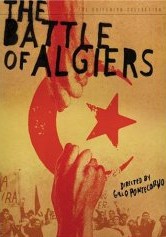 The Battle of Algiers (1967, 117 mins.)
The Battle of Algiers (1967, 117 mins.)
Argentina
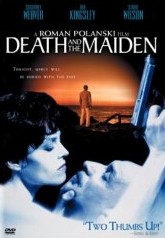 Death and the Maiden (1994, 103 mins.)
Death and the Maiden (1994, 103 mins.)
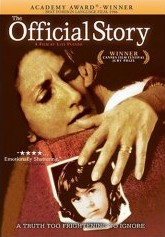 The Official Story (1985, 117 mins.)
The Official Story (1985, 117 mins.)
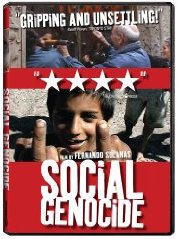 Social Genocide (documentary, 2004, 114 mins.)
Social Genocide (documentary, 2004, 114 mins.)
Armenian Genocide
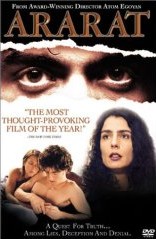 Ararat (2002, 115 mins.)
Ararat (2002, 115 mins.)
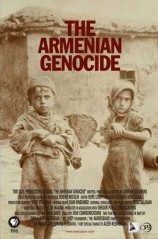 The Armenian Genocide (documentary, 2006, 60 mins.)
The Armenian Genocide (documentary, 2006, 60 mins.)
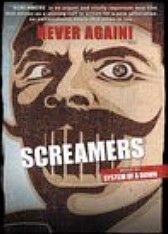 Screamers (documentary, 2006, 91 mins.)
Screamers (documentary, 2006, 91 mins.)
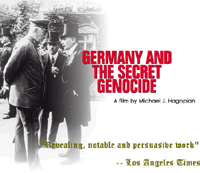 The Witnesses Trilogy (three-part documentary, 2004)
The Witnesses Trilogy (three-part documentary, 2004)
Bosnia & Herzegovina / War of Yugoslav Secession
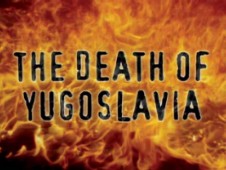 The Death of Yugoslavia (five-part BBC documentary, 2002)
The Death of Yugoslavia (five-part BBC documentary, 2002)
 Milosevic on Trial (2007, 120 mins.)
Milosevic on Trial (2007, 120 mins.)
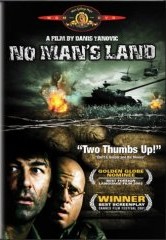 No Man's Land (2001, 94 mins.)
No Man's Land (2001, 94 mins.)
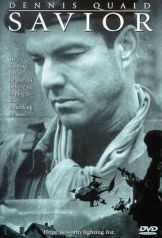 Savior (2001, 94 mins.)
Savior (2001, 94 mins.)
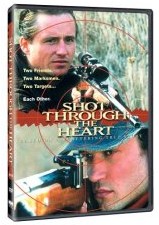 Shot Through the Heart (1998, 112 mins.)
Shot Through the Heart (1998, 112 mins.)
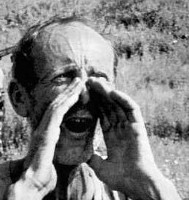 Srebrenica: A Cry from the Grave (documentary, 1999, 90 mins.)
Srebrenica: A Cry from the Grave (documentary, 1999, 90 mins.)
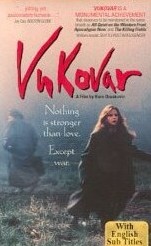 Vukovar (1994, 95 mins.)
Vukovar (1994, 95 mins.)
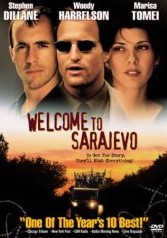 Welcome to Sarajevo (1997, 102 mins.)
Welcome to Sarajevo (1997, 102 mins.)
Burma
 Inside Burma: Land of Fear (documentary, 1997, 51 mins.)
Inside Burma: Land of Fear (documentary, 1997, 51 mins.)
Cambodia
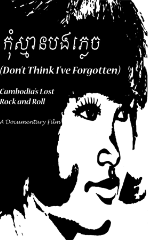 Don't Think I've Forgotten: Cambodia's Lost Rock and Roll (documentary, in progress)
Don't Think I've Forgotten: Cambodia's Lost Rock and Roll (documentary, in progress)
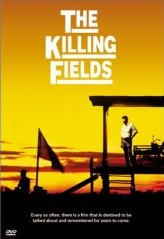 The Killing Fields (1984, 142 mins.)
The Killing Fields (1984, 142 mins.)
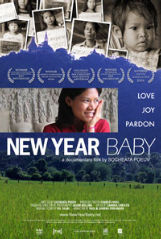 New Year Baby (documentary, 2006, 74 mins.)
New Year Baby (documentary, 2006, 74 mins.)
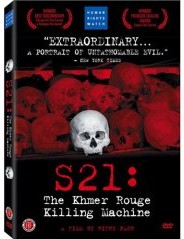 S21: The Khmer Rouge Killing Machine (documentary, 2002, 101 mins.)
S21: The Khmer Rouge Killing Machine (documentary, 2002, 101 mins.)
Chile
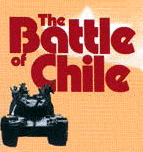 The Battle of Chile, Parts 1 & 2 (documentary, 1976, 184 mins.)
The Battle of Chile, Parts 1 & 2 (documentary, 1976, 184 mins.)
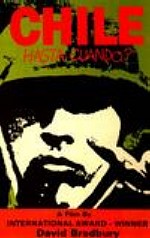 Chile: Hasta Cuando? (documentary, 1986, 73 mins.)
Chile: Hasta Cuando? (documentary, 1986, 73 mins.)
 Missing (1984, 123 mins.)
Missing (1984, 123 mins.)
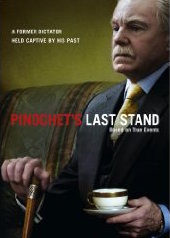 Pinochet's Last Stand (2006, 77 mins.)
Pinochet's Last Stand (2006, 77 mins.)
China / Tibet
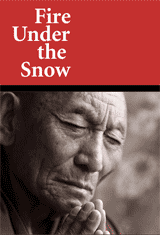 Fire Under the Snow (documentary, 1998, 88 mins.)
Fire Under the Snow (documentary, 1998, 88 mins.)
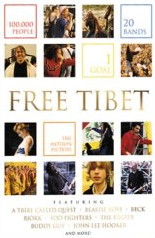 Free Tibet (documentary, 1998, 88 mins.)
Free Tibet (documentary, 1998, 88 mins.)
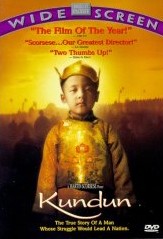 Kundun (1997, 135 mins.)
Kundun (1997, 135 mins.)
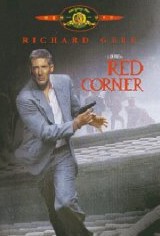 Red Corner (1997, 122 mins.)
Red Corner (1997, 122 mins.)
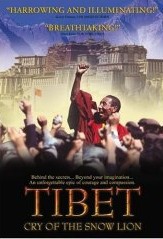 Tibet: Cry of the Snow Lion (documentary, 2003, 104 mins.)
Tibet: Cry of the Snow Lion (documentary, 2003, 104 mins.)
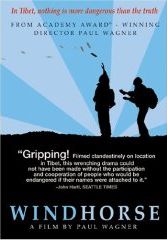 Windhorse (1998, 97 mins.)
Windhorse (1998, 97 mins.)
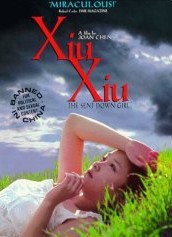 Xiu Xiu: The Sent Down Girl (1998, 99 mins.)
Xiu Xiu: The Sent Down Girl (1998, 99 mins.)
Congo
 Congo: White King, Red Rubber, Black Death (documentary, 2003, 90 mins.)
Congo: White King, Red Rubber, Black Death (documentary, 2003, 90 mins.)
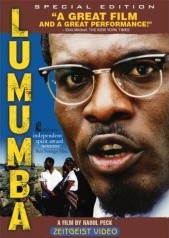 Lumumba (2001, 115 mins.)
Lumumba (2001, 115 mins.)
Darfur
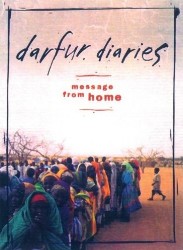 Darfur Diaries (2004, 55 mins.)
Darfur Diaries (2004, 55 mins.)
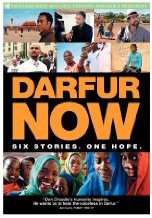 Darfur Now (2008, 98 mins.)
Darfur Now (2008, 98 mins.)
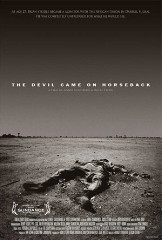 The Devil Came on Horseback (2007, 85 mins.)
The Devil Came on Horseback (2007, 85 mins.)
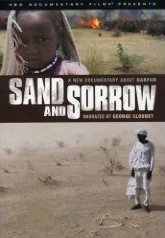 Sand and Sorrow (2007, 94 mins.)
Sand and Sorrow (2007, 94 mins.)
East Timor
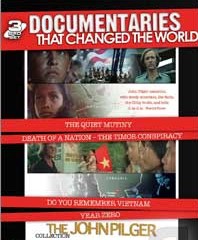 Death of a Nation: The Timor Conspiracy (documentary, 1994, 96 mins.)
Death of a Nation: The Timor Conspiracy (documentary, 1994, 96 mins.)
El Salvador
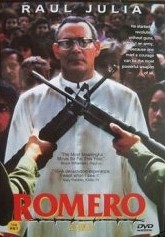 Romero (1989, 102 mins.)
Romero (1989, 102 mins.)
 Salvador (1986, 122 mins.)
Salvador (1986, 122 mins.)
First World War
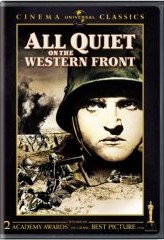 All Quiet on the Western Front (1932, 132 mins.)
All Quiet on the Western Front (1932, 132 mins.)
 The First World War: The Complete Series (2005, 503 mins.)
The First World War: The Complete Series (2005, 503 mins.)
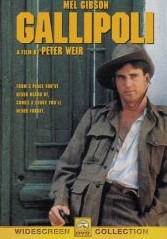 Gallipoli (1981, 111 mins.)
Gallipoli (1981, 111 mins.)
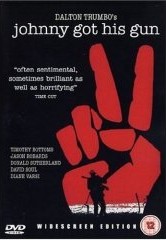 Johnny Got His Gun (1971)
Johnny Got His Gun (1971)
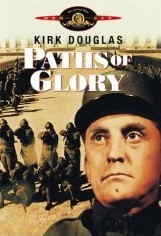 Paths of Glory (1957, 87 mins.)
Paths of Glory (1957, 87 mins.)
Genocide: General
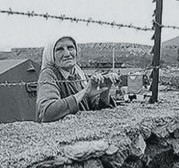 The Genocide Factor (documentary, 2001, 57 mins.)
The Genocide Factor (documentary, 2001, 57 mins.)
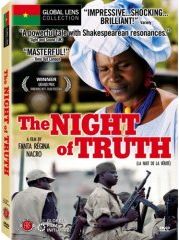 The Night of Truth (2004, 100 mins.)
The Night of Truth (2004, 100 mins.)
The "Genocidal Continuum"
Note: The anthropologist Nancy Scheper-Hughes defines the "genocidal continuum" as "the less dramatic, permitted, everyday acts of violence that make participation (under other conditions) in genocidal acts possible, perhaps more easy than we would like to know." She places special emphasis on practices in institutions like schools, prisons, and hospitals. In this catch-call category, I list works that address these more quotidian and institutional forms of violence, including those born of racism, sexism, and imperialism; and dystopian "science fiction" films exploring the dark side of humanity and society.
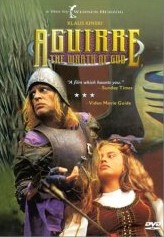 Aguirre, The Wrath of God (1974, 94 mins.)
Aguirre, The Wrath of God (1974, 94 mins.)
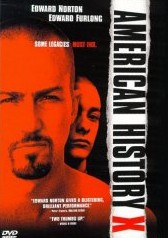 American History X (1998, 119 mins.)
American History X (1998, 119 mins.)
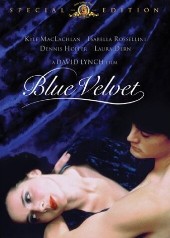 Blue Velvet (1986, 121 mins.)
Blue Velvet (1986, 121 mins.)
 Brazil (1985, 142 mins.)
Brazil (1985, 142 mins.)
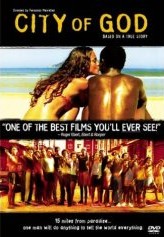 City of God (2002, 130 mins.)
City of God (2002, 130 mins.)
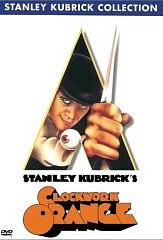 A Clockwork Orange (1972, 137 mins.)
A Clockwork Orange (1972, 137 mins.)
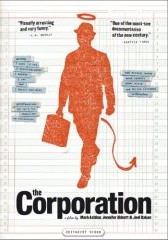 The Corporation (documentary, 2004, 145 mins.)
The Corporation (documentary, 2004, 145 mins.)
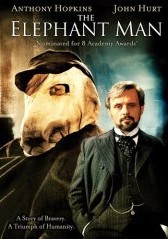 The Elephant Man (1980, 123 mins.)
The Elephant Man (1980, 123 mins.)
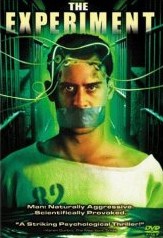 The Experiment (2001, 120 mins.)
The Experiment (2001, 120 mins.)
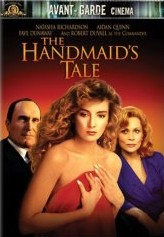 The Handmaid's Tale (1990, 109 mins.)
The Handmaid's Tale (1990, 109 mins.)
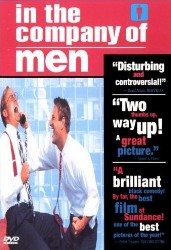 In the Company of Men (1997, 97 mins.)
In the Company of Men (1997, 97 mins.)
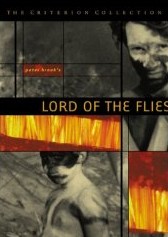 Lord of the Flies (1963, 90 mins.)
Lord of the Flies (1963, 90 mins.)
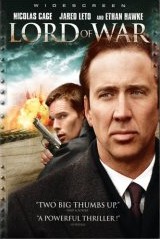 Lord of War (2005, 121 mins.)
Lord of War (2005, 121 mins.)
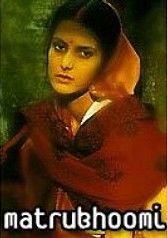 Matrubhoomi (Motherland) (2003, 99 mins.)
Matrubhoomi (Motherland) (2003, 99 mins.)
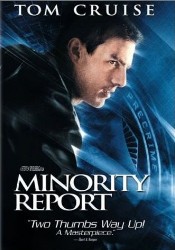 Minority Report (2002, 146 mins.)
Minority Report (2002, 146 mins.)
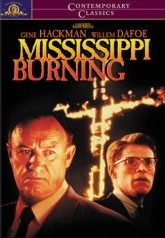 Mississippi Burning (1989, 127 mins.)
Mississippi Burning (1989, 127 mins.)
 Monster (2004, 108 mins.)
Monster (2004, 108 mins.)
 1984 (1984, 110 mins.)
1984 (1984, 110 mins.)
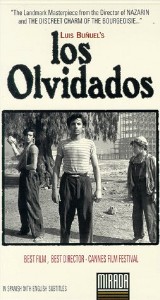 Los Olvidados (1950, 90 mins.)
Los Olvidados (1950, 90 mins.)
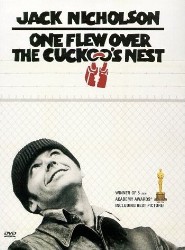 One Flew over the Cuckoo's Nest (1975, 133 mins.)
One Flew over the Cuckoo's Nest (1975, 133 mins.)
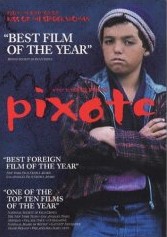 Pixote (1981, 127 mins.)
Pixote (1981, 127 mins.)
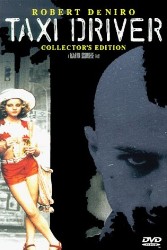 Taxi Driver (1976, 128 mins.)
Taxi Driver (1976, 128 mins.)
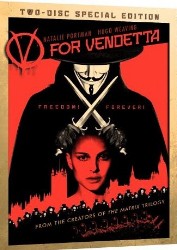 V for Vendetta (2006, 133 mins.)
V for Vendetta (2006, 133 mins.)
India
 Earth (1998, 101 mins.)
Earth (1998, 101 mins.)
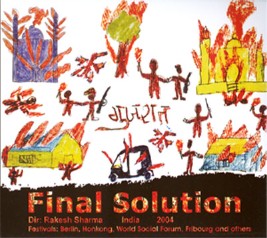 Final Solution (2003, 218 mins.)
Final Solution (2003, 218 mins.)
Indigenous Peoples: Africa and Australasia
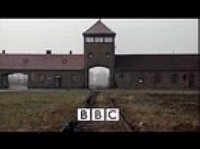 Namibia: Genocide and the Second Reich (2004, 59 mins.)
Namibia: Genocide and the Second Reich (2004, 59 mins.)
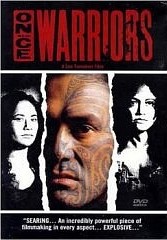 Once Were Warriors (1994, 105 mins.)
Once Were Warriors (1994, 105 mins.)
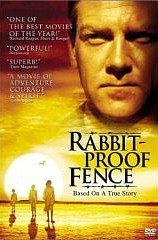 Rabbit-Proof Fence (2002, 93 mins.)
Rabbit-Proof Fence (2002, 93 mins.)
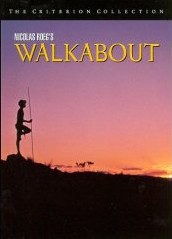 Walkabout (1971, 100 mins.)
Walkabout (1971, 100 mins.)
Indigenous Peoples: Central and South America
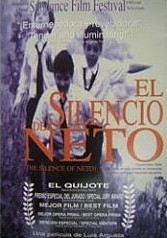 El Silencio de Neto (The Silence of Neto) (1994, 108 mins.)
El Silencio de Neto (The Silence of Neto) (1994, 108 mins.)
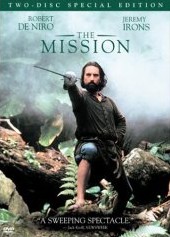 The Mission (1986, 125 mins.)
The Mission (1986, 125 mins.)
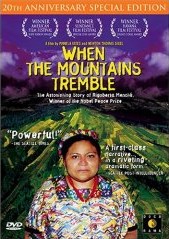 When the Mountains Tremble (documentary, 1983, 90 mins.)
When the Mountains Tremble (documentary, 1983, 90 mins.)
Indigenous Peoples: North America
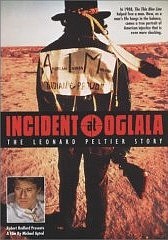 Incident at Oglala: The Leonard Peltier Story (documentary, 1992, 90 mins.)
Incident at Oglala: The Leonard Peltier Story (documentary, 1992, 90 mins.)
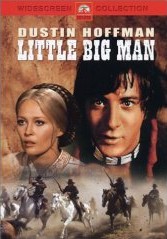 Little Big Man (1970, 139 mins.)
Little Big Man (1970, 139 mins.)
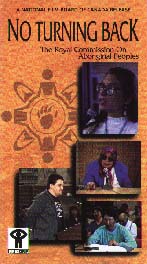 No Turning Back: The Royal Commission on Aboriginal Peoples (documentary, 1996, 47 mins.)
No Turning Back: The Royal Commission on Aboriginal Peoples (documentary, 1996, 47 mins.)
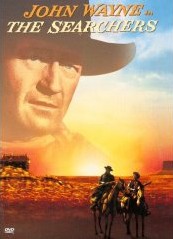 The Searchers (1956, 119 mins.)
The Searchers (1956, 119 mins.)
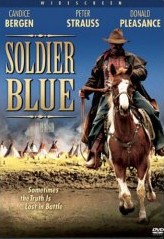 Soldier Blue (1970, 115 mins.)
Soldier Blue (1970, 115 mins.)
Iraq
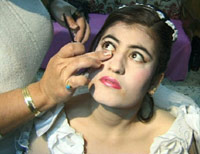 In the Name of Honour (documentary, 2000, 24 mins.)
In the Name of Honour (documentary, 2000, 24 mins.)
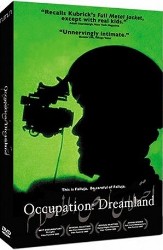 Occupation: Dreamland (documentary, 2005, 140 mins.)
Occupation: Dreamland (documentary, 2005, 140 mins.)
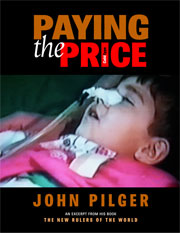 Paying the Price: Killing the Children of Iraq (documentary, 2000, 74 mins.)
Paying the Price: Killing the Children of Iraq (documentary, 2000, 74 mins.)
Israel / Palestine
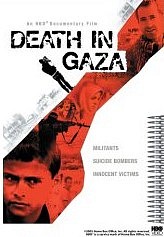 Death in Gaza (documentary, 2003, 80 mins.)
Death in Gaza (documentary, 2003, 80 mins.)
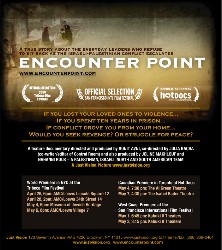 Encounter Point (documentary, 2006, 85 mins.)
Encounter Point (documentary, 2006, 85 mins.)
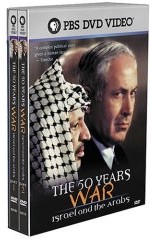 The 50 Years War: Israel & the Arabs (documentary, 2000, 300 mins.)
The 50 Years War: Israel & the Arabs (documentary, 2000, 300 mins.)
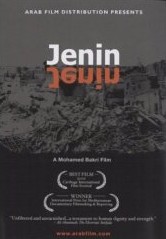 Jenin Jenin (documentary, 2002, 54 mins.)
Jenin Jenin (documentary, 2002, 54 mins.)
 Munich (2006, 164 mins.)
Munich (2006, 164 mins.)
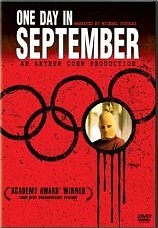 One Day in September (documentary, 1999, 94 mins.)
One Day in September (documentary, 1999, 94 mins.)
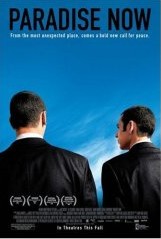 Paradise Now (2005, 91 mins.)
Paradise Now (2005, 91 mins.)
 Wall (documentary, 2005, 96 mins.)
Wall (documentary, 2005, 96 mins.)
Jewish Holocaust / Nazism
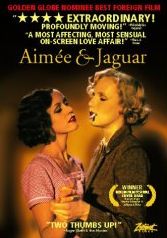 Aimée & Jaguar (1999, 125 mins.)
Aimée & Jaguar (1999, 125 mins.)
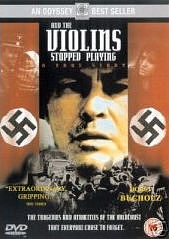 And the Violins Stopped Playing (1988, 128 mins.)
And the Violins Stopped Playing (1988, 128 mins.)
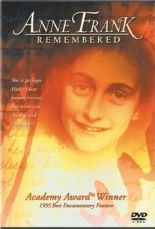 Anne Frank Remembered (documentary, 1995, 117 mins.)
Anne Frank Remembered (documentary, 1995, 117 mins.)
 Auschwitz: Inside the Nazi State (documentary, 2005, 300 mins.)
Auschwitz: Inside the Nazi State (documentary, 2005, 300 mins.)
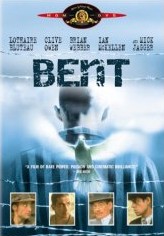 Bent (1997, 104 mins.)
Bent (1997, 104 mins.)
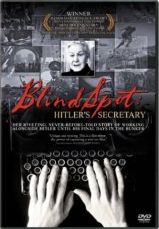 Blind Spot - Hitler's Secretary (documentary, 2002, 87 mins.)
Blind Spot - Hitler's Secretary (documentary, 2002, 87 mins.)
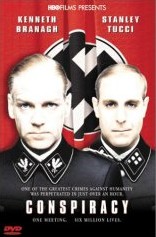 Conspiracy (2001, 96 mins.)
Conspiracy (2001, 96 mins.)
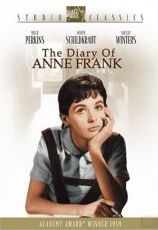 The Diary of Anne Frank (1959, 180 mins.)
The Diary of Anne Frank (1959, 180 mins.)
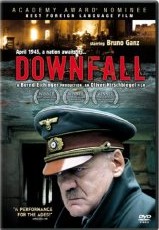 Downfall (2004, 155 mins.)
Downfall (2004, 155 mins.)
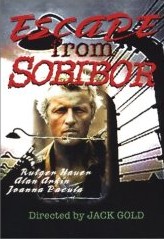 Escape from Sobibor (1987, 119 mins.)
Escape from Sobibor (1987, 119 mins.)
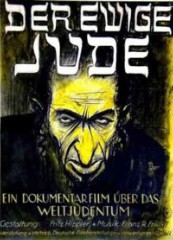 The Eternal Jew (Der ewige Jude) ("documentary," 1940, 62 mins.)
The Eternal Jew (Der ewige Jude) ("documentary," 1940, 62 mins.)
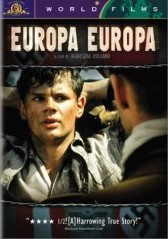 Europa Europa (1990, 113 mins.)
Europa Europa (1990, 113 mins.)
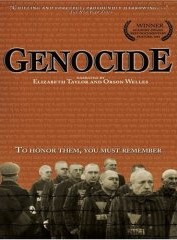 Genocide (documentary, 1981, 83 mins.)
Genocide (documentary, 1981, 83 mins.)
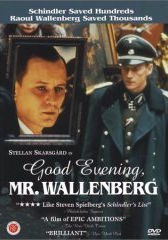 Good Evening Mr. Wallenberg (1990, 115 mins.)
Good Evening Mr. Wallenberg (1990, 115 mins.)
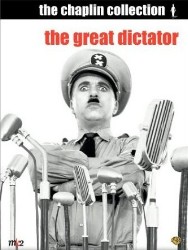 The Great Dictator (1940, 126 mins.)
The Great Dictator (1940, 126 mins.)
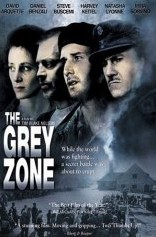 The Grey Zone (2001, 108 mins.)
The Grey Zone (2001, 108 mins.)
 Holocaust (Miniseries) (1978, 408 mins.)
Holocaust (Miniseries) (1978, 408 mins.)
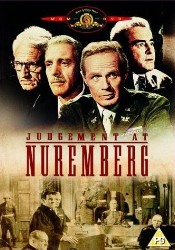 Judgment at Nuremberg (1961, 186 mins.)
Judgment at Nuremberg (1961, 186 mins.)
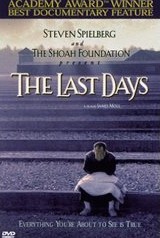 The Last Days (documentary, 1998, 87 mins.)
The Last Days (documentary, 1998, 87 mins.)
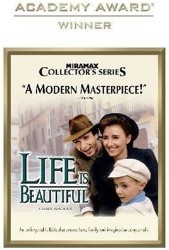 Life is Beautiful (1998, 116 mins.)
Life is Beautiful (1998, 116 mins.)
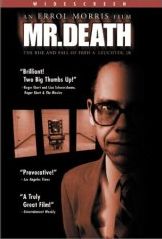 Mr. Death: The Rise & Fall of Fred A. Leuchter Jr. (documentary, 2000, 90 mins.)
Mr. Death: The Rise & Fall of Fred A. Leuchter Jr. (documentary, 2000, 90 mins.)
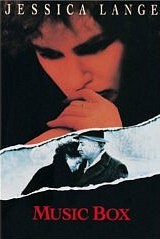 Music Box (1990, 126 mins.)
Music Box (1990, 126 mins.)
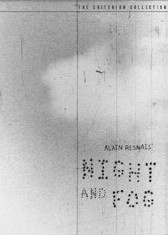 Night and Fog (documentary, 1955, 31 mins.)
Night and Fog (documentary, 1955, 31 mins.)
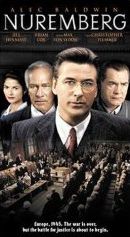 Nuremberg (2001, 180 mins.)
Nuremberg (2001, 180 mins.)
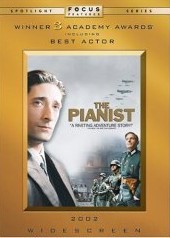 The Pianist (2002, 150 mins.)
The Pianist (2002, 150 mins.)
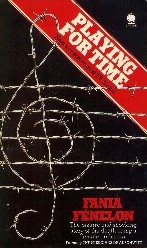 Playing for Time (1980, 150 mins.)
Playing for Time (1980, 150 mins.)
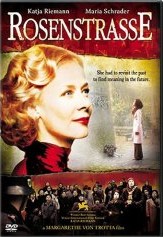 Rosenstrasse (2003, 136 mins.)
Rosenstrasse (2003, 136 mins.)
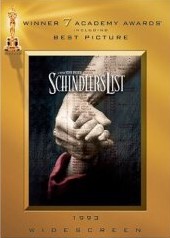 Schindler's List (1993, 196 mins.)
Schindler's List (1993, 196 mins.)
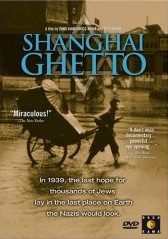 Shanghai Ghetto (documentary, 2002, 95 mins.)
Shanghai Ghetto (documentary, 2002, 95 mins.)
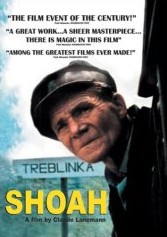 Shoah (documentary, 1985, 563 mins.)
Shoah (documentary, 1985, 563 mins.)
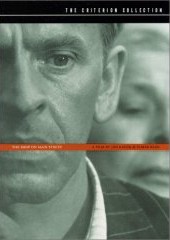 The Shop on Main Street (1966, 125 mins.)
The Shop on Main Street (1966, 125 mins.)
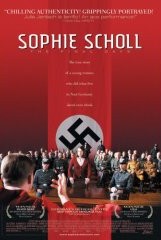 Sophie Scholl: The Final Days (2005, 117 mins.)
Sophie Scholl: The Final Days (2005, 117 mins.)
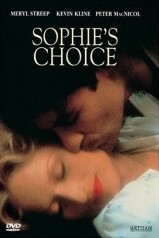 Sophie's Choice (1982, 150 mins.)
Sophie's Choice (1982, 150 mins.)
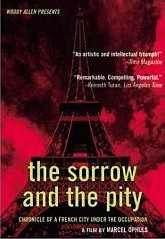 The Sorrow and the Pity (documentary, 1972, 260 mins.)
The Sorrow and the Pity (documentary, 1972, 260 mins.)
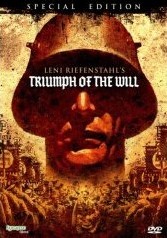 Triumph of the Will (documentary, 1934, 120 mins.)
Triumph of the Will (documentary, 1934, 120 mins.)
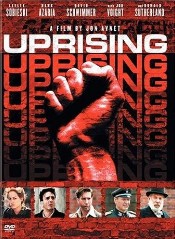 Uprising (2001, 210 mins.)
Uprising (2001, 210 mins.)
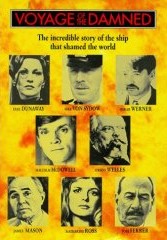 Voyage of the Damned (1976, 134 mins.)
Voyage of the Damned (1976, 134 mins.)
Nuclear War
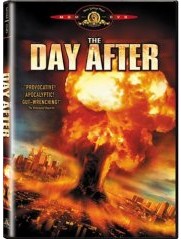 The Day After (1983, 126 mins.)
The Day After (1983, 126 mins.)
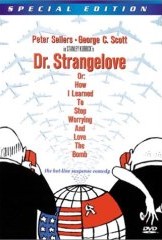 Dr. Strangelove, or: How I Learned to Stop Worrying and Love the Bomb (1964, 93 mins.)
Dr. Strangelove, or: How I Learned to Stop Worrying and Love the Bomb (1964, 93 mins.)
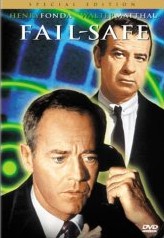 Fail-Safe (1964, 111 mins.)
Fail-Safe (1964, 111 mins.)
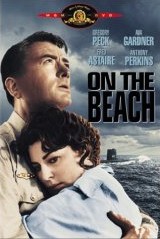 On the Beach (1959, 134 mins.)
On the Beach (1959, 134 mins.)
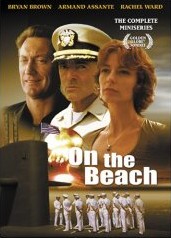 On the Beach (2000, 209 mins.)
On the Beach (2000, 209 mins.)
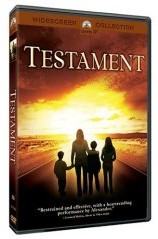 Testament (1983, 89 mins.)
Testament (1983, 89 mins.)
 Threads (1984, 110 mins.)
Threads (1984, 110 mins.)
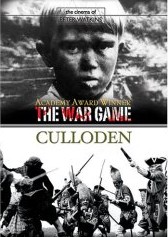 The War Game (1968, 50 mins.)
The War Game (1968, 50 mins.)
Rwanda
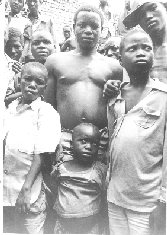 Chronicle of a Genocide Foretold (documentary, 1996, 141 mins.)
Chronicle of a Genocide Foretold (documentary, 1996, 141 mins.)
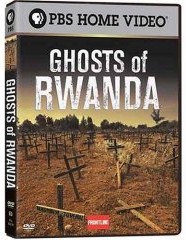 Frontline: Ghosts of Rwanda (documentary, 2004, 120 mins.)
Frontline: Ghosts of Rwanda (documentary, 2004, 120 mins.)
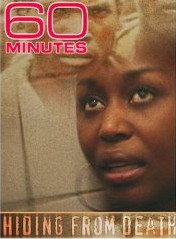 Hiding from Death (documentary, 2006, 13 mins.)
Hiding from Death (documentary, 2006, 13 mins.)
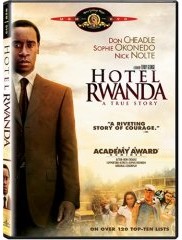 Hotel Rwanda (2005, 122 mins.)
Hotel Rwanda (2005, 122 mins.)
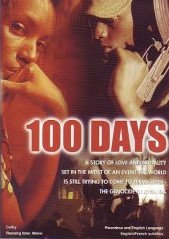 100 Days (2001, 96 mins.)
100 Days (2001, 96 mins.)
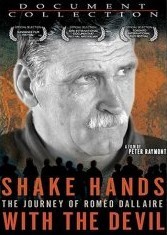 Shake Hands with the Devil (documentary, 2004, 90 mins.)
Shake Hands with the Devil (documentary, 2004, 90 mins.)
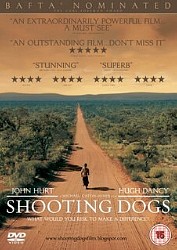 Shooting Dogs (2005, 115 mins.)
Shooting Dogs (2005, 115 mins.)
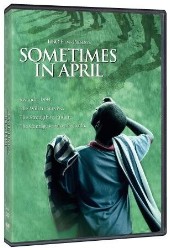 Sometimes in April (2005, 140 mins.)
Sometimes in April (2005, 140 mins.)
Second World War
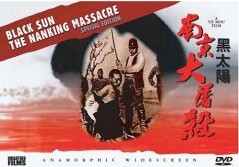 Black Sun (1995, 120 mins.)
Black Sun (1995, 120 mins.)
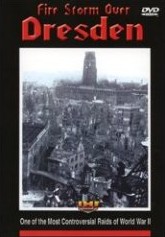 Firestorm over Dresden (documentary, 1990, 77 mins.)
Firestorm over Dresden (documentary, 1990, 77 mins.)
 Hiroshima (1995, 186 mins.)
Hiroshima (1995, 186 mins.)
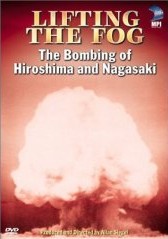 Lifting the Fog: The Bombing of Hiroshima and Nagasaki (documentary, 1991, 60 mins.)
Lifting the Fog: The Bombing of Hiroshima and Nagasaki (documentary, 1991, 60 mins.)
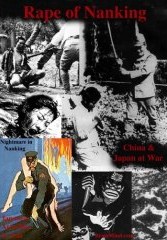 Rape of Nanking: China & Japan At War (documentary, 2005, 77 mins.)
Rape of Nanking: China & Japan At War (documentary, 2005, 77 mins.)
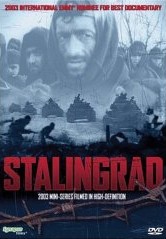 Stalingrad (documentary, 2003, 165 mins.)
Stalingrad (documentary, 2003, 165 mins.)
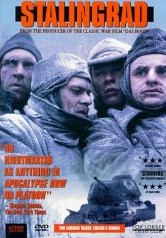 Stalingrad (1992, 150 mins.)
Stalingrad (1992, 150 mins.)
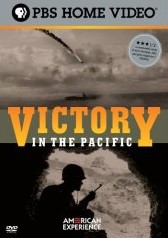 Victory in the Pacific (American Experience) (documentary, 1995, 120 min.)
Victory in the Pacific (American Experience) (documentary, 1995, 120 min.)
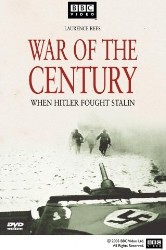 War of the Century: When Hitler Fought Stalin (documentary, 2005, 200 mins.)
War of the Century: When Hitler Fought Stalin (documentary, 2005, 200 mins.)
Slavery
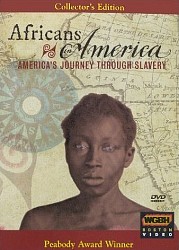 Africans in America (documentary, 1998, 360 mins.)
Africans in America (documentary, 1998, 360 mins.)
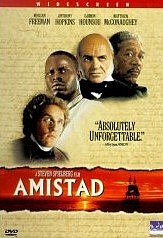 Amistad (1997, 155 mins.)
Amistad (1997, 155 mins.)
 Burn! (1970, 112 mins.)
Burn! (1970, 112 mins.)
 Roots (1997, 563 mins.)
Roots (1997, 563 mins.)
 Slavery and the Making of America (documentary, 2005, 240 mins.)
Slavery and the Making of America (documentary, 2005, 240 mins.)
South Africa
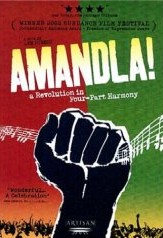 Amandla! A Revolution in Four-Part Harmony (documentary, 2002, 103 mins.)
Amandla! A Revolution in Four-Part Harmony (documentary, 2002, 103 mins.)
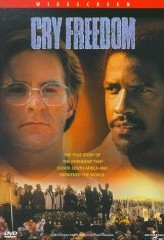 Cry Freedom (1987, 157 mins.)
Cry Freedom (1987, 157 mins.)
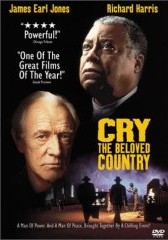 Cry, The Beloved Country (1995, 120 mins.)
Cry, The Beloved Country (1995, 120 mins.)
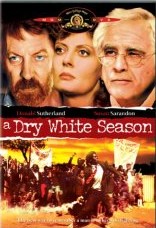 A Dry White Season (1989, 107 mins.)
A Dry White Season (1989, 107 mins.)
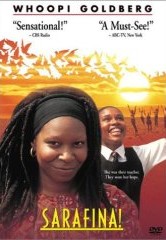 Sarafina! (1992, 98 mins.)
Sarafina! (1992, 98 mins.)
Soviet Union
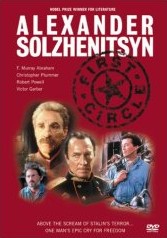 Alexander Solzhenitsyn's First Circle (1989, 181 mins.)
Alexander Solzhenitsyn's First Circle (1989, 181 mins.)
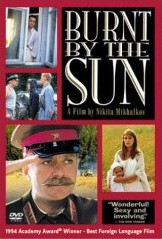 Burnt by the Sun (1995, 134 mins.)
Burnt by the Sun (1995, 134 mins.)
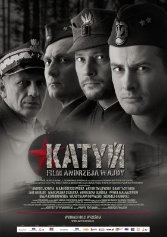 Katyn (2007, 118 mins.)
Katyn (2007, 118 mins.)
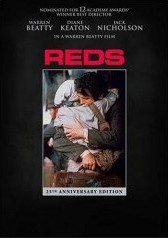 Reds (1981, 195 mins.)
Reds (1981, 195 mins.)
Sudan
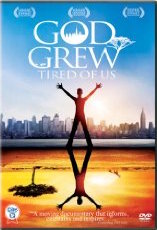 God Grew Tired of Us (2005, 90 mins.)
God Grew Tired of Us (2005, 90 mins.)
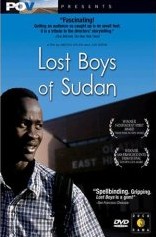 POV: Lost Boys of Sudan (documentary, 2003, 87 mins.)
POV: Lost Boys of Sudan (documentary, 2003, 87 mins.)
Uganda
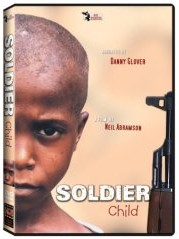 Soldier Child (documentary, 2005, 55 mins.)
Soldier Child (documentary, 2005, 55 mins.)
Vietnam War
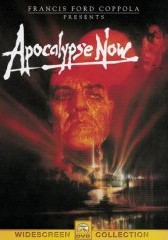 Apocalypse Now (1979, 202 mins.)
Apocalypse Now (1979, 202 mins.)
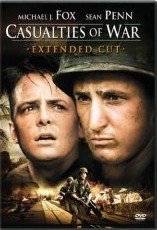 Casualties of War (1989, 119 mins.)
Casualties of War (1989, 119 mins.)
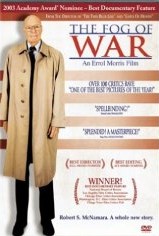 The Fog of War (documentary, 2004, 107 mins.)
The Fog of War (documentary, 2004, 107 mins.)
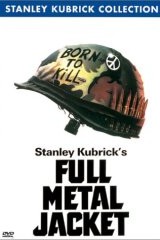 Full Metal Jacket (1987, 117 mins.)
Full Metal Jacket (1987, 117 mins.)
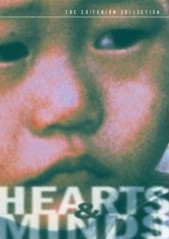 Hearts and Minds (documentary, 1974, 112 mins.)
Hearts and Minds (documentary, 1974, 112 mins.)
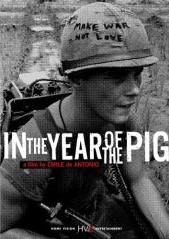 In the Year of the Pig (documentary, 1969, 103 mins.)
In the Year of the Pig (documentary, 1969, 103 mins.)
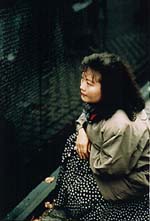 Kim's Story (documentary, 1996, 48 mins.)
Kim's Story (documentary, 1996, 48 mins.)
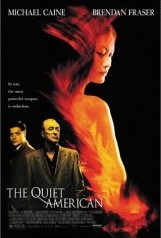 The Quiet American (2002, 101 mins.)
The Quiet American (2002, 101 mins.)
